




Hello, and welcome to the latest edition of The Brewers Journal! So that was summer then, I suppose? The weather was…indifferent but the same can’t be said for the frankly brilliant beers poured at the wealth of excellent beer festivals we were blessed with over those socalled summer months. I hope they were a productive and fruitful experience for all of you.
Here at The Brewers Journal we’ve been incredibly busy, too. In addition to our magazine and podcast we have launched our new video interview series. We’ve also hosted our Brewers Lectures in Leeds, Nottingham, Bristol and, most recently, Newcastle.
And as I always explain during those events, in what’s obviously a challenging time for beer, brewing and, of course wider hospitality, I feel that being able to meet up, enjoy each other’s company and celebrate all of the fantastic work taking place in this sector is truly important.
And when we talk about the fantastic work happening in beer, we look forward to doing that once more at our upcoming Brewers Congress in London! It’s taking place on the 18th and the 19th October at The Business Design Centre in Islington. As you’ll see in this edition of the magazine, we have two days of talks, trade exhibits and excellent beer. So I want to say a huge thank you to our speakers, panellists, everyone planning to attend this year, as well as the wealth of best-inclass exhibitors and also our sponsors.
A central part of this event is, of course, our Brewers Choice Awards. It’s our annual celebration of the brilliant talent this industry boasts. At the end of the summer, judges from across the brewing spectrum once again converged on The Red Lion in Barnes, London, to debate and discuss the excellent entries submitted for the 2023 iteration of the awards. The winners of which, will be crowned in London this October with tickets available online. The categories up for discussion were Young Brewer of The Year, Brewer of The Year, New Brewery of The Year, Brewery of The Year, New Beer of The Year, Beer of The Year, Branding of The Year, Lifetime Achievement and Global Ambassador.
You can read more about those excellent brewers and breweries in our shortlist spreads in this edition, with the winners announced on the evening of the 18th October. Best of luck to all involved!
You can rely on us to continue to champion the fantastic brewing industry and all related to it. Our eyes and ears are always open for how we can better serve this unsurpassable sector.
I hope you all have a fantastic autumn and a successful second half of 2023. Thanks again and best of luck in all that you do.
Tim Sheahan Editor

Comment | Alcohol duties and tax
Dan Finn — corporate solicitor and lead of Brabners’ specialist breweries and beverages team — sets out the new rates and what sole traders and limited companies need to know.
Comment | Greener brewing
For breweries looking to the future, there are wealth of issues to consider when it comes to energy usage, explains George Webb, Liquid Gas UK’s CEO.
Comment | Labelling

Great beer, great branding and great packaging make for a great trio. here vale labels offer some advice on how to ensure your beer looks the part on the shelf.


Dear John
Fuller’s Vintage Ale is a special beer for many, and John Keeling is no exception. recently he had the opportunity to take this revered beverage on the road for a number of tastings across the UK. This is how he got on.
Brewers Intelligence | Autumn
The latest insights from the world of hops, malt, sales and yeast.
Brewers Congress 2023
All you need to know about this year’s event from the leading speakers and panelists, to the bestin-class exhibitors and the brilliant talent on the shortlist of our 2023 Brewers Choice Awards.
Homebrewing
Alex Redpath, the head brewer at Full Circle shares his homebrewing story and also a treasured recipe, too.
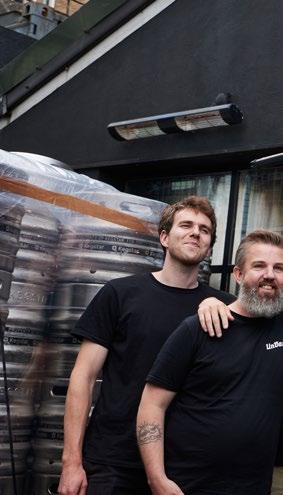
78
Technology | Canning
The products and services available that can help you kick-start your canning journey.
83
62
The Future of Craft Beer As craft transitions from high growth to saturation, the key to success is to double down on what makes your brand, and craft, special, argues Luca Lorenzoni.
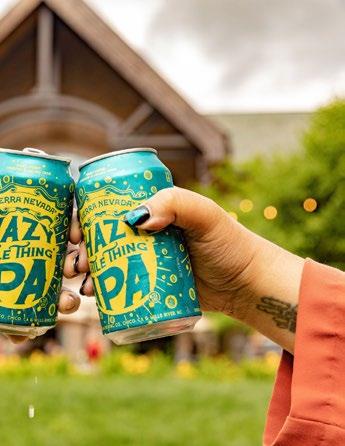
Tim Sheahan Editor tim@reby.media
+44 (0)1442 780 592
Melissa Cole Contributing Editor
Tim O’Rourke Technical Editor
John Keeling Contributor
Josh Henderson Head of sales josh@reby.media
+44 (0)1442 780 594
Jon Young Publisher jon@reby.media
Reby Media 6 Grove Road, Hemel Hempstead, Herts, HP1 1NG
The Brewers Journal is a published four times a year and mailed every March, June, September & December. Subscriptions can be purchased for four issues. Prices for single issue subscriptions or back issues can be obtained by emailing: subscribe@ reby.media
UK & IRELAND £29 INTERNATIONAL £49

The content of The Brewers Journal is subject to copyright. However, if you would like to obtain copies of an article for marketing purposes high-quality reprints can be supplied to your specification. Please contact the advertising team for full details of this service. The Brewers Journal is printed at Manson Group, St Albans, UK.
67
Meet The Brewer | UnBarred UnBarred Brewery of Brighton, on living to inspire discovery through boundless creativity.

All rights reserved. No part of this publication may be reproduced or transmitted in any form or by any means, electronic or mechanical, including photocopying, recording or any information storage or retrieval system, without the express prior written consent of the publisher. The Brewers Journal ISSN 2059-6650 is published bimonthly by Reby Media, 6 Grove Road, Hemel Hempstead, Hertfordshire, HP1 1NG. Subscription records are maintained at Reby Media, 6 Grove Road, Hemel Hempstead, Hertfordshire, HP1 1NG.
The Brewers Journal accepts no responsibility for the accuracy of statements or opinion given within the Journal that is not the expressly designated opinion of the Journal or its publishers. Those opinions expressed in areas other than editorial comment may not be taken as being the opinion of the Journal or its staff, and the aforementioned accept no responsibility or liability for actions that arise therefrom.
The Beer of Barcelona Paul Davies us on a comprehensive tour of the Catalan capital.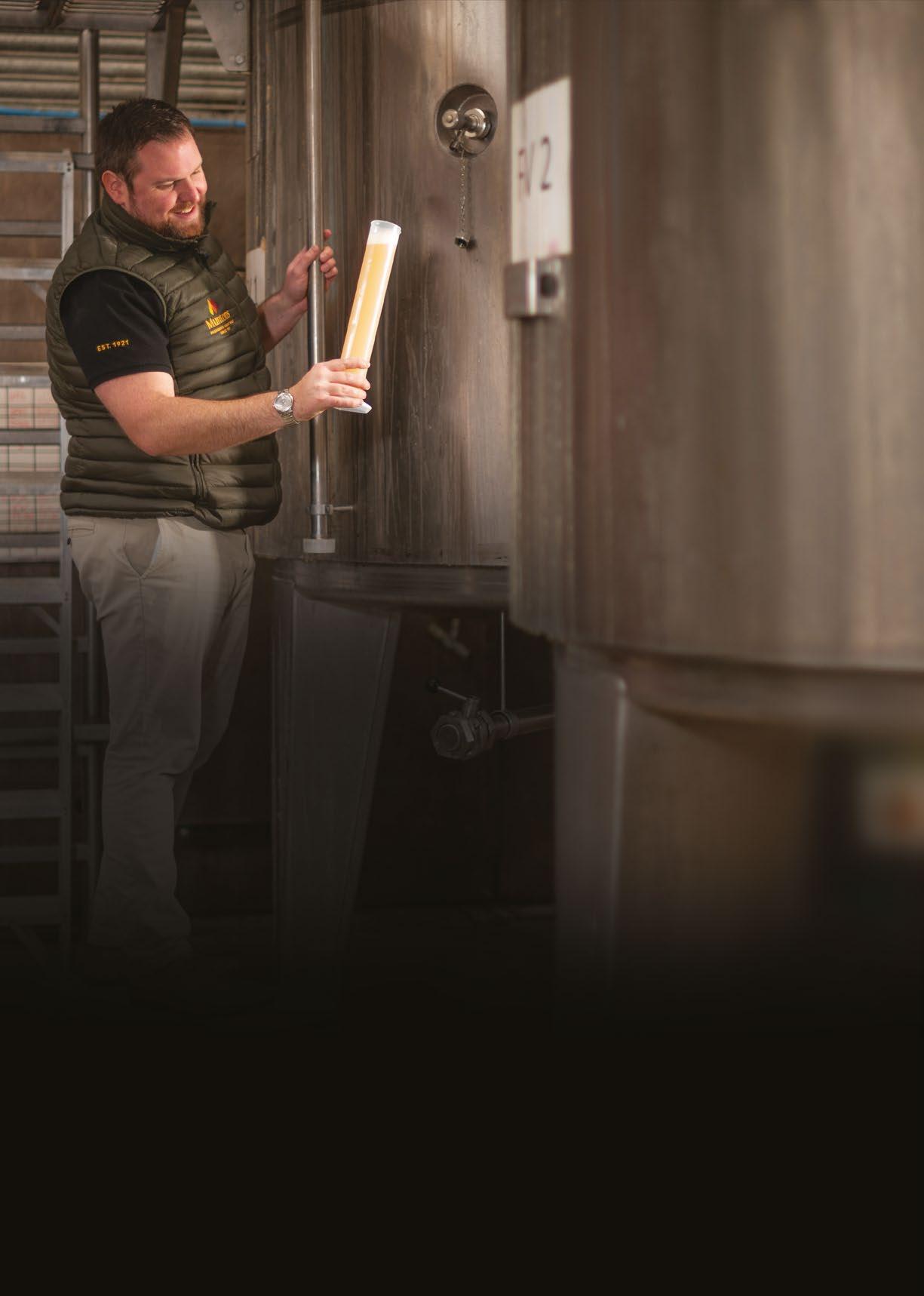
What do we do about the fact that so many of our historic brands are in foreign hands?
Don’t get me wrong, I don’t mean this in a jingoistic way, it’s simply that cask and real ale brands are mostly anathema to the majority of the rest of the world, and that means we’re losing important parts of our brewing heritage, as a result of them falling into foreign hands, says Melissa Cole.
For over four years now, I’ve been asking questions about Worthington White Shield and have been met with a wall of silence, so the latest ‘pause’ surprises me not at all, but it does upset me; brands like White Shield are a living part of our history, even if it’s attached to the fairly ugly colonial bit, and are something to be treasured and celebrated, not sold off wholesale to the highest bidder. As someone who is firmly caught in the capitalist cycle, I am not stupid enough to think that these things don’t happen, but if we are to learn anything from the current state of our waterways, power suppliers and railways, if the things that are important stay in our hands, we can control them, if it stays down to shareholders with no emotional or historical stake in them, we are in trouble.
The big takeovers of Bass and Whitbread happened almost right at the beginning of my career, and my then mentor, Mike Bennett (who broke the Bass story before even the nationals got hold of it), was sounding the alarm about the inevitable running down of traditional brands that may have been sitting slightly on the margins at the time, but perhaps what even he couldn’t have foreseen was the wholesale destruction of popular and profitable brands within such a short timeframe.
To be clear, this isn’t taking aim at just Molson Coors, ABI managed to destroy Boddington’s in next to no time (please don’t talk to about what it is they serve in America, it remains one of the most depressing beers I’ve ever drunk), and holds in its hands other historic brand IP like Mackeson Stout, Flowers Best Bitter and Flowers IPA, along with goodness knows what else, it’s pretty hard to find out - and that in itself is simply ridiculous.
Not to mention the fact that the stranglehold they have in tied houses and with contracts elsewhere, has undoubtedly contributed to the demise of cask ale in the UK, why waste time training people on a ‘living organism in the cellar’ when you can just sell them something that’s significantly more ‘plug and play’.
All of this said, I do have some hope about the White Shield situation, as Molson Coors does have a history of outsourcing production of brands like Stones Bitter but if there wasn’t such an outcry, would they even bother? I’m sure their shareholders wish they wouldn’t.
And whilst I wouldn’t be stupid enough to say that I have all the answers, what I do know is we can’t just sit back and wring our hands about this niche form of cultural vandalism, we have to make loud and prolonged noise about it, or we’ll be kissing, or perhaps sipping, them goodbye.
Anglia Maltings Holdings (AMH), of which Crisp Malt is part, has announced its commitment to Net Zero by 2045 and has launched our inaugural Sustainability Report.
The report outlines their Sustainability Strategy, which is guided by the UN Sustainability Development Goals and by the company purpose and values. It lays out the goals for AMH’s three businesses – maltsters, Crisp Malt; food ingredient producers, EDME; and cereal processors, Micronized Food Products – and the plans for achieving them.
Significant inroads have already been made. Electricity across the company’s UK sites is from 100% renewable sources. The adoption of best techniques, including heat exchangers and CHP (combined heat and power) systems, ensures that CO2 emissions are minimised. There is very little waste. Co-products from processing, for example, go to animal feed. Plus, the location of Crisp’s UK sites in the heart of the country’s best cereal growing regions, ensures the minimalisation of HGV food miles.
On premise drinks sales bounced back into year-on-year growth last week— ending a run of five weeks of negative numbers.
CGA by NIQ’s Daily Drinks Tracker shows average sales in managed venues in the week to Saturday (19 August) were 5% ahead of the same period last year. The return to growth follows a challenging late July and early August, when cool weather kept many consumers away from pubs’ beer gardens and terraces. However, trading improved in line with the temperatures last week. There was a particular surge in sales in midweek, with Tuesday (up 10%), Wednesday, which was boosted by England’s semi-final victory over Australia (up 17%), and Thursday (up 15%) all in double-digit growth—but trading was more modest on Friday (down 3%) and Saturday (up 4%) as rain moved back in.
Warmer weather lifted the beer category, where sales rose 10% year-on-year. Wine (up 9%) and cider (up 1%) were also posi-
tive, but soft drinks (down 2%) and spirits (down 4%) were both negative.
Award-winning North London based Hammerton Brewery is launching its popular core range Nitro Stout favourite TINT in cans using Widget technology. Last year Hammerton released their Nitro Dry Stout on draught and it quickly became their biggest selling stout and moved into their core range. Since that time they have heavily invested in research and development to expand their knowledge and capabilities with Nitrogen technology by investing in a liquid nitrogen tank and nitrogen doser for their canning line and have been carrying out R&D using widget cans for the last 12 months. They are now believed to be the first English brewery to can a Stout using widget cans.
Co founder Lee Hammerton said: “Myself and our brewers, have always enjoyed being innovative and trying new and challenging projects when it comes to brewing beer.
“Due to the popularity of TINT, our Nitro stout and a long term ambition to be able to produce a Nitro Beer in can using Widget technology we decided that we would try and achieve the ambitious task of being able to put our much loved dry stout in widget cans.”
Timothy Taylor’s chose to work with Thornbridge for the first collaboration beer in their 165-year history to create Artesian, a refreshing Elderflower and Gooseberry Pale Ale, ideal for summer refreshment.
The two breweries have long admired each other’s approach to cask and craft beer respectively, with Landlord and Jaipur both being widely regarded as the pioneers within their respective categories, and both having won more awards than any other beers.
The brewers’ mutual knowledge and passion led them to brew a style of beer that could be showcased in the more traditional cask format for pubs, but also enjoyed in keg format in bars and
restaurants and from cans at home. The Artesian collaboration with Thornbridge comes just five months after Timothy Taylor’s Hopical Storm became its first beer to be launched in can.
The total number of breweries in the UK has risen in the second quarter of 2023 according to new figures released. The latest data from the SIBA UK Brewery Tracker covering the period from the start of April 2023 to the end of June 2023, shows the net brewery number across the UK grew slightly (by two) over that three-month period.
“Seeing the net brewery number rise across the UK is not only a sign that confidence in the sector remains, but that the demand for quality locally made beer continues to rise.
“However there has been a significant number of brewery closures and change of ownership, with some consolidation and buyouts alongside new businesses opening. So whilst modest growth is ahead of expectations and common perception, it’s not quite the overly positive picture that the headline figures paint,” said Andy Slee, SIBA Chief Executive. The new opening figures highlight the consumer demand for craft beer and the growth in popularity of brewery taprooms, with recent consumer polling showing eight out of ten people believe a well-run independent brewery has a positive effect on its local community* –and that community-spirit is a sentiment shared by brewers, with 98% of SIBA brewers saying they consider their local community to be important to them.
Yorkshire’s multi award-winning Acorn Brewery is set for growth with a change of ownership at the 20-year-old Barnsley brewery.
Launched in 2003 on an ex-Firkin 10-brewers-barrel plant, Acorn’s caskales quickly gained renown to see expansion to a 25-barrel brewery in Wombwell.
Now there is the capacity to produce 170
brewers-barrels (278 hectolitres) a week with annual turnover of some £1m. The directors Dave and Christy Hughes have decided that new ownership is needed to take the business forward. The brewery has been sold to Sonas Capital; a Greater Manchester based company specialising in developing successful small businesses (SMEs).
With the sale, the employment of the seven strong brewery team has been secured and a general manager will be recruited. Founder Dave Hughes will continue in a consultancy role for the forseeable future while Christy will take retirement, due to recent ill-health.
The Portman Group has farewell to Nicola Bates, who after five years as director of strategy and external affairs has been appointed as the new chief executive of WineGB – the trade association for English and Welsh Wine and will leave the Portman Group in October.
Commenting, Portman Group chief executive Matt Lambert said: “Nicola has been a pivotal part of the team over the last five years, shaping the Portman Group’s voice as the UK alcohol marketing regulator and torchbearer of the industry’s ongoing commitment to social responsibility.”
The Portman Group said it is also pleased to announce that David Saer, the current head of policy and public affairs, will become the group’s new director of external affairs in October 2023.
Joining in 2019, David has led the Portman Group’s thought leadership on alcohol policy and engagement with policymakers across the UK. Tfrom a diverse range of sectors including food and consumer goods, aerospace ana biopharmaceuticals. Commenting, Lambert said: “I look forward to seeing David bring this extensive experience to leading the external affairs team, as the Portman Group continues to champion and challenge the alcohol industry to uphold the highest standards of responsibility.”
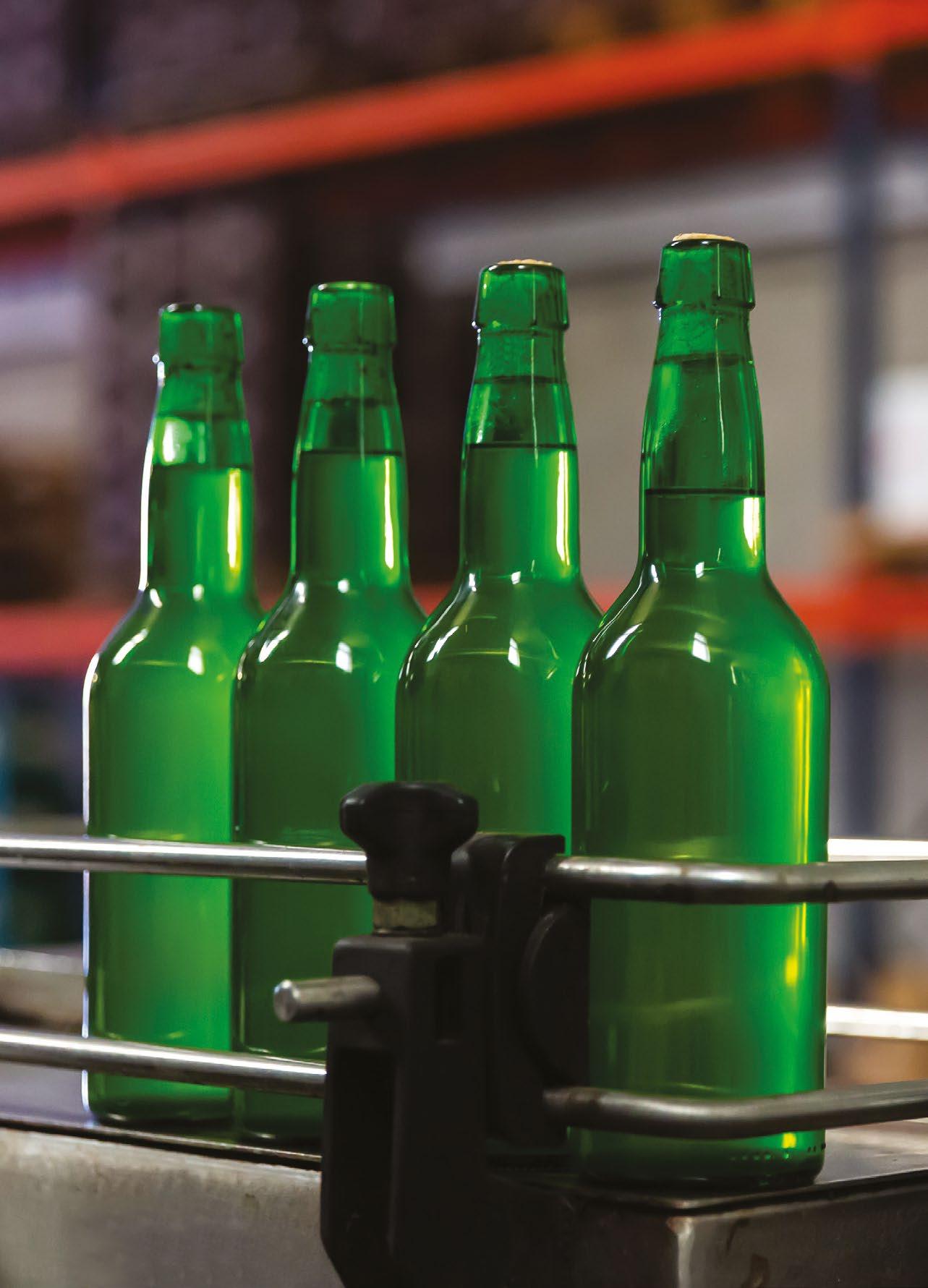
The longstanding ‘freeze’ on alcohol duty came to an end in August. Alcohol duty is now expected to rise with inflation (running at about 10% per annum at the time of writing). To soften the effects of these increases — and as part of a new ‘Brexit pubs guarantee’ — the Draught Relief scheme will theoretically increase the profitability of alcoholic drinks sold in pubs. However, whether this will cancel out the duty increases is a different story. Beer is liable for duty as soon as it is ‘produced’ or fit for consumption — yet the amount of duty paid depends on the alcohol’s strength and the quantity of beer being produced.
The new rate of duty applicable to beer produced with an ABV of 1.3% to 3.4% is £9.27 per litre of pure alcohol. For beers at 3.5% to 8.4%, this rises to £21.01. Beers with an ABV of 1.2% and below attract no duty, which may encourage some brewers to turn their hands to micro IPAs and non-alcoholic options. Furthermore, small brewers (those independently producing no more than 4,500 hectolitres of pure alcohol) will qualify for ‘small producer’ relief, which will reduce the rate of duty. Excise duty is also payable on alcoholic beverages being exported to EU countries. Since Brexit, breweries may also need to register for VAT in the EU member state they supply beverages to (being mindful that VAT rates differ across member states). Extra care should be taken to ensure that the taxation rules of each member state exported to are followed and that the tax for each member state is paid correctly. As a brewery, the tax you pay on profits made from beverage sales depends on the structure of your business (for example, whether you operate as a sole tradership or limited company). Sole traders are personally required to pay tax on profits earned, while companies are taxed as separate legal entities. In practice, many breweries start life in sole tradership form and later incorporate when the business has started to generate revenue and
perhaps needs to take on new liabilities such as employees, property leases and third-party loans. Since there is no separation between owner and business, sole traders pay income tax and National Insurance Contributions (NICs) on profits. In contrast, a company structure means that the business pays corporation tax (currently at 19%) on profits. However, income tax is then payable on the salaries received by founders and employees.
Shareholders of the business are also eligible to receive dividends (which could be paid as a top-up or in lieu of salary) in respect of their shareholding — which attract slightly lower tax rates than income tax and are also NIC-free for both the employer and employees. Being able to incentivise employees by granting shares and/or share options can be a significant benefit of running the business through a limited company structure, rather than operating as a sole tradership — but it’s worth noting that tax charges can arise on the issuance of shares to employees. To the extent that any shares (but not options) are gifted or issued for less than the market value, that discount will be taxed as a benefit in kind and the employee would pay an income tax charge on the difference between the market value and the price (if any) that they have paid for their shares. However, there are likely to be options available that can minimise the tax charges for both the brewery and relevant staff receiving the shares. In some cases, this might also provide an associated corporation tax relief on profits. Tax charges will arise on the sale of your brewery business or its assets, assuming that the brewery or assets are being sold for a profit. Sole traders will pay capital gains tax (CGT) on the profits made from selling the brewery or assets. Similarly, shareholders will pay CGT on the sale of their shares in the brewery. However, Business Asset Disposal Relief can be claimed in either of those scenarios - subject to certain conditions - to reduce the rate of CGT payable from 20% to 10%, subject to life time limits.
UK PRIME MINISTER RISHI SUNAK CALLS IT
“THE MOST RADICAL SIMPLIFICATION OF ALCOHOL DUTIES FOR OVER 140 YEARS”
— BUT HOW WILL THE NEW RATES OF ALCOHOL DUTY AFFECT THE TAXES PAYABLE BY OUR BREWERIES AND THEIR SHAREHOLDERS?
HERE, DAN FINN — CORPORATE SOLICITOR AND LEAD OF BRABNERS’ SPECIALIST BREWERIES AND BEVERAGES TEAM — SETS OUT THE NEW RATES AND WHAT SOLE TRADERS AND LIMITED COMPANIES NEED TO KNOW.
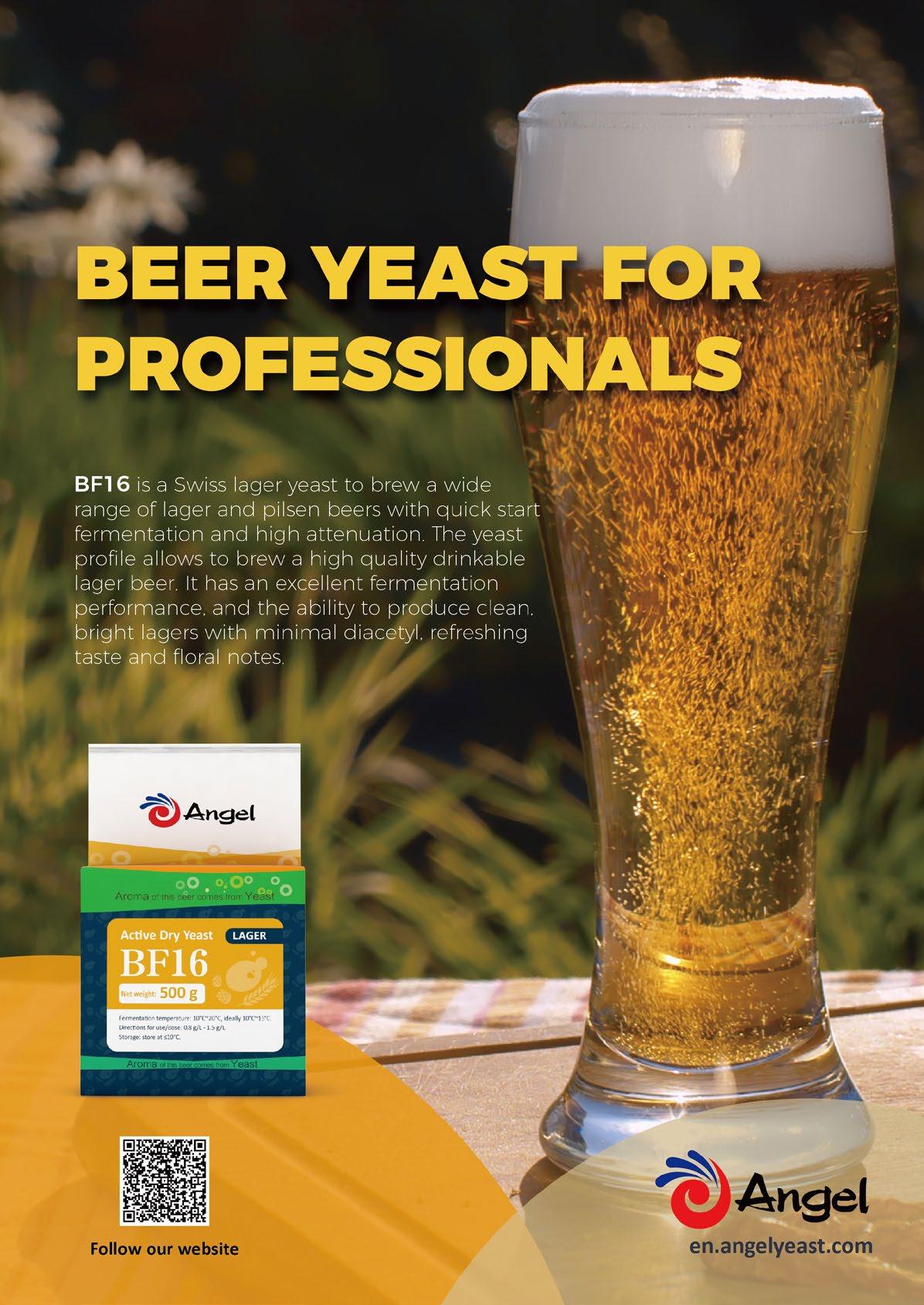
Brewing is an undeniably energy-intensive industry, and with UK Government pushing forward with plans to decarbonise the economy across all sectors, all brewers are considering how they use energy, and where their energy comes from. For breweries located off the mains gasgrid, options for a greener future may seem limited, but renewable liquid gases (RLGs), such as bioLPG and rDME, have secured approval from the Government to be developed at scale and will be coming onto the market in the coming years.
With the cost and efficiency of electricity being a prohibitive factor for some brewers, bioLPG and rDME will offer a ‘drop in’ solution. This means no changes or recommissioning of the brewhouse will be required given these new green fuels are chemically identical to conventional liquified petroleum gas (LPG).
The key difference however is that the new RLGs are produced from sustainable feedstocks rather than traditional fossil fuels, offering up to 90% carbon emissions reductions or even carbon negative when carbon capture and storage is used in their production. Energy in brewing is broken down into two primary units – thermal to generate heat or steam, and electrical for power. While energy use in breweries varies depending on size, location and types of beers produced, well over a third of the total energy used in most breweries is spent on boiling the wort.
As the brewing process is complex, with brewers requiring flexibility from day to day in brew schedules, and with heat used in several stages, a versatile and reliable fuel source is needed. Although boilers run on a range of fuels, options can be limited for the significant proportion of the UK’s regional breweries operating off the mains gas grid.
[CROSSHEAD] Liquefied petroleum gas (LPG) [CROSSHEAD]
Currently, the most efficient fuel for
off-grid heat is LPG.Not only does LPG provide an instant, efficient heat source, it also offers reduced emissions compared to solid fuels.
As the brewing sector strives to use more renewable energy, the liquid gas industry has a solution. CEO of trade association Liquid Gas UK, George Webb, explains: “While LPG is already considered a cleaner fuel choice, we recognise it doesn’t go far enough in tackling climate change, which is why the liquid gas industry launched its ambition to transition to 100% renewables by 2040, in order to meet net zero.”
He adds that a cleaner fuel source in the form of RLGs will soon be available for off-grid industries and properties.
“Made from a diverse mix of sustainable biological feedstocks and processes, RLGs are chemically identically to LPG and considered a ‘drop-in’ solution,” says Webb.

RLGs offer up to a 90% reduction in carbon emissions and carry the same low nitrogen oxides (NOx), sulfur oxides (SOx) and particulate matter as conventional LPG, contributing to cleaner air quality.
“Because they’re chemically identical, RLGs can be used with existing tanks and appliances,” he adds.
FOR BREWERIES LOOKING TO THE FUTURE, THERE ARE WEALTH OF ISSUES TO CONSIDER WHEN IT COMES TO ENERGY USAGE, EXPLAINS
GEORGE WEBB, LIQUID GAS UK’S CEO.
”They also improve energy security by reducing our reliance on imported fossil fuels, which was a big concern for the brewing industry last year.”
In August this year, the Government published the long-awaited Biomass Strategy. Biomass is part of the Government’s renewable energy strategy and its ambitious plan to accelerate the decarbonisation of the economy across all sectors.
Central to achieving net zero by 2050 is the transition to wide-scale adoption of low-carbon technologies.
Importantly, the Biomass Strategy recognises the role of RLGs to decarbonise heating and meet net zero targets.
“The inclusion of RLGs in the strategy not only gives the green light for LPG producers to ramp up domestic production, but it also averts the potential scenario of increased operational costs that brewers would’ve faced if the transition to electrified heating was enforced,” explains Webb.
“We’re pleased the Government signalled
their support for RLGs and the important role they play in the future off-grid energy mix in the Biomass Strategy.
“It’s great to know customers can now opt for this low-carbon ‘drop-in’ solution – avoiding unnecessary costly retrofits and appliance changes at a time when finances are tight for so many.”
He explains that, for brewers, the prospect of replacing direct or steam boilers to suit electrified heating elements would have required significant capital investment and greater ongoing costs.
“It would also mean a shift to a heating source that doesn’t offer the same reliable level of control or heat consistency as LPG. This could have affected the quality and consistency of the beer being brewed.
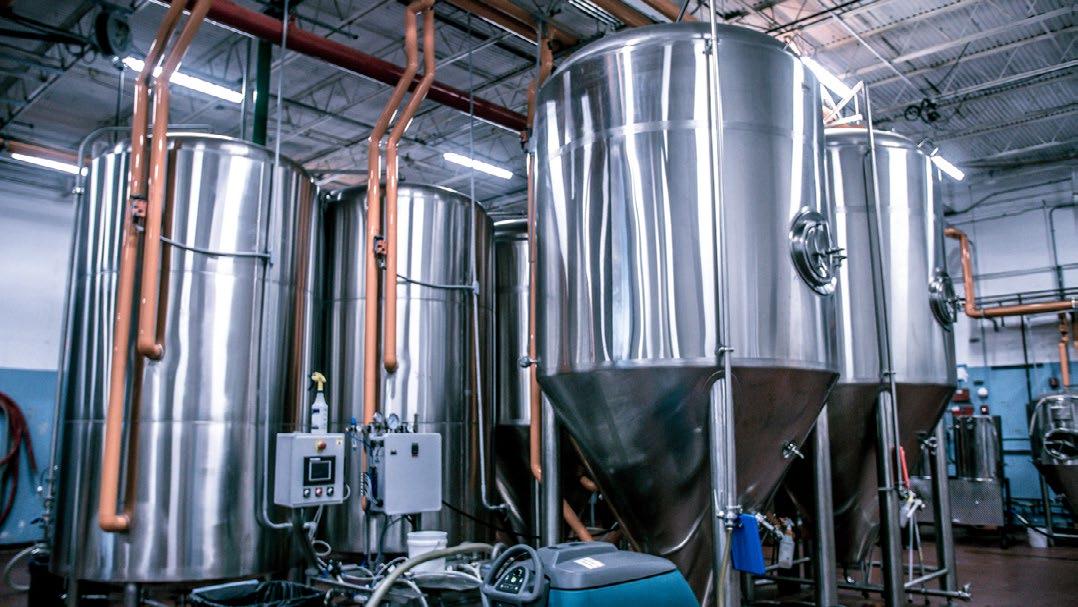
“If multiple industries had to switch to electrification, we’d also see issues with the electricity grid being unable to meet demand, particularly in more rural areas, so it’s a comfort for brewers to know that LPG and RLGs are a futureproof fuel they can continue to order and use with
confidence,” he goes on.
He adds, to date, the industry has invested more than £260 million in developing and deploying RLG solutions, with a further £600 million investment forecast over the next two years.
As the demand for biomass sources increases, Webb points out that brewers may be able to monetise their spent malt and hops with a biomass processing company, which could provide a new revenue stream and a circular solution which could see these feedstocks return to the brewery in bioLPG or rDME tanks as new fuel.
Liquid Gas UK is the trade association for the LPG and renewable liquid gas (RLG) industry in the UK, representing a membership of companies who are LPG and RLG producers, distributors, equipment manufacturers and service providers.




It goes without saying that a label is the most important part of any bottle or can, as it sets out your identity as a brewery and gives customers key information about the amazing beer they are drinking. Whilst it may seem a simple process at first, printing that label, with the best finish and value for your beer brand, can be a challenging process.
So, whether you’ve got a new design or want to improve your current label, we have created a quick guide to help you pick the right material, reduce your costs and meet sustainability targets. If you want to find out more about our label printing service, you can talk to our team on stand 301 at this year’s Brewers Congress.
Picking the right material and finish depends on whether you are using a bottle or a can. Protective shoulders on bottles help to protect your labels from scratching and scuffs during filling and transport.
This gives you access to a wider range of materials beyond traditional polypropylene including semi-gloss and textured paper stocks.
These shoulders also allow you to use a variety of enhancements to help your brand stand out, including foiling which adds metallic elements to your labels and embossing which creates raised areas of text or imagery across your prints.
Cans on the other hand, limit your choice of materials as there is no shoulder to protect your label stock.
With this in mind, it’s mostly recommended you use a plastic based facestock such as PP or PE, as this is more resistant to rips and scratching on canning lines and in transport. Historically, this would need to be coupled with a laminate to ensure that print is protected, doubling the material cost of your label.
However, we has recently invested in print technology that doesn’t need the lamination layer due to the durability of the inks. This helps to keep your cost as low as possible.
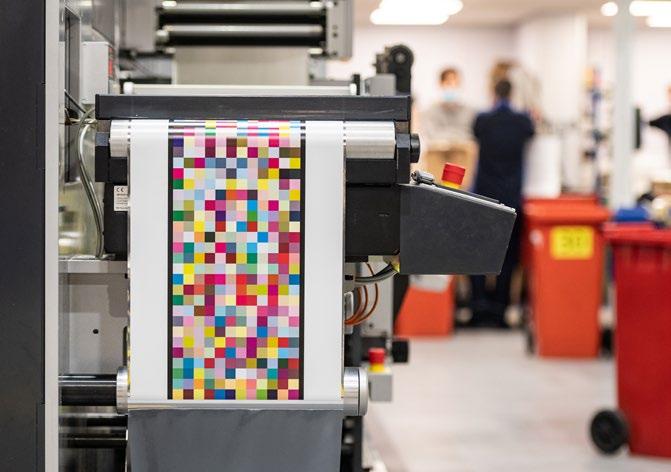
There are also options to enhance the look of a can label. For example, silver PP will allow you to add metallic elements to your labels and textured varnish will give your product a unique tactile feel.
There are a variety of printing methods used in the production of labels, with some requiring set up plates that increase your initial cost. These plates can reduce your flexibility in the long run as you may need to purchase a new one each time you make an amendment to your label.
As a digital printer we don’t use set up plates for standard print. This means you pay lower set up fees than those associated with traditional printing methods and have full flexibility to amend your labels at any time without incurring extra costs.
We also have no minimum order quantities – giving you flexibility on how many labels you order. However, as with
There are options available to enhance the look of a can label
any printer, the cost of the label reduces as the quantity increases.
So, the best way to reduce your cost is to try and bundle as many label types together into a single order.
Over the last few years there has been lots of innovation across the print industry to help brands meet their sustainability targets.We have a wide variety of these materials and innovations to choose from. This includes the use of recycled stock across a range of materials including papers and plastics.
The switch from standard to recycled materials can significantly decrease the amount of greenhouse gasses, water and virgin materials that go into the production of your labels.
Detachable labels can also support the reuse of bottles. We now offer a textured paper that detaches when washed at high temperatures, ensuring your label and branding remains intact at point of sale, but still supports reuse. All the paper labels offered by Vale Labels are also FSC approved. This means that these paper products come from suppliers that meet strict environmental, social and economic standards.
Last year we decided to expand our business to provide a unique opportunity to become a service provider within the beverage industry. For many years we have been providing solutions to major blue chip companies around the world for cleaning systems and solution solvers. In 2022 Easi-Keg Solutions was launched.
We reached out to the major players within the keg and cask cleaning Industry and asked them what was missing and what is required. With their input we have now designed and provide mobile and onsite key solutions for Keg and cask cleaning.
To make this work we required some key players to come on board with our vision and help to operate and bring new ideas within the keg cleaning world. We are delighted to announce Andy Pollard joined us in 2023 who has a wealth of knowledge within this industry and is now the Operations Director for Easi-Keg Solutions.
In 2021 we had a unique opportunity to bring on board one of the most respected mechanical and design sales engineers within specialist cleaning systems. Simon Barnes, now Sales Director for Easi Keg Solutions, has worked closely with our design engineers in making this happen. Simon is always pushing to look into the future and listening to what the customer wants, and how things can be made more efficient or cost effective using new technology.

Currently we are working on new technology which will completely change Keg and cask cleaning, a process which has not been seen before.
We have recently acquired a new location for our own Keg and Cask cleaning services with the most up to date cleaning technology. We can also provide storage, repair, modification and rebranding.
This is our first year at The Brewers Congress 2023 - October 18th and 19th. We are looking forward to everyone coming to see us on Stand 605, if you are able to attend.
easi-keg.com

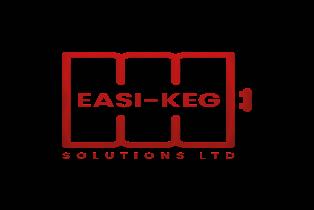
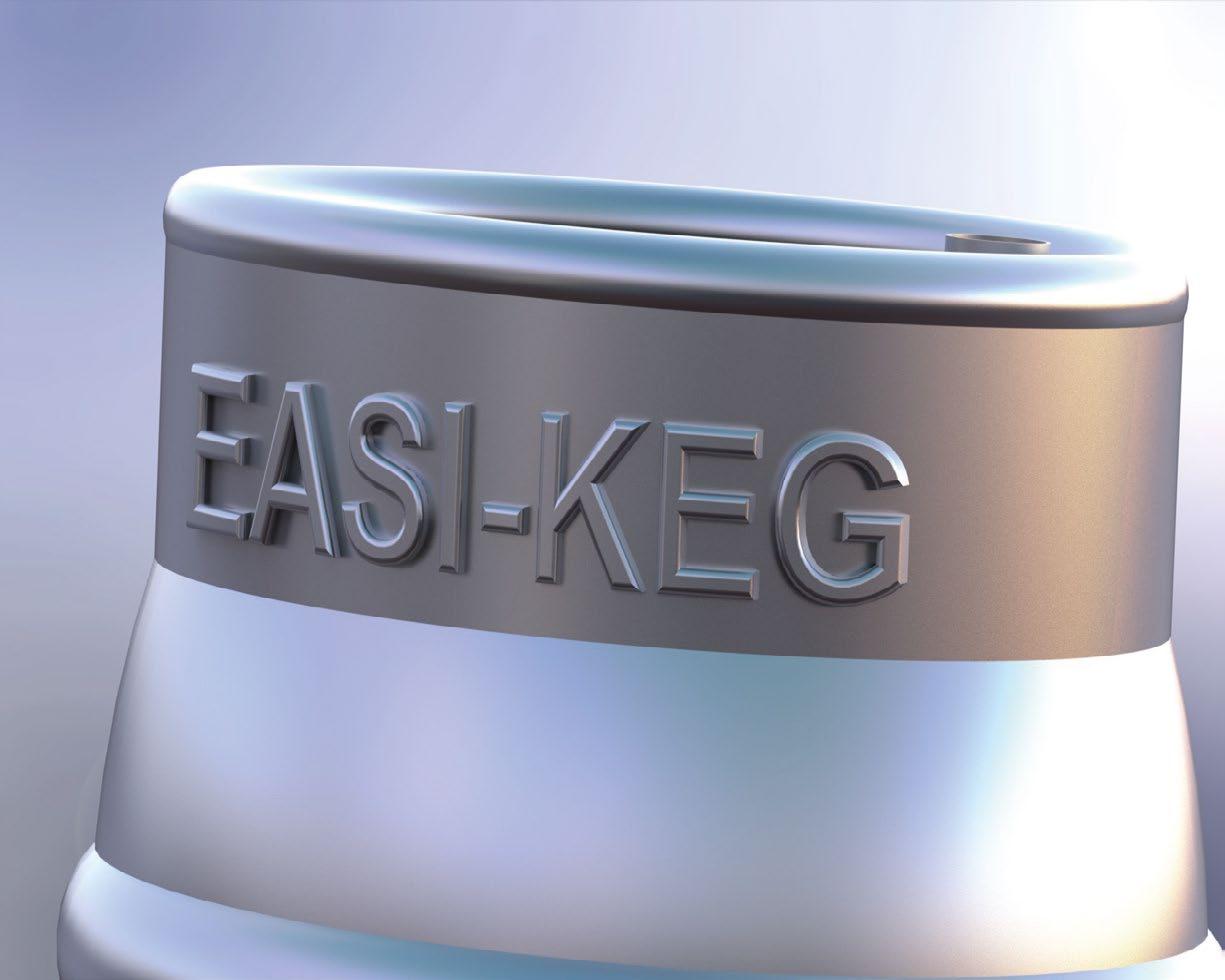
Ihave talked about Vintage Ale in the past. In those pieces I explained the reason why and how Fuller’s came to brew these beers. I talked about how we choose the ingredients each year and how we brew and process this beer for aging. Indeed, one of my points was the importance of time on the development of flavour in these beers.
Unfortunately, because of the rarity and price of these beers not everybody gets the chance to try different ages released over the years.
I have done a number of vertical tastings of the Vintage Ale, but these have been mainly for beer writers and influencers. I have always wanted to take Vintage Ale out to tastings for people who are interested in them or just interested in Fuller’s as a brewery.
I was discussing this in Edinburgh with my friend Chris Mair and whether it could be done. I had in fact done one of these at The Hanging Bat some years ago when Chris ran the pub. This came about because Chris was up for it and Fuller’s were willing to support this despite the beers being rare and valuable.
I remember the evening going very well and Chris had got a good crowd of people in. Mind you, drinking 8.5% beer all evening is usually conducive to a good time.
I wondered if other places would like to do these tasting. Chris immediately said yes and straight away got the ball rolling.
Chris contacted a couple of breweries - North Brewing in Leeds as well as Wiper and True in Bristol. Both were very enthusiastic, and this now meant I had to do something about this.
I had to persuade Asahi to supply the beer free to the tastings and to do that I
had to get them to understand the value of doing this, too. Well, that turned out to be no problem at all, Asahi thought it was a great idea and Ben Aisbitt who is my contact immediately started looking at the Vintage stock levels to see which were the best ones for the tasting.
I thought that we should do a warmup tasting in Edinburgh which is where Chris is based, Chris suggested Cloisters should host and we booked a date with them.
Ben was going to supply Vintages 2022, 2019, 2016, 2015, 2000 and 1999. I suggested sending some cask beer, to see if Fuller’s was still popular in Edinburgh. So, Ben put a firkin of ESB, London Pride and IPA on the order.
Cloisters managed to get 22 people to buy a ticket so there were no more excuses, and I booked my tickets and hotel. Ben and his wife came along, too. It was a great event; and these events really are made by the people that turn up. One person, Craig Garvey, was at the original tasing at the Hanging Bat. I noticed that the Fuller’s cask beer was going down well too, and some people were taking pictures of the pump clips!
The next event was to be at the North Bar. I wanted Guy Stewart, the current Fuller’s head brewer to join us. Once I told North this, they wanted to do a collaboration beer too. Chris had gone straight to the top and had contacted Christian Townsley, one of the founders of North, who was an enthusiastic supporter of this event.
Seb Brink their head brewer started the ball rolling regarding the collab. We originally wanted to do a mild but we then changed our plans and opted for a sparkling ale.
FULLER’S VINTAGE ALE IS A SPECIAL BEER FOR MANY, AND JOHN KEELING IS NO EXCEPTION. RECENTLY HE HAD THE OPPORTUNITY TO TAKE THIS REVERED BEVERAGE ON THE ROAD FOR A NUMBER OF TASTINGS ACROSS
THE UK. THIS IS HOW HE GOT ON.
The North Bar managed to get twenty odd tickets sold. The North Bar is a great place to do these events, as it’s right in the heart of Leeds.
Again, this was a fun evening and with Guy on hand to take the pressure off me I was able to sit back and enjoy it too. The next day we went to the brewery to make the collab. So, I was able to have a cup of tea, a couple of pints and a pizza whilst the brewers did the work. I am sure my words of encouragement were a great inspiration to them. The beer turned out to be really good too which shows that me looking over everybody’s shoulder really works.
Unfortunately for the next event in Bristol at Wiper and True Guy could not join me. So, I had to fly solo for this one. Again, Chris had gone straight to the top and had asked Michael Wiper who had readily agreed to host an event. We were booked in at the Wiper and True Barrel store at St Werburgh and it had
sold out. No pressure then but remember 8.5% beer is very conducive to a good time. Great crowd and a great event.
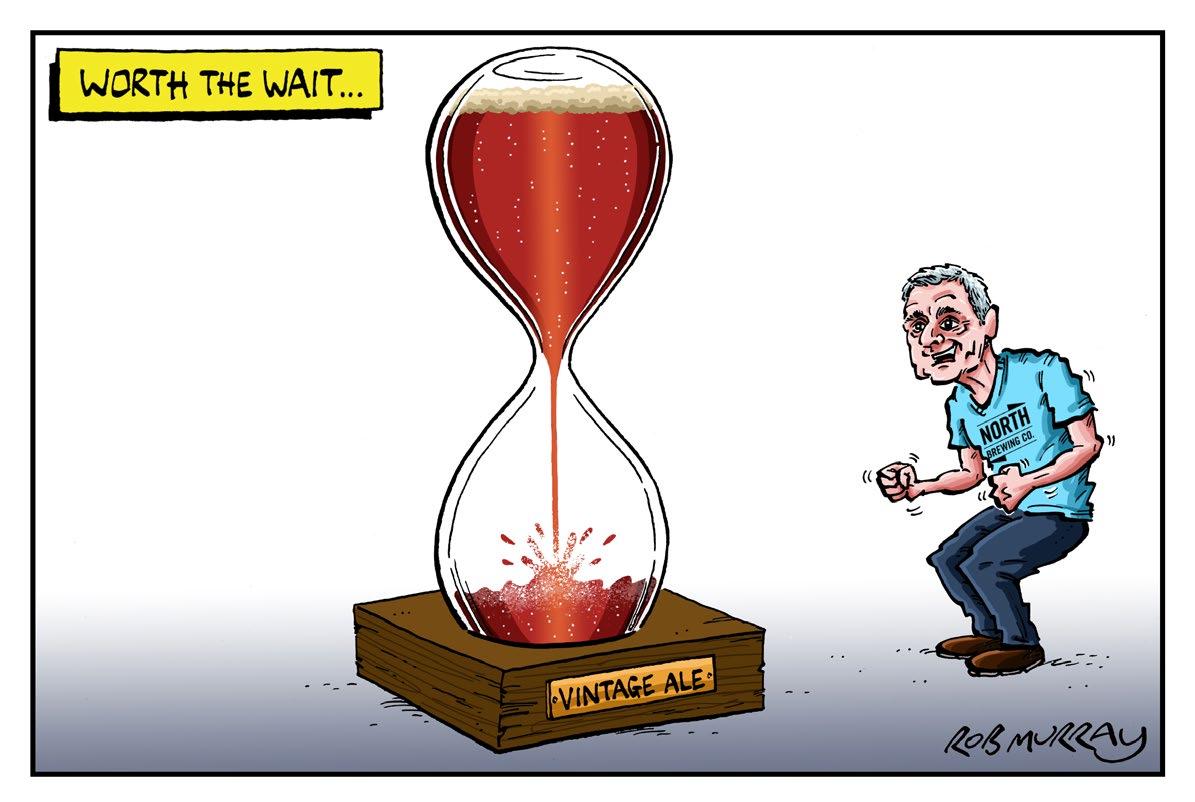
The next day I had a great tour of the brewery. I can say that both breweries North and Wiper and True were spotless and great examples for good design. No wonder they make great beer. Next, Beverly who is The Fuller’s Brewery Shop Manager contacted me and asked if I would do a tasting with Guy at the shop.
Naturally I said yes. The event was really well organised with each table having cheese and ham to try with the beer too. I must admit the Chiswick audience was the politest but maybe that was because the beer demanded their full attention - it certainly wasn’t the ability of the presenters.
I will have to find some more breweries who can host these events. Have beer will travel is my new motto.
Mind you, drinking an 8.5% beer all evening is usually conducive to a good time.”
Tropical flavours. Fruit bomb beers. Unlocking bound thiols. These are buzz phrases often tossed around whenever the topic turns to biotransformation.
In reality, biotransformation of hop compounds by yeast strains in beer is a fascinating and multifaceted process – one being embraced with great excitement and enthusiasm.
Brewers are right to be intrigued, given the clear potential to optimize the use of hops and create evermore diverse and desirable beers.
During fermentation, biotransformation occurs when some yeast-derived enzymes convert odorless and flavourless hop precursors into desirable flavours and aromas (Fig.1), making it particularly relevant for popular styles like the juicy and fruity IPAs. Research on this subject is constantly emerging, with much of the knowledge being borrowed from the wine industry. This complex process involves three main reactions: i) Terpene alcohol release and ii) conversion, and iii) Thiol release.
The main contribution of biotransformation to the final beer is the release of flavour active molecules, like monoterpene alcohols and thiols, from their non-aromatic precursors performed by two yeast-encoded enzymes, β-glucosidase and β-lyase.
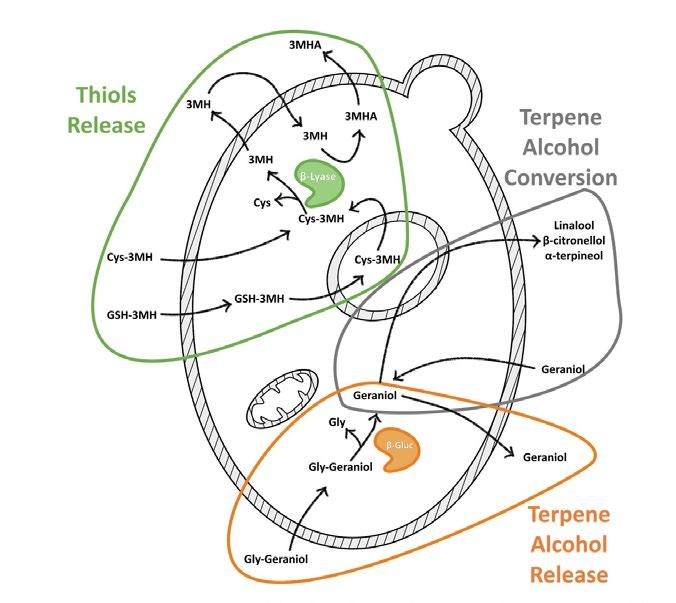
The conversion between different hopderived terpene alcohol, like geraniol and linalool, can also moderately contribute to the final product flavour profile. This process, though not fully understood, is also thought to be enzyme mediated.
The enzyme β-glucosidase releases the aromatic terpene alcohols from a nonaromatic glycoside precursor, such as
geraniol from geranyl glycoside. This enzyme is not produced by most brewing strains, being more commonly present in yeast of the Brettanomyces and Pichia genus, thus the impact of this enzyme is reduced in most beers. Furthermore, the terpene alcohols flavour threshold is reasonably high (ppm to ppb), so a considerable amount of molecules need to be released into the beer before its impact is perceived. For that reason, the main focus of brewers and winemakers all around the world is in the reaction performed by the enzyme β-lyase, also known as cysteine S-conjugate beta-lyase. During fermentation, this enzyme
releases volatile thiols that contribute notes of passion fruit and grapefruit from precursors present in malt and certain hop varieties.
Unlike terpene alcohols, these volatile free-thiols can be detected at extremely low levels, in the parts per trillion range, so any small increase is likely to be detected by the consumer. Some of these compounds, namely 3-mercaptohexan-1-ol (3MH), 3-mercaptohexyl acetate (3MHA), and 4-methyl-4-mercaptopentan-2-one (4MMP), are known to contribute tropical qualities to the beer aroma. Not all yeasts are created alike, and only
yeast strains that present a functional version of the IRC7 gene are capable of performing this reaction.
At White Labs we screened our entire yeast collection for the presence of this enzyme activity, and developed a blended culture of several high activity strains (WLP077 Tropicale Yeast Blend) to produce a beer with tropical characteristics.
Nevertheless, this gene is tightly regulated by wort composition, particularly Free Amino Nitrogen (FAN) content, and only when FAN levels drop below a certain threshold will the yeast present this activity.
To try to circumvent this limitation, brewers can manipulate the FAN content in the beer, change the hop additions to maximize precursors or try to apply one of the commercially available genetically modified (GMO) strains with continuous activity of the enzyme.
Hops, as the main source of boundthiol precursors, also need some consideration as each hop variety contains different types and amounts
of compounds that will impact the final flavour profile of the beer.
Some of the most popular hop varieties, like Citra, contribute high amounts of volatile thiols to the beer and do not benefit significantly from biotransformation.
On the other hand, more traditional varieties like Cascade, Saaz or Simcoe contain higher amounts of thiols in the bound and non-aromatic form. Such hop varieties particularly benefit from interaction with high β-lyase activity yeast strains to achieve tropical aroma profiles. The challenge for the brewers is then to provide the selected yeast strain with plenty of precursors, so that the final product presents an improved aroma and flavour.
Introducing hops during the mash and focusing on whirlpool and fermentation hop additions are some of the most popular approaches.
Some recent research indicates that whirlpool additions significantly contribute to increased precursor

concentration in wort, and that cold storage might be necessary for the release of a significant portion of the volatile thiols back into the beer. Thiol precursors can also be introduced in the brewing process from other sources, namely grape derivative products like Phantasm or even malt, increasing the overall impact in flavour and aroma.
The impact of all these new ingredients and techniques is still being assessed, with new information becoming available all the time.

Gravity Systems was formed to meet the growing demand in the craft beer market for a single source for all brewhouse, fermentation, services generation and distribution. It is our aim to be the most complete partner in the brewery industry by building long term partnerships with our customers.
New Zealand is so special to James Heffron
he’s basically built his Cornwall brewery around Kiwi hops.
He first travelled to New Zealand nearly 25 years ago, 15 years before he would start Verdant brewery and deliver some of Britain’s most punchy and popular hop-forward beers.
“I was travelling there from 1999 to 2001 and there was a better beer scene at that point in New Zealand than at home.
“I met my wife Hagit there — she’s from Israel and was back-packing — and we went back in 2010 to celebrate 10 years together. It was that trip that I have these memories of great locally-made beers, and there were so many good breweries.
“There was one day when we visited a brewery and bought some beers to takeaway. We drove through to the Nelson Lakes region and there were hop fields on either side of the road and it blew my mind that here were these amazing ingredients that were going into the beer I was drinking at the end of the day.
“It was after that trip that I went home and started home brewing.”
Heffron and his wife had a food business, specialising in Middle Eastern food, Fal Falafel, but when he got the beer bug a brewery was soon on the horizon.
“I approached beer recipes in the same way as our catering business – loads of flavour and making people love what they are consuming.
“We registered Verdant in September 2014, and we were brewing on a 200-litre system and holding down other jobs but straight away I was hassling [distributor] Charles Faram in the UK to get a contract for New Zealand hops.
“I knew we needed these New Zealand hops to make a success of Verdant. And Nelson Sauvin was right up there in the hops I wanted to contract, and it plays an important role in our brewery.
“New Zealand Hops, and especially Nelson Sauvin, are just striking. There’s a really interesting balance between fruit and savoury, there’s a hedgerow kind of thing, and a wildness about them. I genuinely struggle to describe them.
“Nelson for instance is gooseberry, white grape and white wine but there’s a sweatiness, a dankness, a diesel note, some nettle, celery tops — it’s just so multi-layered.
“When it comes to Nelson beers, I take a sniff and a whole world of different flavours emerge. You don’t only get one and stop, it just keeps on going.”
Heffron understands there are critics who don’t like Nelson Sauvin, but he has a clear message for them.
“I do see some people say ‘I don’t get on with Nelson Sauvin’. When I see that, I genuinely think: ‘you’re insane’. It’s one of the most amazing hops in the world. There’s nothing you can replace it with.”
Also in the south, Kent brewery Curious have an obsession with Nelson Sauvin, but for much different reasons.
Brewer Wes Lynch says the brewery’s flagship lager is dry-hopped with Nelson Sauvin specifically to create a beer that will appeal to wine lovers.
That dates back to the creation of Curious in 2011 when it was started by the Chapel Down winery in Tenterden, on the premise of winemakers who were curious about brewing.
“And what’s the easiest hop to tie back to wine-making?” Lynch asks rhetorically. “Nelson Sauvin.”Curious beers were initially contract brewed but in 2019 Chapel Down decided to build a brewery and taproom.
“Of course 2019 wasn’t the best year to start a brewery …”
The impact of Covid on a brewery that had just been commissioned resulted in Chapel Down selling the brewing operation.
NELSON SAUVIN IS A WONDERFUL HOP. IT IS ALSO INCREDIBLY VERSATILE, TOO, REGARDLESS OF BEER STYLE OR DISPENSE EXPLAINS MICHAEL DONALDSON FOR NZ HOPS
“However we still retain a lot of that original brand identity,” Lynch says, “and we still try to celebrate the terroir and provenance of this area, not just the wine, but the locally-grown hops. “Our flagship beer, Curious Brew Lager, was always based around a heavy dose of Nelson Sauvin in the dry-hop.
And while we’re now focused on local hops from a sustainability perspective, English hops are not known as massively citrussy, flavourful, hops so we’re very selective about what hops we import and we want to be punchy and impactful with those hops that we do import. Which again fits Nelson Sauvin perfectly.”
The other link back to wine-making for their lager is a secondary fermentation with champagne yeast which adds effervescence and dries out the beer, giving a nice canvas on which Nelson Sauvin can shine. Carbonated at 5gm/ litre, the result is a “dry, punchy lager but not in an overwhelming way”.
The big dose of Nelson Sauvin in the dryhop compensates for the dryness and the high bitterness (35 IBU) in the 4.7%
ABV lager.
“That citrussy sweetness rounds it out and makes it more palatable to the regular lager drinker while craft drinkers enjoy that extra bitterness and dryness,” Lynch says.

At Redemption Brewery in London, Andy Moffatt is a huge fan of the way Nelson Sauvin’s heavy-hitting aroma can lift cask ale.
Exposure to oxygen more in cask beer slightly reduces the punchiness of the hops, and in an era when even cask beer drinkers are looking for a hoppy hit, hyper-flavoured New Zealand hops work perfectly.
“You don’t get the full punchiness of the aroma hops in cask beer compared with keg beer, but the New Zealand hops work very well because they are punchy in their own right but they don’t overwhelm the beer in terms of sessionability,” Moffat says.
He has been using Nelson Sauvin for
more than 10 years in his flagship Big Chief IPA and he likes the way that hop adds value, aroma- and flavour-wise, without taking away from a drinker’s ability to have a few pints.
“Sometimes with keg beer, those bigger hops — like Citra or Nelson Sauvin — can result in an oily, slick feeling going down your throat and it can feel too much sometimes. That intensity, after you have a pint or two, can feel like too much.
“But in cask ale with Nelson Sauvin, you still get that hop character standing out, with the gooseberry and tropical notes, but it’s a bit more subtle and balanced so you don’t get that strong flavour coming through. Nelson Sauvin, in cask, works very, very well.”
The malting barley market in England has yet to trade in any significant quantity as intakes open and existing contracts are delivered, and the market assesses yield and quality of the upcoming crop.
The wider market has seen significant volatility in feed grain prices, primarily due to the Russia/Ukraine conflict and the bombing of export silos in Odessa and drone attacks on some of the Ukrainian loading points for cargoes on the Danube river.
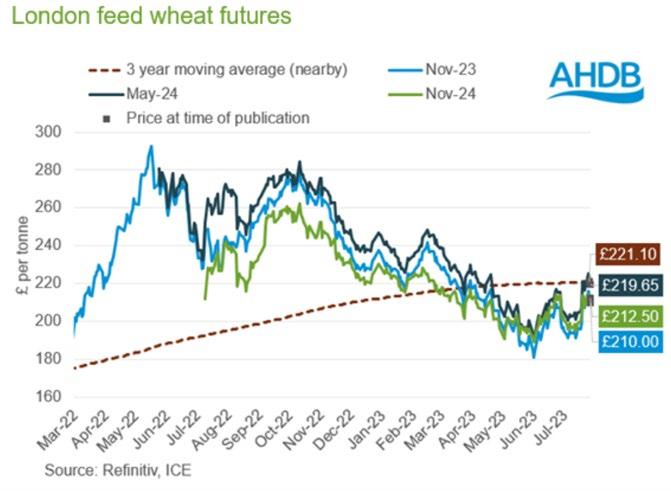
These events are bullish, but the market also realises the reality of adequate supply. Export competitiveness from the UK for feed grains is hampered by domestic prices and a stronger Sterling.
Winter barley in ‘good’ condition. Yields are slightly down due to a dry April & May. Winter barley harvest in England and Scotland is progressing with East Anglia and the South of England ahead as expected.
However, progress has been interrupted by a southerly jet stream bringing more rain than we would normally expect at this time of year.
Yields on the farm have been average or slightly below average which is disappointing. However, reflects the dry weather spell throughout April and May. Predictions for yields of spring barley in the EU- 27 are down 13.6% from the five year average.
Early spring barley crops are showing promising signs on quality.
Initial results are positive with reasonable yields of full specification barley without the screening issues seen in the winter crop – we remain hopeful that this trend will continue as the crop comes
to harvest over the next six weeks or so (weather permitting). Due to the extended drilling window, we expect a prolonged harvest period for the crop this year.

Yield predictions for the EU remain mixed, French crops are mostly harvested with reasonable results. Results in Spain have become reality, with yields down c.20% from the 5 year average. Yields in Northern Europe are predicted well down from the 5 year average due to the extended dry spell during the growing season.
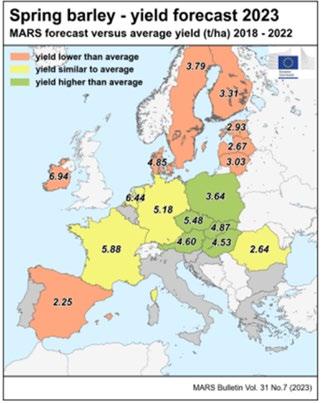
A wet harvest is forecast, but it shouldn’t affect quality Trade attention is very

model below suggests that as we move into August that rainfall is likely in all harvesting areas leading to a snatched harvest with higher moistures than 2022 crop. When coupled with relatively low temperatures then there is no imminent danger to quality and with the combining power that is available on farms then there is the expectation that harvest opportunities can be taken between the rain events.
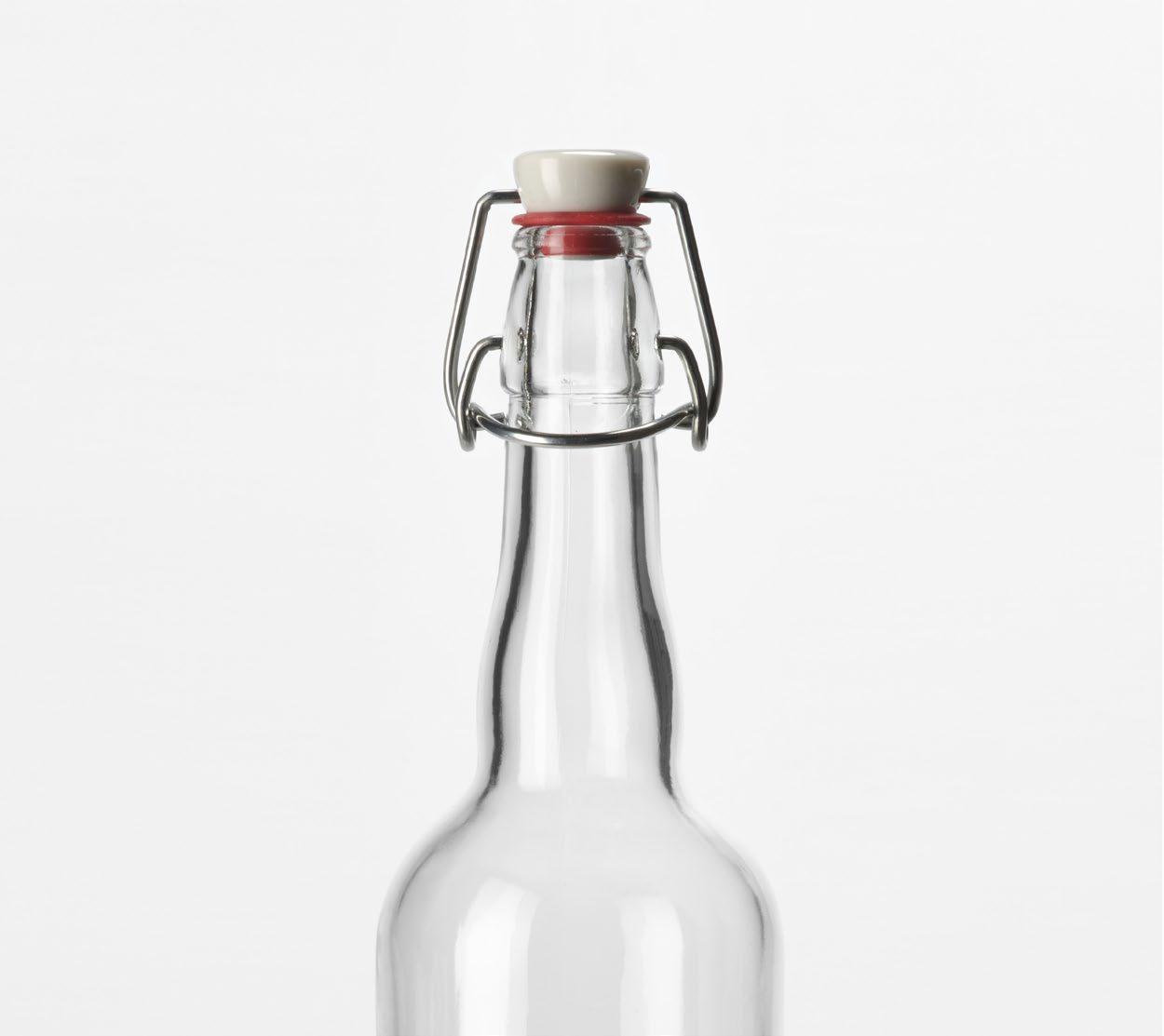
When it comes to India Pale Ale (IPA) and New England India Pale Ale (NEIPA), 2023 has been a remarkable year. Craft brewers around the world have been pushing boundaries, creating stunning examples of these hop-heavy styles.
Using the ratings from the popular beer app, Pint Please, we’ve compiled a list of this year’s standout IPA and NEIPA offerings. From well-known breweries to hidden gems, let’s dive into the 2023’s top-rated IPAs and NEIPAs.
India Pale Ales and New England India
Pale Ales are the two most popular beer styles of the new beers that breweries are currently brewing. As our previous study showed, IPA and NEIPA are the hottest styles and get most love from the breweries.
The IPA, known for its strong hop flavour and higher alcohol content, has long been a favourite of craft beer enthusiasts. Its broad style allows for endless variations, from the resinous and bitter West Coast IPAs to the balanced and

citrusy East Coast versions.
The NEIPA, on the other hand, is a relatively new entrant to the beer scene. Characterized by its hazy appearance, juicy flavour profile, and softer bitterness compared to traditional IPAs, NEIPAs have been rapidly gaining popularity over the past few years.
Their fruit-forward flavour and creamy mouthfeel have made them a hit among those who might not typically enjoy the assertive bitterness of a traditional IPA. Data from Pint Please confirms the power of the “hop revolution” in modern brewing. As craft brewers continue to experiment and push the boundaries of these styles, it’s clear that the world’s thirst for IPAs and NEIPAs is not waning. For beer lovers, this means we can look forward to more creative, flavourful, and exciting brews in these styles in the years to come. In the first five months of 2023, we dug into the ratings submitted to the Pint Please app, seeking to understand the trends in IPA and NEIPA preferences. We discovered that all the beers in our top 20 list sport an alcohol content between 5.0% and 7.0% ABV, illustrating a
preference for moderately strong brews. The first beer to break this pattern is La Cristal IPA, with an ABV of 4.7%, placing a respectable 46th on our list.
This roundup of top-rated IPAs and NEIPAs focuses predominantly on Europe, aligning with Pint Please’s primary market.
The European craft beer scene is vibrant and diverse, and this is reflected in the variety and quality of the beers rated. A standout in our analysis is the Finnish brewery Salama Brewing Company. After being crowned the best Finnish brewery based on Pint Please ratings in 2022, Salama continues to impress in 2023. Its recent release, Ultraviolet 5, leads the pack, affirming the brewery’s commitment to quality and innovation. We will delve deeper into the specific ingredients that set these IPAs and NEIPAs apart in an upcoming article. There, we’ll explore the selection of hops and malts that contribute to the exceptional flavour profiles and high ratings of top rated brews. So, stay tuned for a more detailed analysis of what’s inside these top-rated beers.
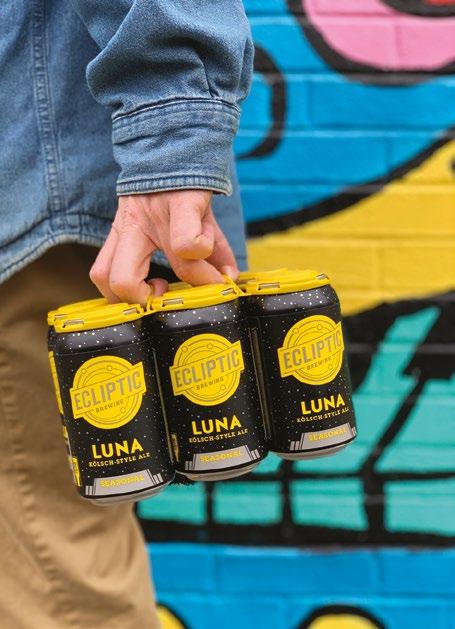
AS
CLEAR THAT THE WORLD’S THIRST FOR IPAS AND NEIPAS IS NOT WANING, EXPLAINS JUHA KARPPINEN, THE CO-FOUNDER AND CEO OF PINT PLEASE.




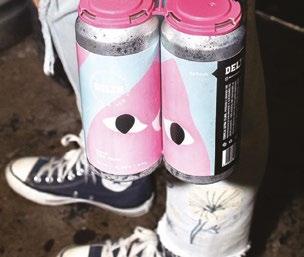

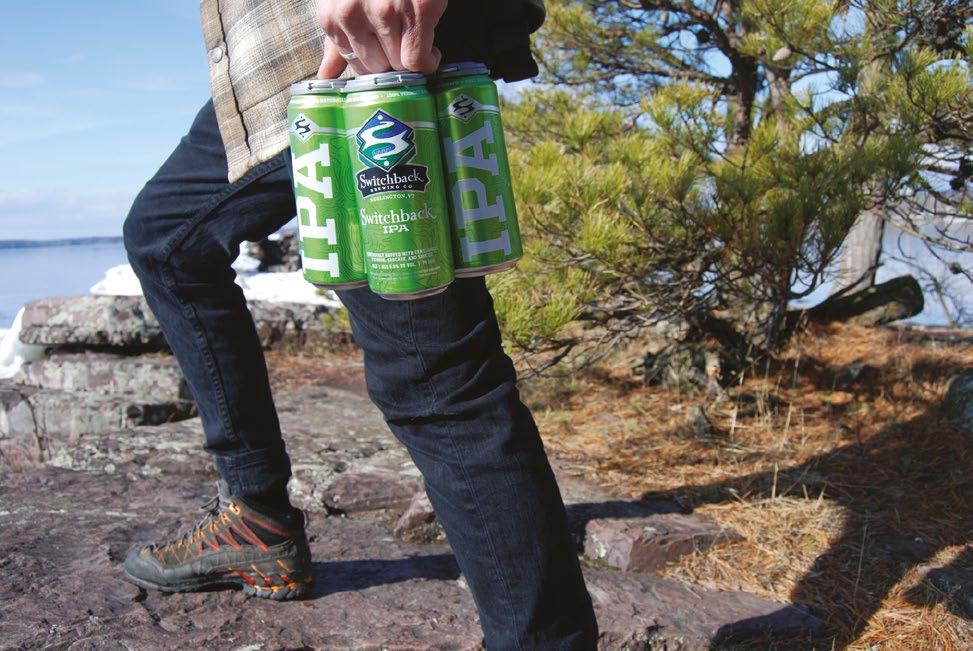


For the Brewers Choice Awards 2023, the categories up for discussion were Young Brewer of The Year, Brewer of The Year, New Brewery of The Year, Brewery of The Year, New Beer of The Year, Beer of The Year, Branding of The Year, Lifetime Achievement and Global Ambassador.
This year’s submissions were judged by an array of talent that included decorated author and Brewers Journal contributing editor Melissa Cole, Stephanie Brindley, John Keeling, former brewing director at London-based Fuller’s, Lotte Peplow, the craft beer ambassador in Europe for the Brewers Association, Paul Davies, founder of the award-winning AleHunters Brewery Tours, freelance beverage and hospitality consultant Sean Robertson. Tim Sheahan, global editor of The Brewers Journal chaired the proceedings. He said: “It was once again a genuine privilege to share a room with so many regarded figures from across the world of beer.
“As with every year, the quality of entries in each-and-every category was skyhigh, predictably making the judging process an incredibly tricky task.
“I’d like to thank everyone that entered and a huge well done to everyone that has made the shortlist this year. We look forward to announcing the winners, alongside the recipients of the Roger Ryman Lifetime Achievement (supported by Konvoy) and Global Ambassador (supported by Kegstar) awards, at our 2023 Brewers Choice Awards dinner in London this October. Hopefully you’ll join us there.
“Special thanks to our sponsors and also to Angus, Clare and the team at The Red Lion in Barnes for expertly hosting our judging session.”
The winners of the 2023 Brewers Choice Awards will be announced at the Brewers Choice Awards taking place on the evening of the 18th October in London.
Supported by Lallemand
To contend this award, we wanted to see a detailed overview of the business success you’ve had in the last 18 months. Breweries were to showcase key moments for the business such as new investments they’ve made, new distribution deals they’ve struck or successes they’ve had in exporting their beer to other countries. And also, we asked them to tell us about their brewery’s approach to all facets of business such as its work in the community, and its commitment to training and developing its staff.
In the last 12 months, Anspach & Hobday has grown from three wholesalers to eight. They also saw a revival of export post-Covid. Previously Italy had been their biggest market. This has returned alongside France with new markets in Belgium, Luxembourg and Finland. They now have more than 10 regular lines of London Black on the continent alone, a 4.4% porter that continues to elevate the brewery thanks to its ongoing success.
During what has been an incredibly difficult year for hospitality, North Brewing has put their core values at the heart of everything they do to ensure that every business decision they make is for their customers, employees, community and partners no matter where they touch the business. Thanks to this their focus remains on further embedding their deep-rooted connection within the local community, along with their friends across the world. They’re celebrating another successful year, which has so far been full of exciting new projects, collaborations events, and product launches. Not only this, but they continue to brew the best quality beers while growing a team, the culture and the business.
FROM ACROSS THE BREWING SPECTRUM CONVERGED ON THE RED LION IN BARNES, LONDON, TO DEBATE AND DISCUSS THE WEALTH OF EXCELLENT ENTRIES SUBMITTED FOR THE 2023 ITERATION OF THE BREWERS CHOICE AWARDS. HERE’S HOW THEY GOT ON.
As they emerged from the pandemic, the industry faced different and more challenging times with extreme pressures on running costs, materials and a changing consumer landscape. Despite this, Northern Monk continue to grow with increased presence in supermarkets, while maintaining quality and producing and launching innovative, exciting new products. They have also continued to champion and support local and national charitable causes and campaigns.
Signature Brew believe that no great music experience is complete without great beer. From their state-of-the-art brewery in East London Signature Brew proudly produce fresh, award-winning beer that brings people together. Their unique approach to reaching drinkers has helped them grow rapidly even throughout difficult recent years. Their beer is sold at more than 400 permanent stockists and is tracking more than £10 million revenue by 2024. Their mission is uniting people through the power of incredible beer, great music and unforgettable experiences.
There are some incredibly talented young brewers working in the UK brewing industry. Some young brewers are running their own operations, others are cutting their teeth working at established outfits. Regardless, these brewers are making their mark on the industry and are certain to have a long, successful career in the field.
Lost and Grounded Brewers
Virginia is an Italian brewer living in Bristol. She has been living and working in the UK for the past five years. She says she feels very lucky to have found a new brewing family to continue her path and develop her skills while she helps Lost and Grounded expand and thrive. She says she is committed to maintaining and continually improving the beers they produce as a team. And of course, she is forever spreading the craft beer love.
She adds that brewing is a true labour of love. It requires a team effort to make consistently high-quality beer. She says she still has a lot to learn but she’s also a hard worker, constantly challenging herself to get better results. At the end of the day, it’s all about making better beers and surpassing customer expectations!
Samuel
Samuel Fraise has been working at Attic since the early days (early 2019) after they had been open for only a few months. He came in during his studies for his masters in brewing and distilling at Heriot-Watt. He was promoted to head brewer role in early 2021 as one of the directors stepped back from the brewery to help manage the wider business. Since then Sam manages a team of 5, soon to be 6 and oversees production of 120HL/ week, a significant jump from the 32HL/ week production he was managing only 2 years ago. During 2022 Sam also undertook a large project of putting in place documentation and process to obtain SALSA approval. This and much more besides, too.
Following his previous commendation as young brewer of the year which showcased how he designed and installed their 4-vessel 25HL brewhouse with 100HL fermentation capacity and 50HL packaging capacity, he has overseen the installation of a further 75HL fermentation capacity and 25HL packaging capacity. This has been testament to the success of the brewery over the last 18 months in what is a very difficult time for the industry. The installation of the new vessels was able to be completed with minimal disruption to production as their chiller was originally scoped for expansion on installation and our pipework was able to be built-off with no need for down-time. He kept a focus on chilling efficiency during the new installation which has helped our packaging operations and particularly their canning line run so well up to this point.
According to his colleagues Pietro has really helped continue to grow Northern Monk and make sure they’re producing extraordinary beer, at higher quantities, more efficiently while being more sustainable and not lowering their standards of quality. He has worked hard to continue to shape their brewing output as they have expanded rapidly both in terms of volume and the team itself. He has taken on fresh responsibilities with enthusiasm and determination.
Campervan Brewery
Over the past four years, his skills and experience as a brewer have grown alongside Campervan Brewery. After graduating from Heriot-Watt with a Masters in Brewing and Distilling and starting his career at a lager brewery in Glasgow, he has progressed from the position of brewer to head brewer to now a combined role of head brewer/ production manager. He has overseen two expansions in fermenting capacity, the installation of a canning line, created a barrel-ageing/mixed fermentation project and implemented several quality projects, including working towards their SALSA audit later in 2023. He believes the past year has seen him contribute significantly to the business helping it achieve its current success.
Brew York
Nadia Spencer joined Brew York in May 2021 via a Hit Training Brewing Apprenticeship. She achieved a Pass with Distinction in February 2023 and has become a notable young ambassador and one-to-watch in brewing. Nadia has an incredible career and future ahead of her and is a shining asset to the beer industry. In addition to being a skilled brewer she is eloquent and speaks about her work with intelligence and passion. As someone who is committed to inclusivity and working to make the industry a fair and safe place for all, she is an impressive role model for others who may need to ‘break the mould’ and pursue a brewing career.
FERMENTATION RANGE
AROMA & FLAVOR
ALCOHOL TOLERANCE
ATTENUATION RANGE

™ is a true bottom fermenting Saccharomyces pastorianus hybrid from the novel Group III lineage that has been selected to produce a robust lager strain with ideal characteristics for clean lager beer with distinct avor characteristics and superior fermentation performance.
™ was selected using classical and non-GMO breeding methods and inhibits the production of hydrogen sul de (H2S) o - avors.
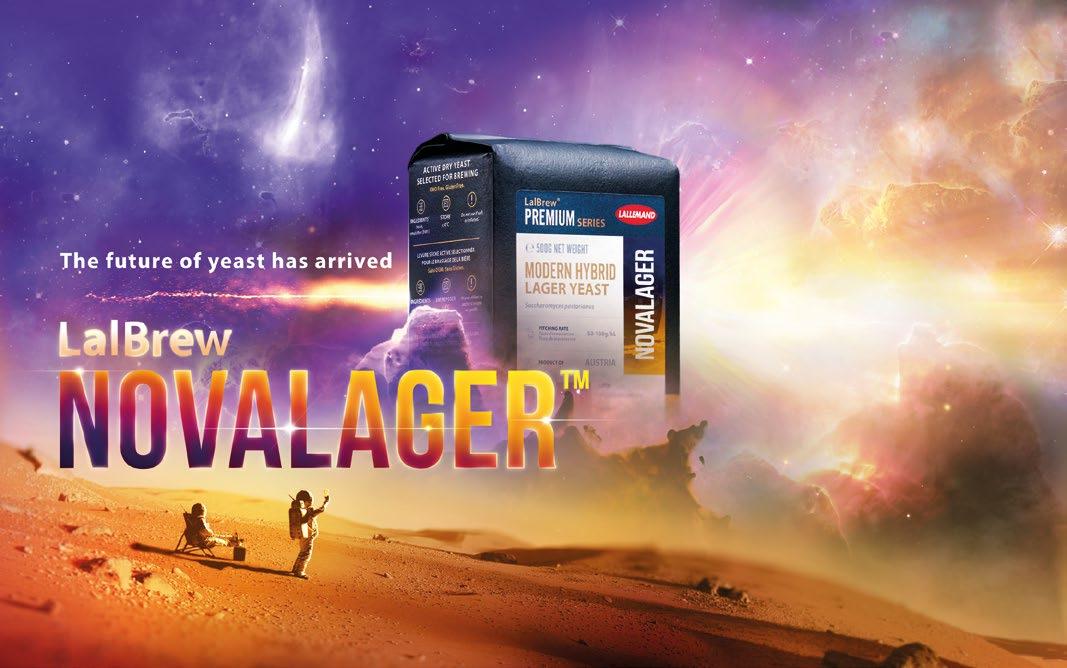

Wyllie Recycling Perth wyllierecycling.co.uk
Winelab Kildare winelab.ie
WDS Group Bury wdsgroup.co.uk

First Mile Birmingham thefirstmile.co.uk
Jolly Good Beer Wisbech jollygoodbeer.co.uk
First Mile London thefirstmile.co.uk Niche Solutions Northampton nichesolutionsgb.co.uk
Binit Clyst Honiton binituk.com
Staggeringly Good Portsmouth staggeringlygood.com
Recorra Lancing recorra.co.uk
Supported by Rankin
We can think of countless fantastic beers that have been produced in recent months. In the entries, we wanted to hear how this beer is shaping a trend or exploring new techniques and flavours.
Exale
Jazz Dragon
This is the first double IPA they have brewed at Exale. They always start developing recipes thinking about the the kind of beer that they would like to drink themselves and this beer is no exception. They wanted to make a full bodied beer that could be paired with a wide range of food, especially dishes with a bit of heat, and use the opportunity to experiment with as many techniques of getting hop flavour and aroma into a beer as possible.
Saltaire
El Dorado
Created as part of an ongoing collaboration series, El Dorado is a robust double IPA, bursting with flavour. El Dorado was created to showcase a move towards the latest trends in beer and exploring new techniques. Available in can, keg and cask, it’s a punchy, unique and flavourful tropical beer.
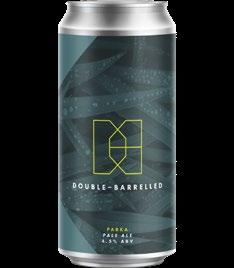
Stroud Brewery
Easy Peasy
A balanced lower alcohol ale - it packs all the punch of a hoppy american ale, but light on the alcohol And it’s organic.

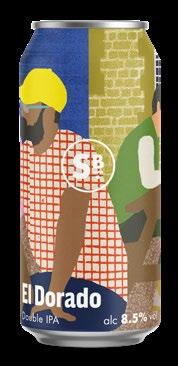

Supported by Barth Haas X
We want to celebrate the very best beer the UK has to offer. We’re not looking at dozens of categories, instead recognising one beer - The Brewers Choice ‘Beer of the year’.
Burning Sky
Petite Saison
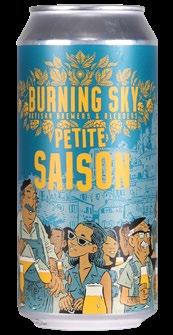
This mixed fermentation saison is a light and easy drinking small beer. Barrel aged for a few months, this delicate beer was then dry-hopped for a refreshing finish.
Double-Barrelled Parka
Centennial hops on the hot side meet bright, juicy citrus fruit notes from Citra on the dry-hop. All wrapped up with a soft mouthfeel and lashings of peach from their house yeast. Perfectly drinkable, balanced and moreish. Parka was the first beer they brewed when they built Double-Barrelled, and it has been a central part of who they are ever since they began brewing.
Northern Monk Faith
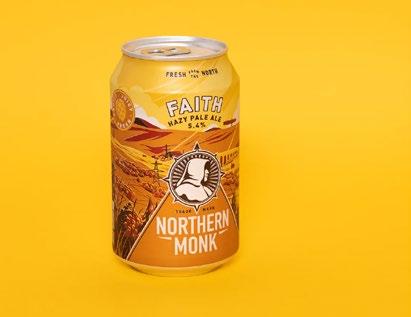
Faith is the largest hazy beer by volume
(excl. Brewdog) in the UK. One can of Faith is sold every three seconds in the UK. It has seen 60% volume growth in the five years 17-18 to 21-22 while keg sales were up 145% in 2022 year-onyear. Faith is their biggest selling beer across both the Refectory bar sites, and is sold in hundreds of pubs, bars and supermarkets across the UK
Supported by SSV Limited
One of the finest qualities many brewers boast is humility. So this category it was always likely to need some convincing/ persuading/forcing when it comes to ensuring these excellent brewers are considered. We wanted to acknowledge a brewer that is truly an industry tour de force. What sets them apart from the rest? Is it the beers they create, expansion they’ve overseen or a team they’ve built. Maybe it’s all of those….
Seb Brink
North Brewing
His colleagues call him a genius. The team first met the would-be head brewer of North when he was brewing in his garage and cuckoo brewing at Brass Castle for his brand Golden Owl whilst supplying one of the North bars round the corner from his house. He’s gone from that to leading a team of 25, brewing over 20,000HL PA. He’s done it seamlessly, like it’s the most natural thing in the world, negotiating a worldwide pandemic, and a move from a 3,000sq ft brewery to one of 23,000sq ft. He always pushes and challenges, every brew is an opportunity to tweak something, try something new and aim towards
perfecting a beer (Although they know that he would never be 100% happy…).
Jordan Childs
Mash Gang
Jordan Childs has gone from being a bored homebrewer to head brewer overseeing four global sites in the UK, EU, USA and Australia releasing over 100 different beers in under three years. One peer said working with Jordan reminds them of why they do what they do, challenging what a beer is and using science to create something new and exciting. “Not only has he rewritten the rulebook for no-and-low, he has made it f*@king cool,” they added.
Mark Tranter
Burning Sky
Burning Sky, a brewers dream. It was the dream of long-term brewer Mark Tranter who has a love of both punchy hopforward pales and of beautiful Belgian beer tradition. A brewer’s brewery, they are fortunate to be blessed with a talented team. Burning Sky say that whilst industrial units are convenient, they seldom inspire, so they chose to locate themselves within the beautiful and inspirational South Downs, occupying refurbished farm buildings in a slightly quirky village. A true farmhouse brewery. Whilst ambitious, they have never wished to grow out of, or beyond the buildings they occupy. Instead they invest heavily in the areas that they wish to grow in.
A raft of excellent new breweries have opened in the last few years. Some of these outfits have focused on the art of Lager, some IPA, some mixedfermentation sours and some a mix of each. Regardless, each tread their own different path in the industry of brewing. We wanted to hear about those early landmark points for the business. Maybe they’ve offered employment to local people, it could be the investments they’ve made, securing deals for their first beers with pubs, bars or restaurants. It could be all of the above We asked to be told about the brewery’s approach to facets of business such as its work in the community, commitment to training and
developing its staff, relationships with the broader industry and their approach to issues such as sustainability.
Azvex
Adam Henderson, founder of Liverpoolbased Azvex Brewing Company, is absolutely driven and fully committed to delivering the best beer he is capable of making and to offer the best possible experience for his customers. For many years he has spent countless hours researching, brewing and experimenting to improve his understanding of beer and his ability to make better and better beer. He has also spent even more hours learning about running a business and how he can improve it to better benefit his customers. He therefore created Azvex to achieve these goals. A brewery that has made fantastic strides since being founded in 2020.
Balance Brewing & Blending was started in 2021 by Will Harris and James Horrocks. The first time they mashed in a Balance beer was June 2021 and their first release was in May 2022. The long period of time is due to the fact that all of their beers are barrel aged and fermented with their house culture of saccharomyces, brettanomyces and lactobacillus, taking anywhere from six months to two years to come to fruition. They are the only brewery solely producing mixed ferm beer in Manchester and one of only a small number in the UK as a whole. This is a style of beer they love and feel has been underrepresented in the UK. The complexity and character of these beers is unsurpassable, at least in their opinion!
At Floc, their aim is to make world-class beer using quality ingredients with a passion for flavour and drinkability. They brew modern, flavourful beer to be enjoyed with friends in pubs, on the beach or wherever you enjoy spending time. They like their beer to be hoppy and hazy, with the odd lager in the mix, sometimes strong, sometimes session strength but always with a dedication to quality and drinkability. They make the beer they love to drink and hope their customers like it too. Their dream isn’t to
grow exponentially, it’s to build a brewery and business which is sustainable, enjoyable to work for and to create beer which brings joy and excitement.
Great Beyond Brewing Company is an independent craft brewery based in Hoxton, East London, founded by three beer-loving friends and experienced brewers, Ollie, Nick and John. They take pride in their work, their community, and their values. Their approach to brewing emphasises quality, sustainability, and creativity. They are passionate about combining the best ingredients and techniques to produce beers that inspire and delight their customers.
Founded in 2020 Sureshot began as a chance meeting between director/ founders James Campbell & Michael Forde at IMBC. From there an ambition grew to create a brewery that celebrated beer through enjoying it. Key landmarks include the opening of an adjacent taproom in November 2022. Export, beginning in 2023, involved The Netherlands, Norway, Sweden, and Japan to be followed by Finland, Denmark, Switzerland and France. Securing permanent lines at craft beer bars across the UK they are also undertaking the expansion of brewing capacity with enhanced kit - to be complete in October. Taking beer seriously but not themselves, Sureshot focus on what people love: hoppy IPAs, clean lagers, and flavourful pale ales.
As a modern-focused, independent brewery nestled in a railway arch under Windsor Central station – a town rich in brewing history - they hope to add variety to Windsor’s beer scene. Their mission is to use the latest innovations in beer combined with influences, styles and ingredients from all around the world. They revel in the open-minded nature of seasonal brewing and the sensory experiences that come with it. Hence, their range consists of two core beers and a rotating offering aiming to mix cutting edge flavours with classic styles.
COME AND VISIT US AT STAND 417
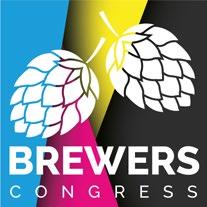
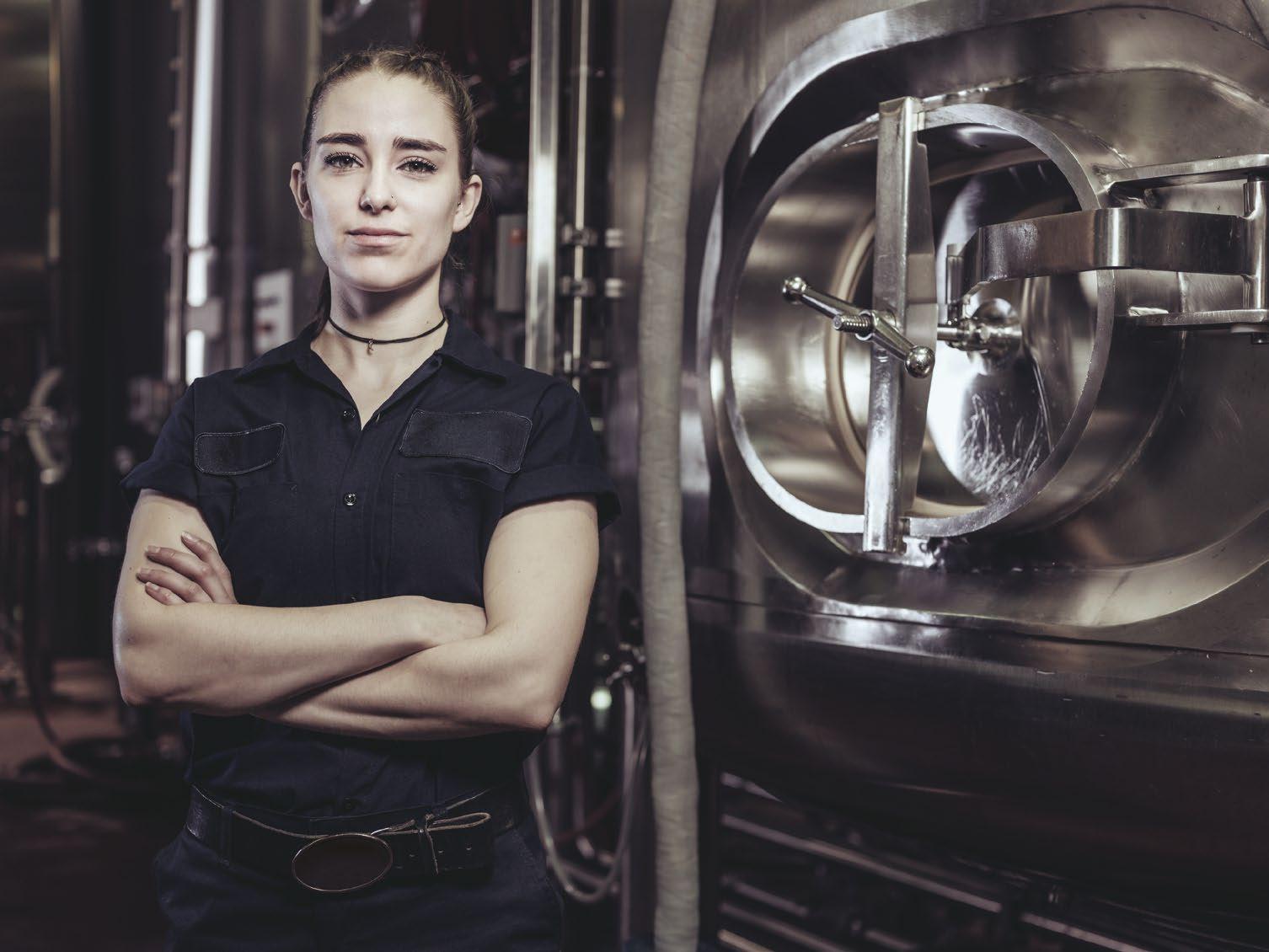






Wilderness is a family run brewery based in mid Wales, founded n 2017. They don’t rush into things, instead preferring to let nature do the talking. They make wild little beers and co-ferments, experimenting with new ingredients, seasonality, barrel ageing, and mixed fermentation. They brew and package all of their beer in house, and condition in bottles or cans. They brew & package everything by hand, in house all can, keg or bottle conditioned and they use their own fruit, grown in their orchard or harvested by the team.
Supported by Potter
ClarksonGreat branding helps sell beer. Now we have that revelation out of the way, we want this category to showcase the stunning array of design that breweries leverage to brand their beers. From the striking to the subtle, modern beer is blessed with some truly impressive branding; from the work that graces bottles and cans to keg founts, cask badges and beyond.
In 2020 the team developed their nitro-porter London Black. A modern interpretation of London Porters, poured on nitro to give a smooth head. It’s full of flavour and marketed as their local alternative to macro stouts. In the beginning there was no specific glassware - but it was still a good looking pint, even in their standard Anspach & Hobday glass. To take this beer to

the next level of brand presence they needed to develop a truly great glass, one which could capture the brand and proposition of the beer. They very consciously decided that Guinness “used to have it right”. They said the tulip works perfectly evoking London’s Porter past. The 20oz tulip strikes the balance between craft beer and heritage: Just like London Black.
Corinium Ales branding is a celebration of Cirencester, and its Roman and brewing heritage. Cirencester (Corinium) was not only the second largest Roman town to London (Londinium), but in the late 1700s, Cirencester Brewery was one of the most complete breweries of its size outside of London. Their family of award-winning ales with a Roman themed names and numbers and links to local history make a worthy contribution to Cirencester’s strong sense of place tying up the brand with location that has huge appeal to the customers who say it is “eye-catching, attractive and has an identity that is among the best”.
After rightly focusing on elevating the quality of their beers over the past 24 months – and they do feel they have created a great foundation to build on – a consistent and quality look was the next logical step, to now represent the quality of the beer they produce. In January 2022 they employed the services of Ryan Plews and the team at
WeAreBrandd, to help them visualise all of these emotional and often practical wants. So now, they say, you hopefully see a lot less clutter and noise, which makes their beers not just simpler to recognise but, more importantly, accessible to everyone.
They said they know this can possibly come across as fairly bland or mainstream, but a massive pet peeve of theirs is the alienating nature of certain brands, excluding not just potential customers but so many communities and walks of life.

WELCOME TO THE 2023 BREWERS CONGRESS
HERE YOU’LL GET THE FULL LOWDOWN ON THE WEALTH OF TALENT AND BEST-IN-CLASS BUSINESSES TAKING PART IN THIS YEAR’S EVENT
Manufacturers and suppliers from the world of ingredients, packaging, capital equipment. software, measurement, analysis, branding and more are all taking part in the biggest Brewers Congress to date. So here is a glimpse of variety of innovation you can expect at the October event.

Analox (Stand 917) has worked shoulder to shoulder with the beverage and hospitality industry for over 30 years. They provide gas monitors to the industry supply chains, to breweries, wineries, fermentation plants, pubs, bars, restaurants - all the way down the ladder to end-users. From fixed to portable monitors, Analox has the right solution for you. Anton Paar (Stand 517) develops, produces and distributes highly accurate laboratory instruments as well as process measuring systems and provides custom-tailored automation and robotics solutions worldwide.
Bevcraft Group (Stand 503) is the European leader in craft can packaging, with operations in the UK, Ireland, the Netherlands and Norway that handle 100m cans per year. They look forward to showcasing their comprehensive range of can decoration, filling, distribution, digital printing, wholesale depots and quality control labs for craft beverage producers. Breww (Stand 113) is cloudbased, allowing you to run your brewery from your computer, tablet or phone. Trusted by over 400 breweries, Breww understands the complexity of running your business. With over 25 integrations, from e-commerce and accounting platforms to marketing and fermentation monitoring, Breww puts you in control of your stock, sales, distribution, duty and profits.
Cara Technology (Stand 107) specialises in process consultancy for breweries. They carry out technical audits of brands, production methods, production activities, quality management activities and other aspects of brewery operations that impact on production including hygiene management and beer loss management. For over two decades the Carling Partnership (Stand 417) has been the leading name in recruitment, specialising in the drinks sector. They offer unrivalled access to the industry, a deep understanding of the sector’s demands and a thorough and personal ap-proach. The result? Placements that are right for the job, right for the culture and right for the per-son.
Charles Faram (Stand 403) have one of the largest ranges of hop varieties available in nitrogen-flushed leaf, T90 and T45 pellets, while their Hop
Development Program continues to produce new aromas and flavours. They offer maximum diversity through ingredients for every type and style of beer, as well as free technical advice and educational events.
Close Brothers (Stand 305) are brewery industry specialists offering tailored solutions for kegs, casks and drinks equipment. They work with brewers and distillers of all sizes to provide keg and cask rentals, container maintenance services and equipment finance solutions. They can incorporate any combination of services into tailored agreements to meet the needs of your business.
At Collective Motion Brewing (Stand 901), their brand new machines are manufactured in the UK by a highly skilled team of process and control engineers. All 2nd hand machinery
undergoes a strict multipoint check, to make sure you get the best quality machines at affordable prices. They buy, sell, service, and repair all packaging machinery including brands like Brewology, Microdat, MD engineering, Gruber, Comac, Cask Force, Lambrechts, Gimson, m+f Keg Technik, and many others.
Corosys (Stand 415) is a manufacturer of process equipment and automation solutions. They think out of the box with innovations like carbonation directly post centrifuge, CO2-free water deaeration, flexible dealcoholization or mulitstream blending. Their #customcoldblock has a lot to discover. They look forward to your visit and your next challenges to take on! The Craft Distilling Business LTD (CDB), (Stand 303) provides turnkey solutions for craft distillers from the design, commissioning and maintenance of micro-distilleries ranging from 50-500 litres in size, to recipe development, HMRC licensing support, health & safety certification and team training.
Dotmatix Technologies (Stand 217) works with brewers to develop equipment designed to save them time and effort and improve efficiency and quality control. This equipment monitors present gravity in real-time, removing the need to take regular beer samples during fermentation. Dotmatix also supplies remote temperature monitoring and control for fermenters. Easi-Keg Solutions Ltd (Stand 605) is a cleaning, maintenance and repair service for the beverage industry. They use the latest technologies, to reduce their environmental impact on the world. They are a fully mobile provider, with the ability to clean and service kegs/casks at customer sites. As well as sites in the North and South of the country.
Since 1977 Enterprise Tondelli (Stand 317) have been supplying bottling and canning solutions to the brewing and spirits industries. Whether you need a complete line or a single machine Enterprise Tondelli have the answer. From 1,500 bottles/cans per hour to 80,000 bottles/cans per hour.
Fermentis (Stand 405) is a Business
Unit of the Lesaffre Group working with everyone in the world of beer, wine, spirits and other fermented beverages. Its range of products and services covers al-most all professional requirements: from safeguarding production to expressing sensory characteristics. Its mission? Become the obvious choice for brewers, winemakers and all producers of fermented beverages.
At Festival Glass (Stand 015) they understand the importance of attention to detail as well as your brands first impression. They believe these are critical ingredients for the recipe of your perfect pint. Their passion is creating bespoke printed drinking glassware and take great pride to be involved in providing a unique platform to promote your brand.
At Figura Analytics (Stand 603) they count particles, of all shapes and sizes, to give you a ‘fingerprint’ of what your beer should look like at different stages of the production process. Using the Figura Analyser you can check that you beer is in spec and compare from batch to batch or brand to brand, as well as rapidly identifying abnormalities and potential contaminants, from bacteria to wild yeast. Seeing and understanding your brands like never before will help you do what you do best, brewing great beer.
FOSS (Stand 315) specialises in providing rapid analytical equipment for the beer & wine industries. From busy wine laboratories serving hundreds of customers to small-volume craft beer pro-ducers with little time for analysis. FOSS helps you exploit the power of routine analysis to complement your skills, experience and knowledge. HIT Training (Stand 515) is the market leading specialist apprenticeship and training provider for the UK’s hospitality, catering & retail industries. Working in partnership with sector employers, they improve employees’ skills, increasing efficiency and productivity, enabling innovation whilst boosting your bottom line.
Hopsteiner (Stand 203) is a vertically integrated global hops supplier dedicated to delivering the finest hops and hop products available. Founded in 1845, Hopsteiner is a sixth-generation
grower that continues to advance the industry as one of the foremost international hop growing, breeding, trading, and processing firms in the world. Hopsteiner ships hops globally and partners with breweries of all sizes, offering unique hop varieties and innovative hop products designed to enhance flavor, aroma, consistency, and flexibility for brewing and beyond. i-keg, (Stand 501) an innovative keg and cask range offering not only robust and safe beverage distribution but also optional IOT technology, providing location and beverage data 24/7.
Innovus Engineering (Stand 313) design and manufacture canning equipment ideally suited to the craft end of the market, with fully automatic filling and seaming machines at 900 to 4000 cans per hour. Recent installations include beer, kombucha, spring water and ready-to-drink. Innovus also manufacture complementary equipment such as depalletisers, labellers, infeed and collection tables - all available to maximise automation of the canning line.
At Keg Logistics (Stand 001) they have the kegs you want, and the flexibility you need. For startups & national brewers, there are mix and match keg programs to meet your brewery’s needs. Rent-to-Own – grow your fleet with flexible finance terms, ownership on your timetable, a custom-branded 30 year asset. FlexTerm-Rental – meet seasonal demand, limit long term exposure with short term rental. For export kegs – protect your beer with stainless steel kegs, that ship to North America and Europe in US 1/6th or 30L options.
Kegstar (Stand 713) with the backing of their parent company MicroStar, partners with brewers by delivering a more efficient and sustainable keg supply chain. Rather than owning, leasing or using difficult to recycle single-use plastic kegs, brewers share high-quality Kegstar branded kegs. Through this highly circular model, they together reduce the distance empty kegs travel.
Continual investment in technical innovation, biotechnology, digitalisation,
sustainability, and support services ensures Kersia UK (Stand 505), part of the Kersia Global Group, leads the field in brewery & beverage, food processing, dairy, and foodservice & facilities. Kersia continues to deliver CIP and hygiene solutions through revolutionary technology and an unparalleled commitment to service levels. OneCircle is the producer of KeyKeg (Stand 617) which is the highest quality PET Keg globally. KeyKeg is circular by design and all KeyKegs currently contain 50% recycled materials. They are a family run business with production locations globally, their UK production site is located in County Durham. They work with a large selection of beverage types and their aim is to provide packaging that keeps their customers beverages as fresh as the day they were produced.
Konvoy (Stand 107) is a leading keg tracking and keg pooling solution. They provide Internet of Things (IoT) enabled keg management solutions, connecting producers with venues and back again. They provide keg rental, keg tracking and keg services. They are here for your beer; enabling more efficiency, effectiveness, circularity and quality. They are here to move beverages forward.
Lallemand Brewing (Stand 307) is positioned to help your brewery achieve its growth and quality goals. Beyond an unparalleled global technical support

and expertise, they offer an extensive range of products, services and education. Whether you are a startup, a global leader in beer production or anywhere in between, they have something for you.
Muntons (Stand 703) is a UK-based manufacturer and global supplier of world-class malts and malted ingredients. It provides a full portfolio of sustainable brewing malts, from crushed malt in sacks to the whole malt in bulk. Muntons’ brewing technology experts help breweries wanting sup-port with areas including recipe development. Regarded as the world’s greenest maltster, Muntons puts sustainability at the heart of everything we do. They work hand in hand with our suppliers and customers to lead the industry with sustainable malting methods, reducing carbon and conserving our natural resources from grain to glass.
NOMOQ (Stand 013) stands for NO Minimum Order Quantity. They make ‘1’ the new minimum order to help you, whether you are a big or small brand, to pack your drink in state-of-the-art cans. They are no ordinary digital printing company. They love turning aluminium cans into works of art, so your great drink gets the packaging it deserves. You deserve more than average-looking cans.
For over 20 years Oasthouse Engineering
(Stand 701) have been servicing the food, beverage and drinks dispense industries. They have worked to secure partnership with some of the best manufac-turers of packaging equipment, as well significantly investing in our own originally engineered machinery. Currently, one of the key services they offer is can supply. Whether it be bright, labelled, sleeved or printed cans, they can do it!
Optimum Flooring Services (Stand 717) are specialist flooring contractors to the brewing industry. Seamless, hygienic resin flooring systems. Custom made stainless steel drainage systems. Whiterock & PIR hygienic food safe panels. Chillers, freezers and cold room storage units. Plaato (Stand 117) is on a mission to change the beverage industry through affordable award-winning sensor technology. They are partnering with hundreds of breweries, cideries, meaderies, and distilleries in over 30 countries and 36 US states.
For more than 130 years, Pneumatic Scale Angelus (PSA) (Stand 513) has leveraged our expertise in high-speed canning to innovate in the design and development of filling and seaming solu-tions. But innovation doesn’t stop there... They have scaled their designs to meet the needs of craft brewers so you can innovate too, offering open air and counter-pressure systems in inline and rotary configurations that operate at variable speeds from 15 to 120 CPM. Investing in a canning line is a major decision - choose the partner who will help you grow.
Specialising in the hospitality trade, The Proton Group (Stand 905) a UK hygiene and chemical manufacturer. They are known for innovation and have successfully launched a new cellar technicians range. ‘Stingray’ has just saved Wimbledon £12,273.05 in replacing tainted lines, come and speak to us to find out more.
Whether for beer, wine, soft drinks, coffee or water, as a full-range supplier, Schäfer Container Systems (Stand 005) has the right reusable keg for every beverage. All
over the world millions of Schäfer KEGs are used by internationally renowned beverage produc-ers as well as small regional businesses. They manufacture exclusively reusable products on the basis of high-grade stainless steel.
Founded in 1862, Simpsons Malt (Stand 615) is one of the largest independent, family-owned malting companies in the world with the capacity to produce around 300,000 tonnes of malt per year at its two malting sites. The company’s passion is a focus on making malts with taste, flavour and consistently high quality with the world’s best brewers and distillers in mind, helping them to craft the finest beers and whiskies. In November 2021, Simpsons Malt became a Certified B Corporation with a score of 89.6 points.
SSV Ltd (Stand 817) tanks are made by Lehui, China’s second largest brewery manufacturer with nearly 30 years experience trading. They are the sole UK distributor for their craft brewing equipment, and this close relationship is at the heart of their mission to get people brewing. Lehui equipment is trusted by global brands, like Heineken and InBev, and it’s trusted by SSV Limited too. Everything is fully certified to UK and EU standards, of course. The tanks are made from SS304 or SS316 Grade stainless steel, sourced from a single connected steel mill. All traceable, trackable and transparent. But you’re not buying from China. You’re buying from SSV Limited, and they’re registered and incorporated in the UK.
Thomas Fawcett & Sons Ltd (Stand 401) is a seventh generation family business that has been manufacturing quality malts for over 200 years on its original site in Castleford, West Yorkshire. The company’s production facilities span its history from four working floor maltings to the most up to date Germinating & Kilning Vessels (GKV). Coloured malts of all hues and flavours are produced from its bespoke roasting plants. Batch sizes remain small to ensure consistent quality throughout an extensive product range. The company manufactures over 30 different malts on site and can supply
small quantities of other key brewing adjuncts, Peated Malt, Smoked Malt, Torrefied Wheat, Flaked Maize and Flaked Barley. Trafalgar Scientific (Stand 915)—are a laboratory supplies company , that specialises in Microbiology and Analytical Consumables, aimed at the brewing industry. From HAACP verification using ATP swabbing , to setting up a full microbiology and QC lab. Trafalgar Scientific, can offer the full range of products. They have more than 30 years of supplying hygiene and laboratory capital and consumables into breweries – they can offer the full range of both equipment and consumables that you will use.
Vale Labels (Stand 301) print high quality labels for breweries across the UK. Their experts use the latest print technology to help these customers stand out and work closely with their teams to ensure they get the best value and finish on every order. White Labs (Stand 009) is a leading provider of yeast and fermentation solutions for all of your brewing needs. From the highest quality liquid and dry yeast to yeast nutrients and educational resources, they have got you covered. Trading since 1970, Willis (Stand 507) have developed into one of the UK’s leading suppliers of branded POS Bar products. Working with some of the world’s leading brands we have carefully developed ranges to suit all drinks sectors and venues. Their product range caters for all budgets and covers both standard items as well as bespoke developments. It is impossible for them to illustrate every single product they have produced but hopefully their site will give you a good feel for what they can offer. With their in-house manufacturing and design facility they can provide your brand and company with “the Total Branded POS Solution.”

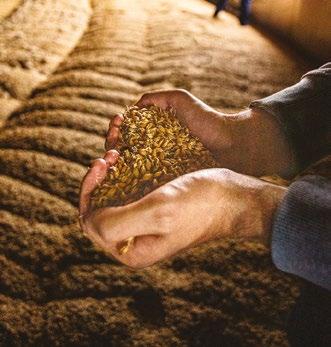



The team here at The Brewers Journal has long believed in one international language, and that’s the language of beer. We are thrilled that brewers and those involved in-and-around beer from across the globe both attend The Brewers Congress and also share their expertise on stage.
This year, we welcome our keynote Basil Lee. Basil is the co-founder of Finback Brewery located in New York City. He is passionate about creativity in beer. The brewery embarked on a project of brewing exceptional beers through iteration and rotation deploying a variety of hops, ingredients, and techniques as a creative journey in bringing unique beers to the consumer. With a previous career in design, Basil brought strong training in process and collaboration in building Finback as an engaging beer experience.
Speaking in London is Emma Reynolds who started Tonkotsu in 2011, which has since grown to 17 restaurants across the UK employing 280 staff. Also speaking is Georgina Young, a brewing director, overseeing brewing and operations at St Austell Brewery and Bath Ales. As brand ambassador for Heaven Hill, one of the biggest whiskey distilleries in the World, Chris Smith has spent his time living, breathing, and educating people about Bourbon, Rye, and Corn Whiskey.
Taking part is Roman Jove who founded of Cervecera Peninsula in 2017 in Madrid, Spain. A graduate of UC Davis in California, he lives and breathes beer. Speaking this year is James Heffron, the co-founder and head brewer at Verdant Brewing Co of Penryn, Cornwall. Heffron is fanatical about flavour and how to successfully deliver it to the consumer. In his own words, he’s never satisfied, always searching for improvement and always searching for more flavour. Along with his team, Heffron has ensured that Verdant are one of the UK’s most regarded breweries.
Speaking in London is Tanya Kondratyuk, the quality manager at Northern Monk in Leeds. Starting her career at Goose Island Brewery, based in Chicago, IL, she has since designed and supervised the buildout of the new QC laboratory at Northern Monk, launching he current analytical and microbiological sampling programs, yeast propagation plan, sensory panels, barrel aging program, as well as taking a part in production planning and recipe development.
We will hear from Mauritz Borg who is a pillar of the capital’s beer scene. He has worked in beer-focused bars in London for the last decade is currently at The Kernel in Bermondsey. Joining the line-up in 2023 is the brilliant brewer Alice Batham. Alice is the head brewer at Bathams, the revered brewery based in Brierley Hill, England. Formerly a brewer at Brewsters and Thornbridge, Alice is the first female head brewer at the West Midlands business, which was established in 1877. Alongside her sister Claire, they are leading the Black Country brewery into its next stage. Joining the discussion this year is Alex Lippens the co-founder of Brouwerij ‘t Verzet based in Anzegem, Belgium and also Rob Lovatt, a revered brewer who is the production director at Thornbridge.
Michael Knoth is a master brewer trained at Weihenstephan and the Scandinavian School of Brewing. His journey began at Carlsberg, Denmark before serving as the global production manager at Mikkeller and as the brewery manager at To Øl. In June 2023, he returned to his consultancy role at Craft Brewing Consult, with a track record of aiding nearly 20 brewers in establishing a craft brewery and assisting numerous others in expansion and optimization endeavours.
Gaïa Freytag is the Quality Manager at Beavertown Brewery, where she is responsible for quality control and assurance while also contributing to new product development and
CONGRESS TAKES PRIDE IN GIVING A PLATFORM TO BESTIN-CLASS TALENT FROM THE ACROSS THE WORLD OF BEER AND BREWING. AND IN 2023, THAT’S NO DIFFERENT. HERE’S A TASTER OF SOME OF THIS YEAR’S SPEAKERS AND PANELISTS TAKING PLACE THIS OCTOBER.
Clockwise from top far left: Stephanie Brindley, Basil Lee, Alex Lippens, Alice Batham, Andy Parker, Tim O’ Rourke, Chris Smith, Colin Stronge and Mauritz Borg.




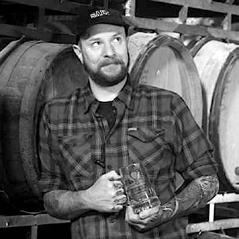
Clockwise from top far left: Matt Servini, James Collier, Janos De Baets, Emma Reynolds, Georgina Young, Jessica Maye, Melissa Cole, John Keeling, Jim Wilson, James Heffron, Gaïa Freytag, Luca Lorenzoni, Amber Thorne and Barry Watts.

Clockwise from far left: Michael Knoth, Paul Davies, Tanya Kondratyuk, Roman Jove, Hayley Pearce, Des de Moor, Rob Lovatt, Verity Phillips and Todd Isbell.
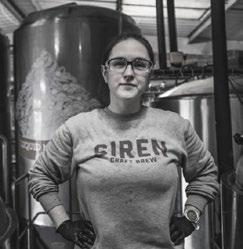

















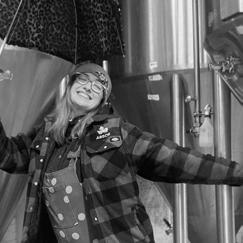






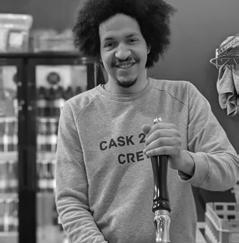
innovation, while her colleague Jessica Maye is the brewery’s SHE compliance manager. Jessica manages Food Safety, Health & Safety and Environment & Sustainability across the brewery’s sites and is passionate about making a positive impact through cross-functional engagement and ever evolving systems.
Speaking in London is Luca Lorenzoni. Luca has spent the last six years as CEO of two of the UK’s fastest growing craft breweries: Camden Town Brewery, and most recently Northern Monk. Prior to his time in the UK, Luca spent 10 years at AB InBev working in the Canadian, European and global businesses. Now, he’s taking the learnings from those experiences to help craft breweries evolve within the market we now find ourselves in.
Chairing proceedings in London is the award-winning writer Melissa Cole. Her passion in life is getting people to learn as little, or as much, as they want about what she considers the finest social lubricant known to humankind – beer. Also lending his expert panel chairing expertise is John Keeling, formerly of Fuller’s. During his time in West London, he held various positions culminating in his promotion to brewing director in April 1999. Now retired, he predictably remains in demand across the globe judging competitions, delivering talks and hosting beer tastings.
Paul Davies is the founder of awardwinning AleHunters Brewery Tours, taking thirsty enthusiasts to tours of London’s craft breweries and iconic pubs plus hosting tours to Belgium’s best breweries and beer festivals. Speaking with brewers from Belgium and the UK, he’ll look at the state of play in the world of cask and what we can do to help ensure this cherished sector can survive, and thrive.
If you know good beer you know Colin Stronge. The head brewer at SALT and the winner of our ‘Brewer of the Year’ accolade in 2022, he has invented beer styles, lighting the way for new breweries, dishing out advice, support and encouragement to new and existing brewers as well as being an excellent allaround brewer.
Also speaking is Matt Servini, co-founder of The Craft Distilling Business. Originally trained as a Biochemist he has 25+ years of experience working in the food & drinks industry. In the last seven years, the business has built and commissioned more than 150 craft distilleries in the UK and abroad.
Verity Phillips is the Media Lead at Asahi UK, working across a portfolio of premium brands including Peroni Nastro Azzurro, Asahi Super Dry, London Pride and Cornish Orchards, to name a few. Also taking part is Hayley Pearce, a brewer at Siren Craft Brew in Wokingham. Earlier in her career, she joined Fuller’s Graduate Programme and it soon became clear that her future lay in the brewhouse.
Siren’s brewing neighbours are Elusive Brewing and speaking in London is award-winning founder Andy Parker. In 2024 Andy will release a new book with revered brewer and author Jamil Zainasheff. Published by CAMRA, The Modern Homebrewer will cover all the latest products and innovations, covering ingredients, process and equipment.
Joining the discussion is Amber Thorne. Having started her career in beer in the sales team at Siren Craft Brew, she has since moved to the iconic Bristol beer scene working with Good Chemistry and is now the customer account manager at Arbor Ales. Also taking part is Barry Watts, the head of policy and public affairs for the Society of Independent Brewers (SIBA) which represents the UK’s small and independent breweries. He is a former brewer with more than a decade’s worth of experience in lobbying and public affairs.
Speaking in the capital is Janos De Baets, the co-founder and head brewer of Dok Brewing Company in Gent, Belgium. Dok has brewed in its 5 years of existence more different beer styles than any other brewery in the history of Belgium. Sharing his expertise is Des de Moor. One of the UK’s top beer experts, Des is the author of award-winning guidebook London’s Best Beer, Pubs and Bars, a regular writer for CAMRA’s BEER magazine
and a contributor to numerous other magazines, books and websites.
James Collier from Breww has a wealth of experience in understanding the challenges that breweries face in their day-to-day operations, and the critical role technology can play in solving them, while Stephanie Brindley is a brewing scientist with more 10 years of experience in the industry and is passionate about the science, creativity, and social aspects of beer. Her unique perspective on the brewing industry comes from her background in research, where she studied the nutritional requirements and phenotypic properties of brewing yeast gaining both a Masters and PhD from the University of Nottingham.
Speaking in London is Todd Isbell, a BS in civil and environmental engineering from Clarkson University and is a graduate of the United States Army Chemical School. He has been a professional brewer for twenty years in the United States, has taught fermentation sciences at Rockingham Community College for five years, and was the founding technical chair for the Master Brewers Association of the Americas Carolinas district. He is currently the Senior Brewing Technician at the University of Nottingham and International Centre for Brewing Science.
Also speaking is Jim Wilson who represents Fermentis in the UK. He is involved in sales, business development and technical support for alcoholic beverage producers. As is our colleague here at The Brewers Journal, Tim O’Rourke. Tim is a master brewer with more than 35 years experience and is now the technical editor of our publication.
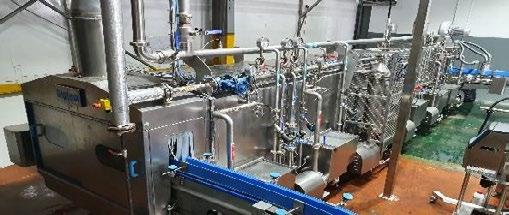
• Want to take control?
• Want short production runs at your convenience?
• Want to reduce product losses at contract packers?

• Want to save transport costs and double handling?
• Want to reduce your carbon footprint?
• Want to control your own hygiene and QA procedures?
• Want improve your packaging?
• Want to save money on labour costs?
• Want to reduce your dissolved oxygen?
You can with an Enterprise Tondelli craft beer Canning, Bottling or Kegging line!
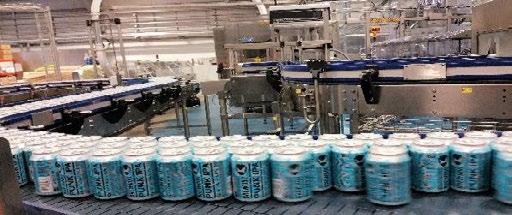
✓ 1,300 cans per hour upwards to 80,000 cph
✓ 1,200 bottles per hour upwards to 60,000 bph
Tel : 01525 718288
E-mail : info@enterprisetondelli.co.uk


✓ 16 kegs per hour upwards to 1,000 kegs per hour

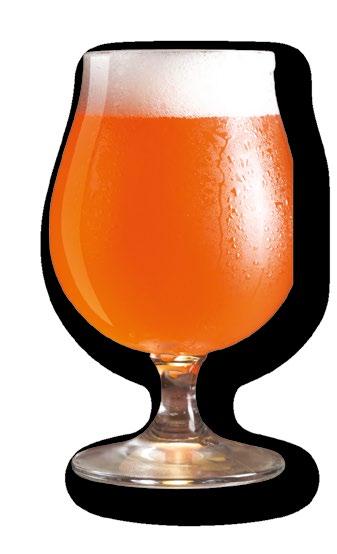
The most popular strain for Hazy/Juicy IPAs. Pineapple and ruby red grapefruit aromas, with hop balance and residual sweetness resulting in a velvety mouthfeel.
Take your IPA to the next level with London Fog today!

or contact us at info@whitelabs.com
THE BREWERS CONGRESS IS SUPPORTED BY BEST-IN-CLASS INDUSTRY SUPPLIERS. HERE YOU CAN LEARN A LITTLE MORE ABOUT THEM. MAKE SURE YOU PAY THEM A VISIT AT THE SHOW






With our proven proprietary cloud based keg tracking devices, flat rate pay-perfill and pay-per-month keg rentals, let konvoy become your keg solution driven by people that are passionate about simplicity, service and sustainability.
With our proven proprietary cloud based keg tracking devices, flat rate pay-perfill and pay-per-month keg rentals, let konvoy become your keg solution driven by people that are passionate about simplicity, service and sustainability.




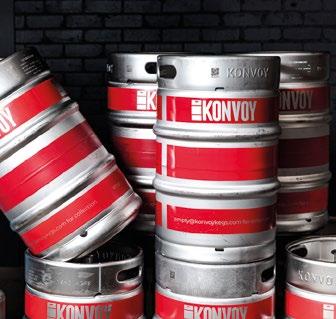
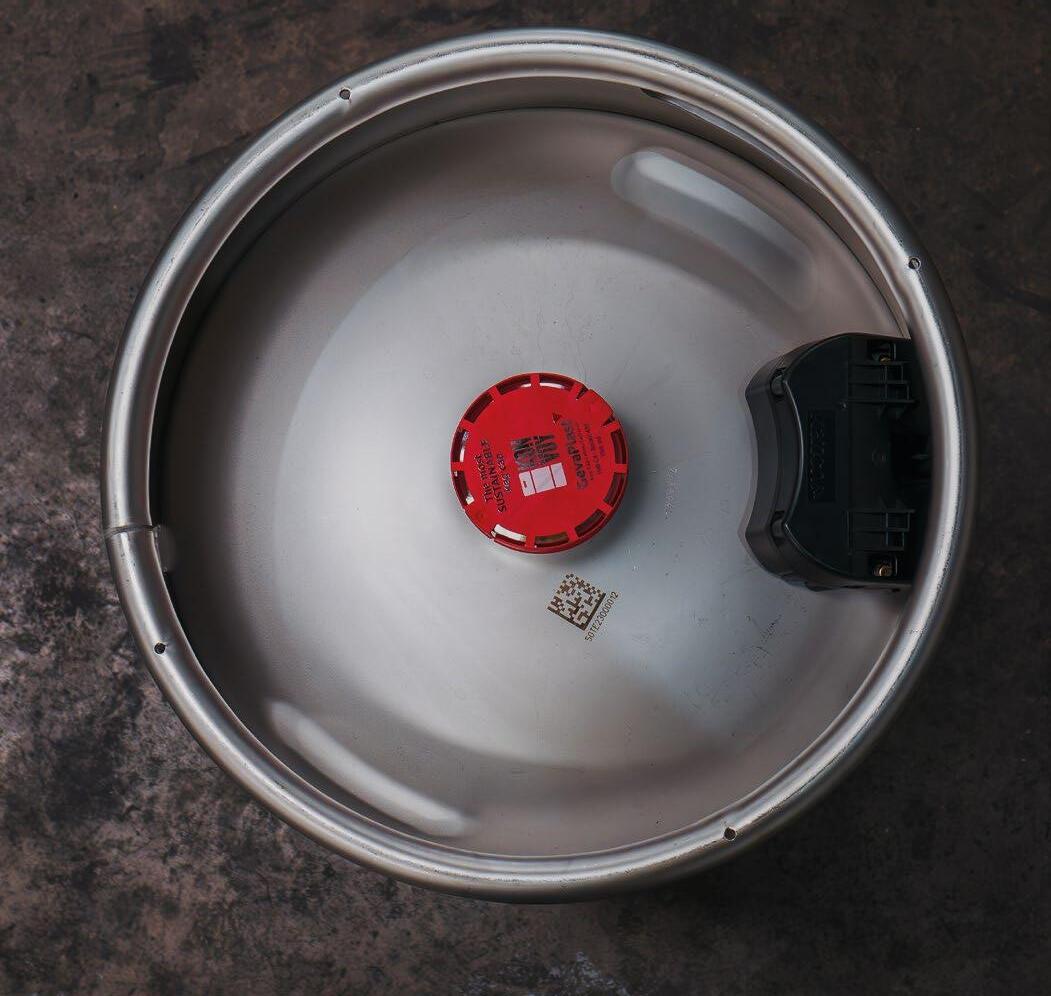



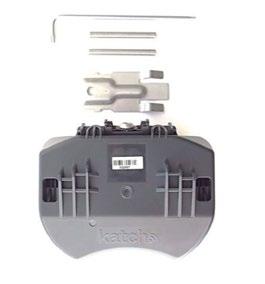
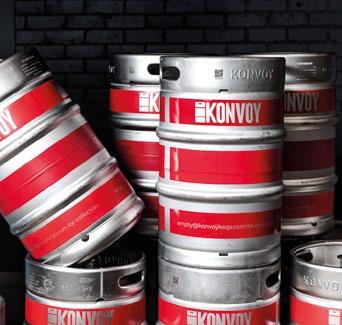
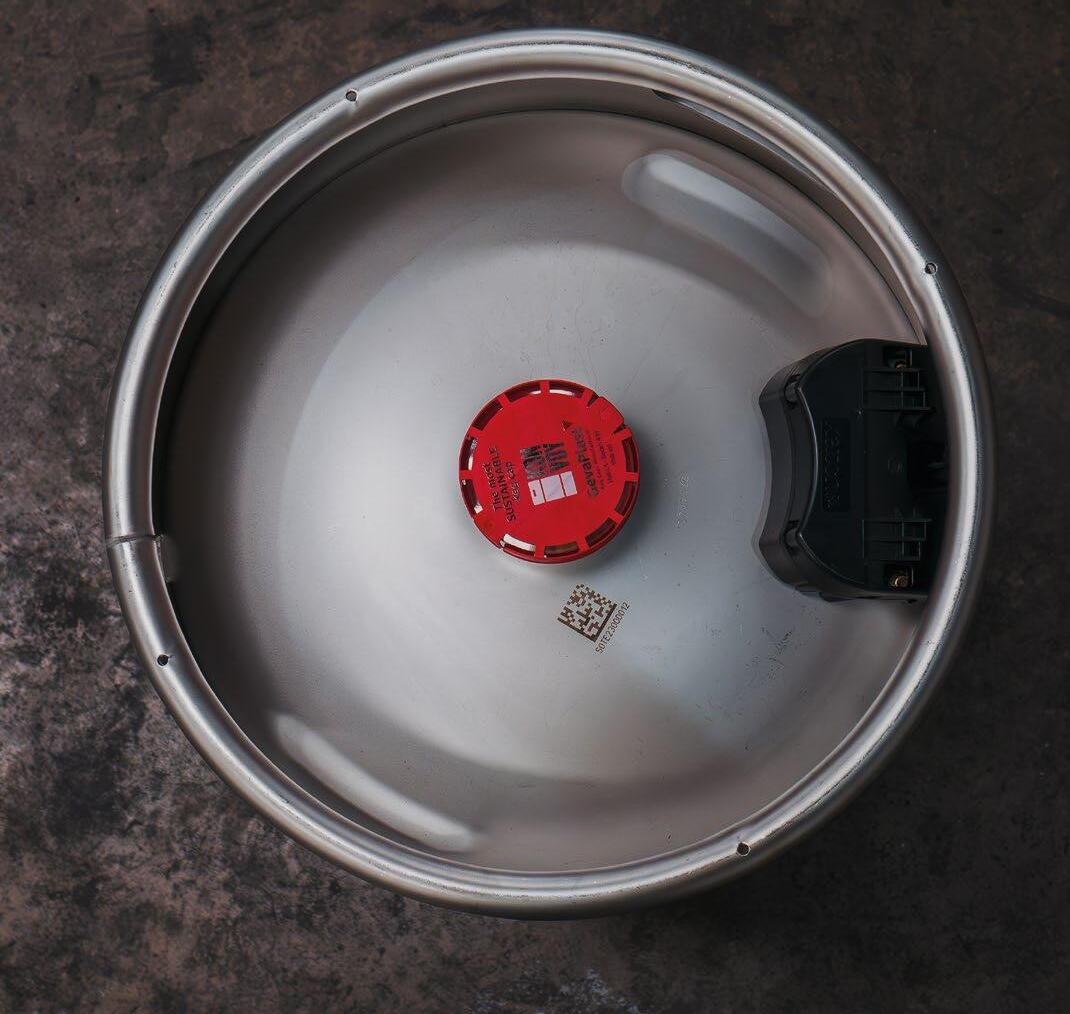






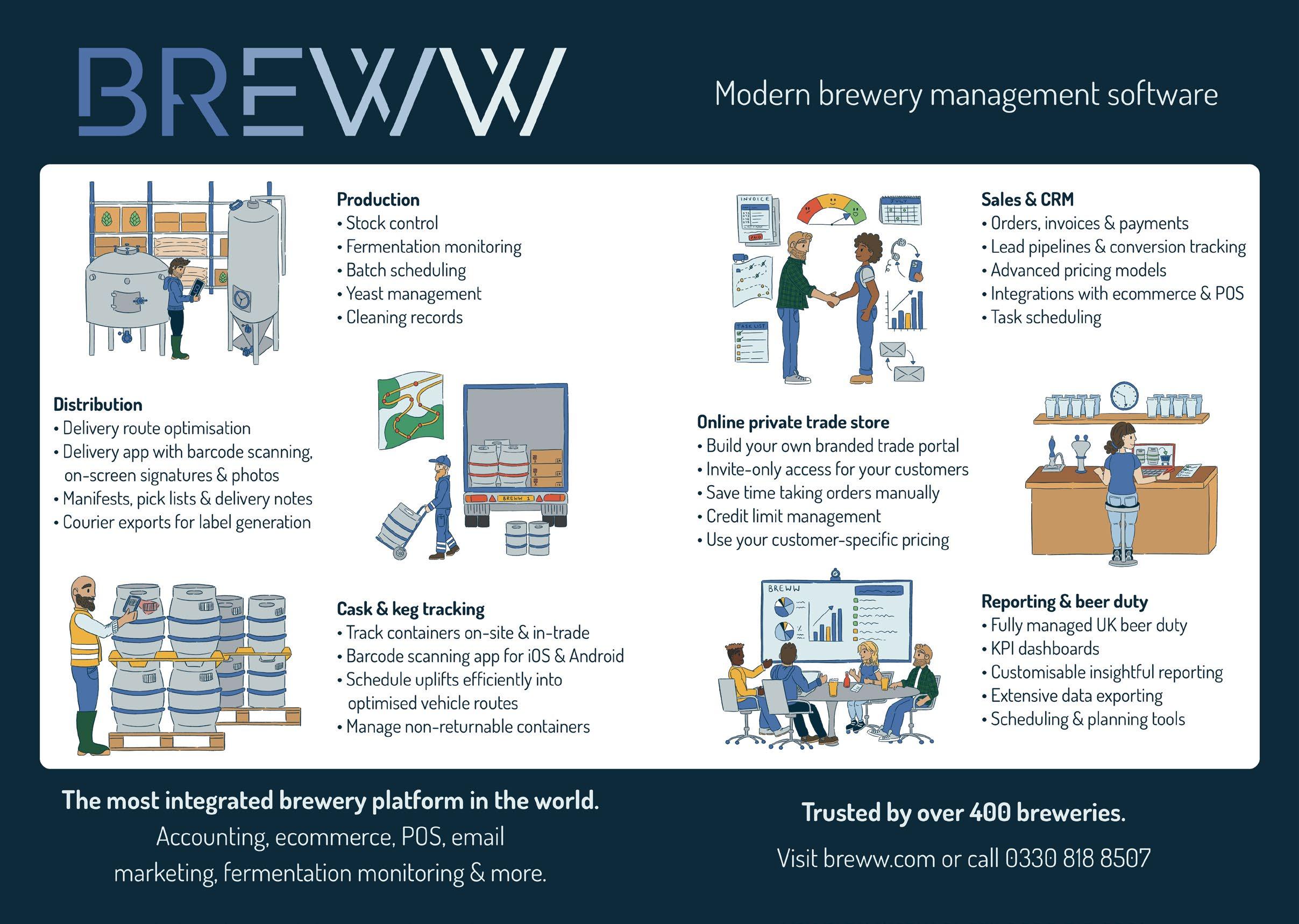

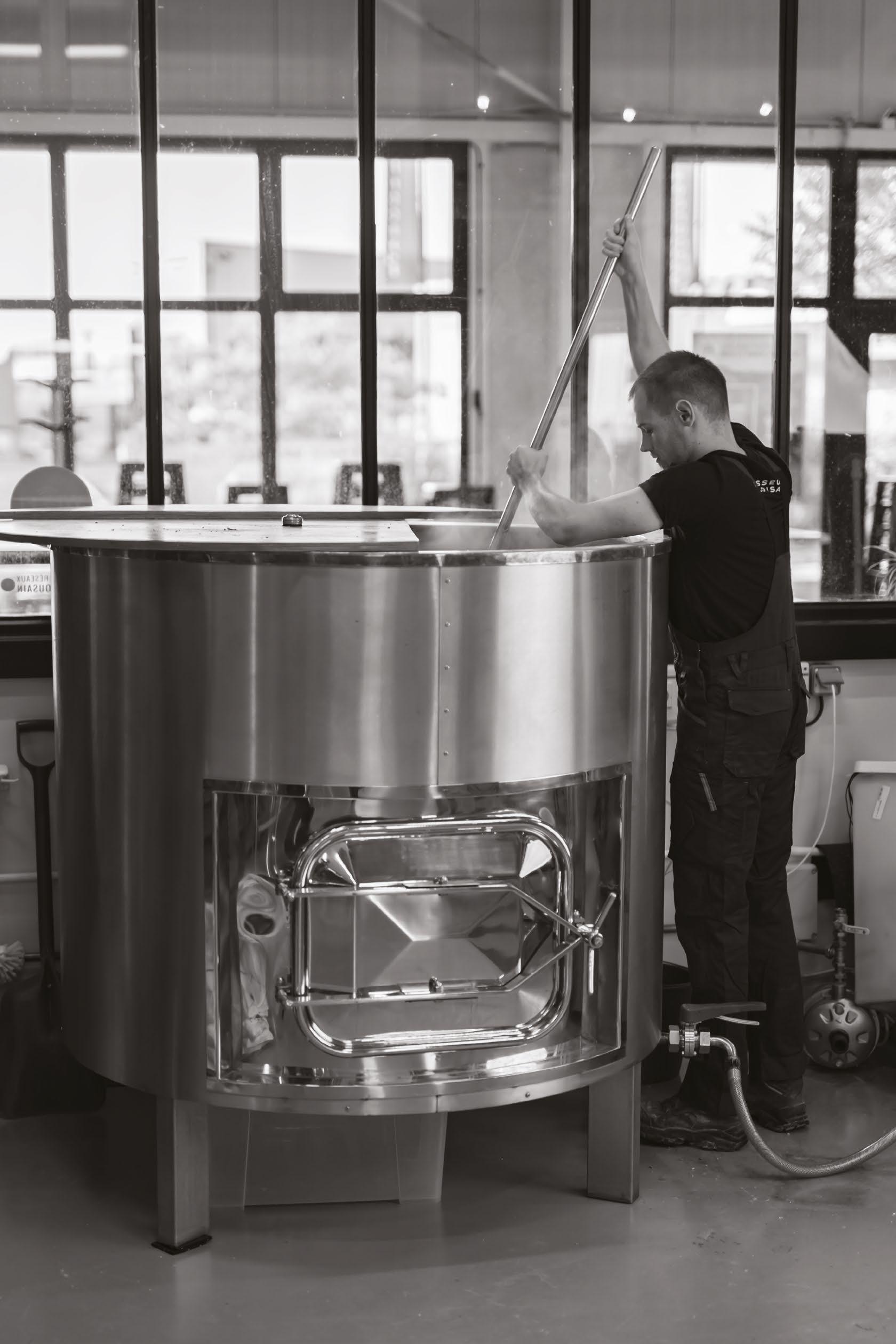
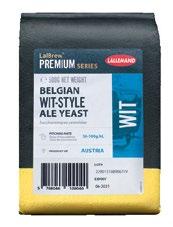
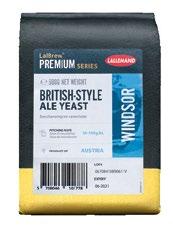
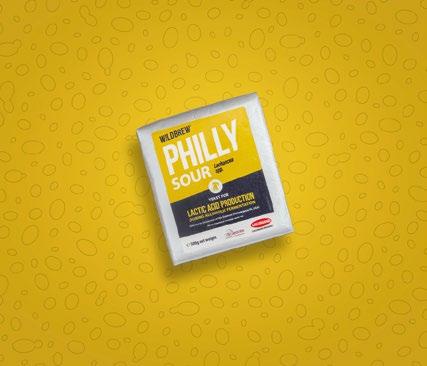
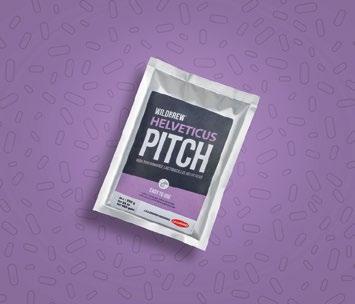

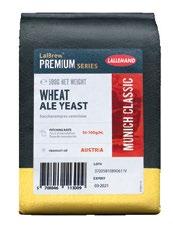
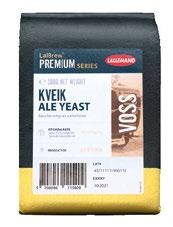
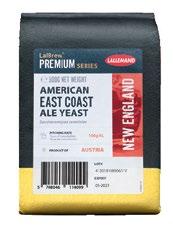
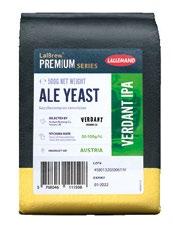
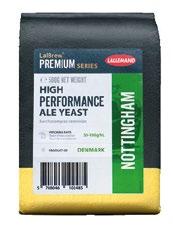
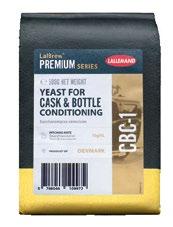
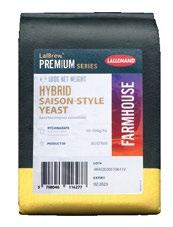
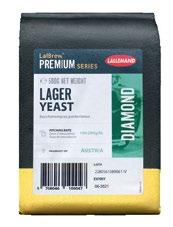



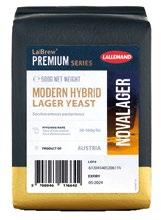

Scan to see our BREWER’S CORNER
STANDARD WORT
78.3 (3.2)
FLOCCULATION Medium
ALCOHOL TOLERANCE 12% ABV
BIOTRANSFORMATION
β-glucosidase Medium
β-lyase High AROMA Apricot, smooth, medium body
ATTENUATION AND STANDARD DEV. IN 12°P STANDARD WORT
68.6 (1.8)
FLOCCULATION Low
ALCOHOL TOLERANCE
12% ABV
BIOTRANSFORMATION
β-glucosidase Medium
β-lyase Low AROMA
Sweet, fruity, full body

ATTENUATION AND STANDARD DEV. IN 12°P STANDARD WORT
83.6 (1.2)
FLOCCULATION High

ALCOHOL TOLERANCE
14% ABV
BIOTRANSFORMATION
β-glucosidase Medium
β-lyase Medium AROMA
Slightly fruity, neutral
Recent research is uncovering how di erent yeast strains can in uence avor and aroma by interacting with speci c hop-derived avor compounds, a process called biotransformation. The Lallemand Brewing R&D lab has identi ed speci c enzyme activities in several LalBrew® Premium strains that are important for biotransformation, including β-glucosidase and β-lyase.
Armed with this data, the brewer is well equipped to choose the best yeast for each IPA style. Lallemand Brewing is at the forefront of hop avor and aroma research and we are ready to help you with any questions about brewing hoppy beer styles.
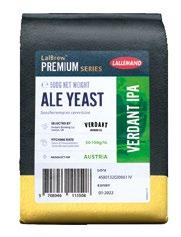

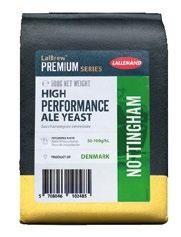



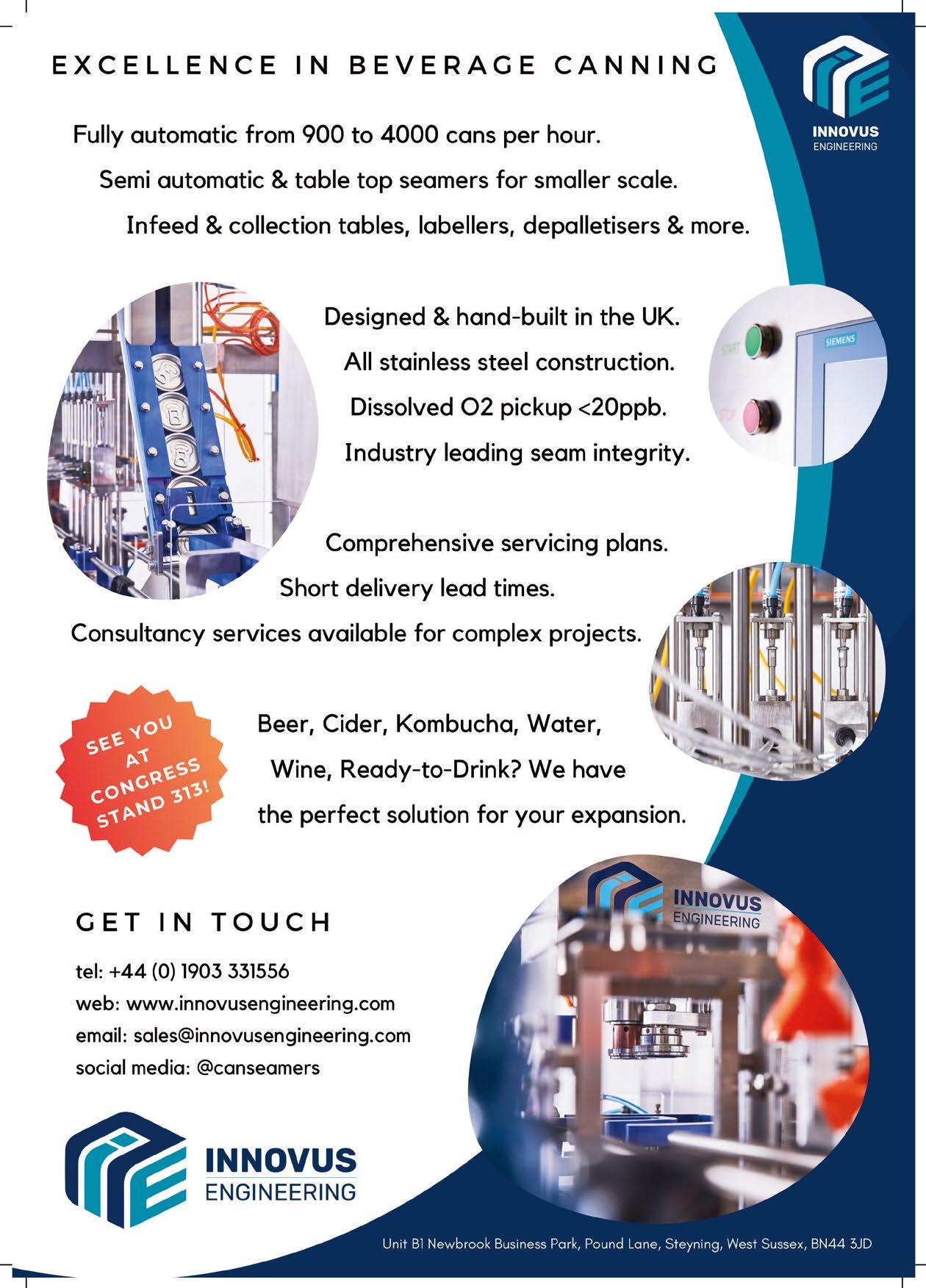


CB50F
Inline Open Air
Up to 50 CPM
CB100F
Inline Open Air

Up to 100 CPM
CB50C
Inline Counter-Pressure
Up to 50 CPM
CB100C
Rotary Counter-Pressure
100+ CPM
INTEGRATED ROTARY COUNTER-PRESSURE FILLING AND ROTARY ANGELUS SEAMING IN A COMPACT FOOTPRINT, OPERATING AT MORE THAN 100 CPM
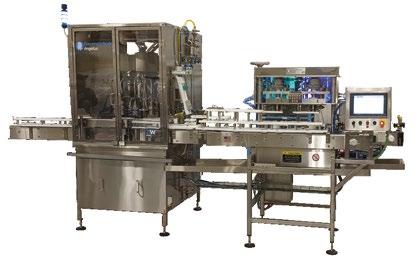
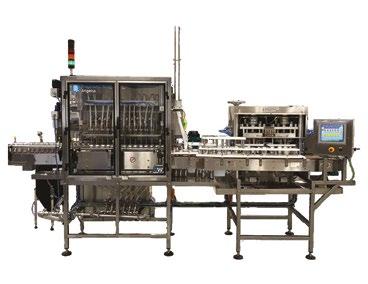

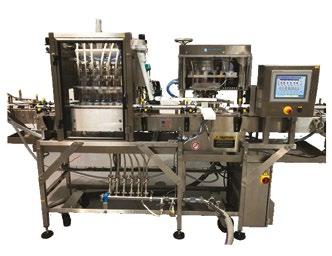

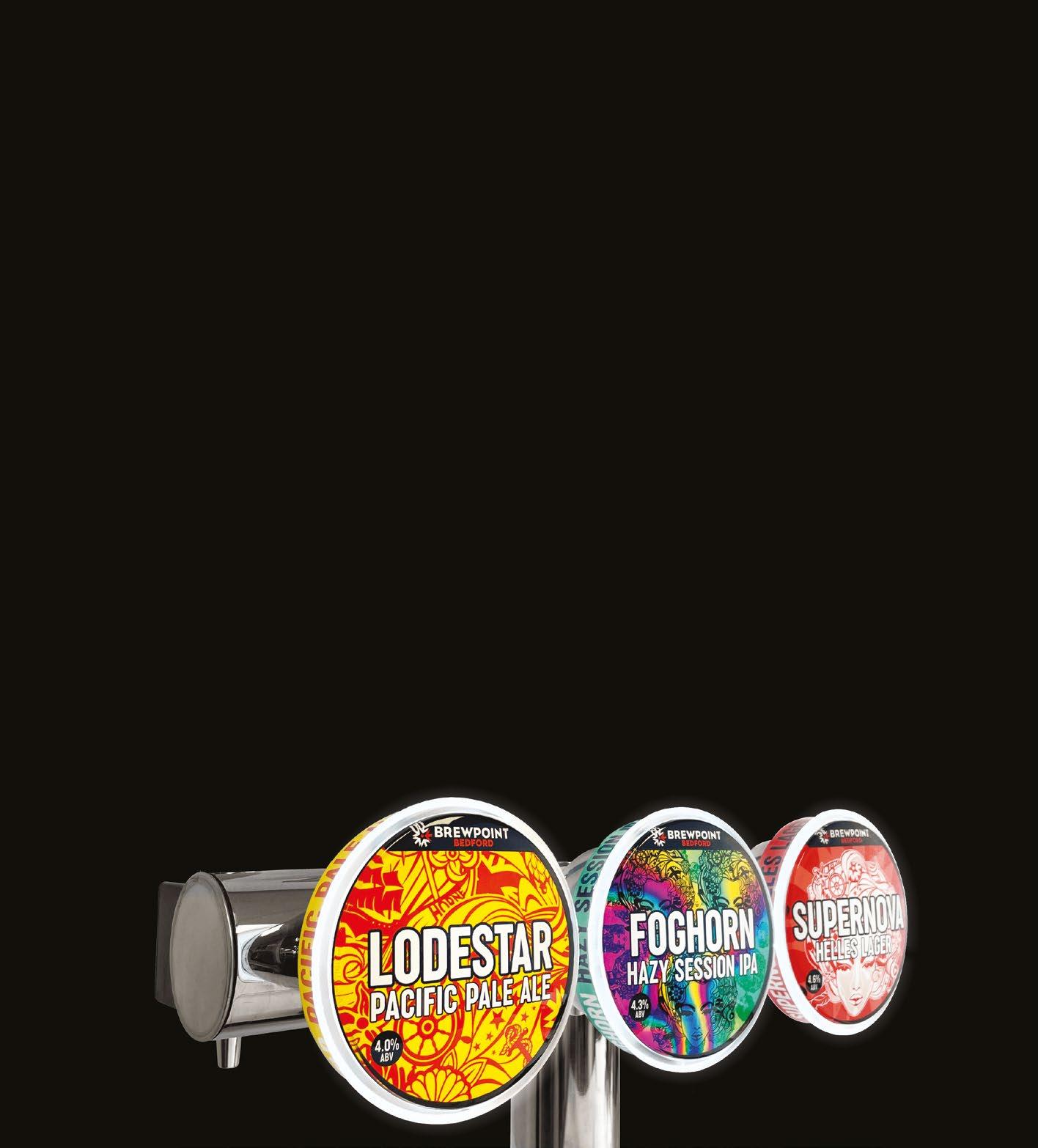
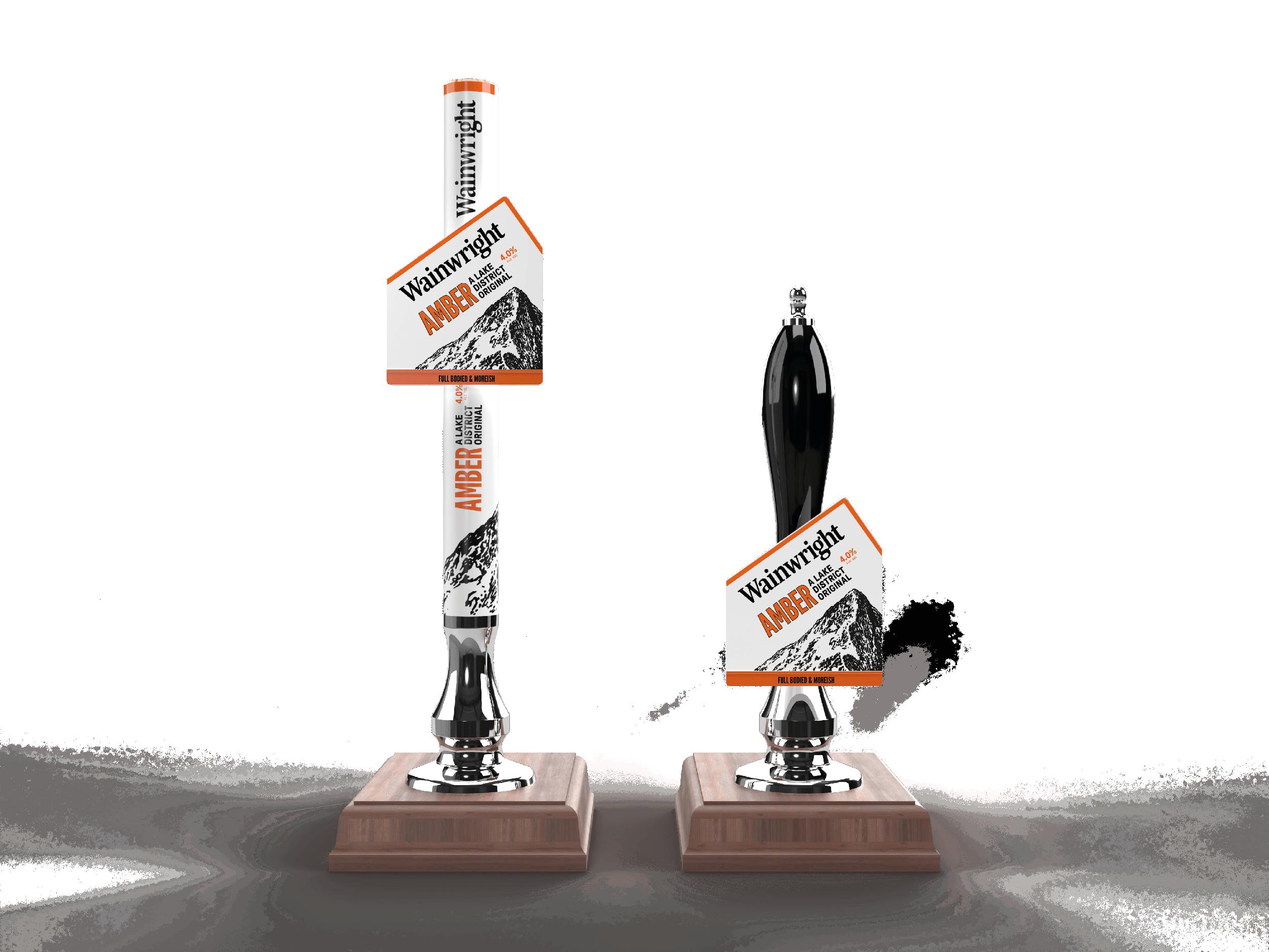




If you read the news, I wouldn’t fault you for concluding that Craft Beer is in trouble. CO2 shortages, ‘oversaturated’ market, unprecedented cost increases, brewery closures…it’s relentless. And on the surface, none of those things are wrong.
But context is missing. Let me frame it up another way: Over the last 15 years in the UK, craft beer production has grown from almost non-existent to over £1.4bn in Revenue in 2022(1). Some bold visionaries developed beers, brands and experiences that clearly nailed an unmet desire of beer drinkers.
Focusing on innovation, authenticity and being more connected to drinkers than ever before, craft breweries opened around the country as demand boomed; and almost no breweries failed. Instead of competition, those in the industry made friendships with other breweries and travelled the world for collaborations, conferences, and festivals. All were for ‘work’, but each was also a social event or celebration.
The world was infatuated with craft beer. Everywhere founders, brewers and employees went, people wanted to hear their story, whether it was at a festival, or meeting up with old friends. Breweries became beacons of their community. Investors took note. Capital was available to expand and meet the insatiable demand of drinkers, and for those that chose to do so, global brewers were looking to snatch up brands to get into the category they couldn’t crack on their own.
Not as gripping a headline as ‘UK Craft Brewery Failures Escalate in Oversaturated Market’, is it? But it’s also all true. When you look at it that way, of course the market was going to saturate… who doesn’t want in on that?
Yes, things are tougher in 2023 than
they were in 2019. But the narrative shouldn’t be about how it’s harder than it was. Saturated doesn’t need to have a negative connotation…most markets are saturated. The narrative needs to shift to: what are you going to do about it?
I worked almost 10 years for AB InBev, the largest and most profitable brewery in the world. I worked on brands and projects in over 25 countries globally, and almost all of them were saturated. I was indoctrinated in the power of efficiency and cost discipline as tools of success in saturated markets, but I also witnessed how to take it too far. For the last 6 years I have run craft breweries in the UK where growth rates were as high as triple digits, but never less than 20%.
Our success was down to incredibly passionate people who tirelessly focused on understanding and connecting with the consumer, and embracing the chaos that is prevalent in less mature, high growth businesses.
Starting from the largest brewery in the world and ending at what was a 12khL brewery in Leeds has given me a perspective on how to succeed, and fail, in both highly saturated and very high growth categories.
As craft transitions from high growth to saturation, I believe the key to success is to double down on what makes your brand, and craft, special, but be open to ways to become more disciplined and mature. Or put another way: Take the best of craft and take the best of macro. That is exactly the goal of this project. I wanted to use my experiences, combined with some research to initiate conversations that will help craft evolve and mature in this way. It is ultimately what I would have wanted when running a craft brewery in 2023.
To make the conversation as practical as possible, I’ve used data on the UK
AS CRAFT TRANSITIONS FROM HIGH GROWTH TO SATURATION, THE KEY TO SUCCESS IS TO DOUBLE DOWN ON WHAT MAKES YOUR BRAND, AND CRAFT, SPECIAL, ARGUES LUCA LORENZONI, WHO HAS SPENT THE LAST SIX YEARS AS CEO OF TWO OF THE UK’S FASTEST GROWING CRAFT BREWERIES: CAMDEN TOWN BREWERY, AND MOST RECENTLY NORTHERN MONK.
market, but if you are from a brewery outside the UK, or someone that has a keen interest in craft breweries, and specifically the economics of it, there are lots of interesting insights to take away. Lastly, this is not intended as an instruction manual full of infallible opinions and solutions. Some parts you will agree with, some parts you may disagree with, some parts may not be relevant for your challenges or goals. The goal is to start what I believe to be a crucial conversation, one that will hopefully continue with industry friends over beers, in your offices or breweries, and in the comments section of this post.
Everyone in craft beer will be familiar with the phrase that the UK is 5 years behind the US. It’s surprising how accurate that statement has been over time. We’re lucky because for us in the UK, looking at the US was like looking into the future of our market.
It inspired many of our breweries, beers, and brands, and as we approach a time where craft beer in the UK needs to evolve, there is no reason we shouldn’t look to our friends in the US again. Well just over 5 years ago, the US craft beer market became saturated. In fact, since 2017, the US craft beer industry has seen an average annual growth rate of just 1.2%(2). At the same time, the UK market was flying; from 2019 to 2022 craft grew over 52% in the Off Trade(3). But here we are, 5 years after the US hit saturation. While new brewery openings in the US began to slow in line with growth, the UK accelerated rapidly, and in 2018 the UK rate of brewery openings first surpassed that of the US. Over the last 5 years, the number of breweries in the UK grew by 38.4%(4), while over that same period, the number of breweries in the US grew 13.5%(5).

Being 5 years behind, we played catch up…and took it even further. The UK now has 1 brewery for every 22k people over 18. In the US this number is 1 brewery for every 27.2k people over 18, and the US has a higher beer consumption per capita than the UK.
Now, admittedly, the effects of that
saturation haven’t yet hit us to the same level as they have in the US, but they are catching up quickly.
The best example of this is closure rates for breweries where in the US the rate is about 3%(6), while in the UK the most recent data show a rate of 1.9% entering insolvency over the last 12 months to April 2023 (up from 0.7% the year prior) (7). But a closer look at one specific economic factor will show why that is where we are heading and potentially exceeding if we don’t adapt quickly: Wealth.
Craft is a premium category. More specifically, the average Off Trade price per litre for craft beer is 76% higher than mainstream beer(8), and that is for craft beer in grocery and convenience (not
including bottleshops).
Outside of these retailers, you’d be challenged to find a 440ml can of craft beer for under £5, which is almost 400% higher than mainstream beer and 270% higher than World/Discovery. To put it simply, it takes wealth, and disposable income, to be a craft beer drinker.
The US has a median income of $54,000 (approx. £42.2k at current exchange), while the UK median income is £33,000(4).
That means the UK’s median income is 22% lower than the US. While this stat
doesn’t consider cost of living factors, I think we can conclude the median consumer in the US has significantly more disposable income to spend on a premium category like craft beer if they choose to do so. And as we’re all aware, this isn’t getting better in the UK. Average living standards have been broadly stagnant in the UK since 2007, with more recent, sticky inflation meaning that since late 2021, real wages (wage growth adjusted for inflation) are in decline.
To compound that gap in wealth, craft beer in the UK is more expensive than in the US. At the most premium end of the market, when price is adjusted for current exchange rate, a 6.5% Hazy IPA from a leading UK Brewery comes in almost 30% more expensive than a similar beer from Other Half (a US Brewery that is considered by many as one of the leading Hazy Breweries in the world). Even on the more entry-level end of craft, buying a beer from Brewdog’s webshop in the UK is over 10% more expensive per ml than the same beer in the US when price is adjusted for currency.
A six pack of Sierra Nevada’s Hazy Little Thing (6.7% and 355ml cans) from Walgreens in the US is £7.82 when adjusted for currency. What a deal. Regardless of channel, craft beer in the UK costs a drinker more than it does in the US.

So I feel confident in concluding that if we don’t evolve, the UK craft beer market will show no / small category growth because craft beer fans that can afford craft beer already buy it, and most UK consumers cannot afford or do not yet care enough about craft beer to give it a try.
You’ll notice to this point I’ve barely mentioned most of the topics that dominate the news headlines and narrative: the significant increase in raw material and utility costs, the on trade performing strongly over the summer, rail strikes, etc.
I don’t want to minimise the impact of these shocks, because I know firsthand the stress and urgency they are causing as you ensure your brewery can mitigate or accelerate from them…but
they are mostly temporary shocks. It will rain more, rail strikes will end, and even inflation will eventually fall, and wages should catch up.
What isn’t temporary is the supply and demand figures I have focused on.
It’s important that we don’t hope for some of these more recent shocks to soften to solve our problems, because even if they do, the bigger challenge is the macroeconomic reality which is here to stay.
We need to react and be agile to overcome the temporary shocks, but we need to evolve and mature to succeed for the long term.
But how can we evolve? A common analogy for discussing the size of a market is to liken it to a pie. Let’s run with that. If you agree with my conclusion, if we do not evolve, the size of our pie may increase/decrease slightly with the temporary shocks, but overall, it will stay around the same size.
The first response to saturation is typically increased competition amongst those in the market for more of that existing pie, and for anyone on social media or brewery mailing lists, you no doubt see this happening.
Brewery sponsored ads are clearly targeting craft beer audiences, and mailers are promoting discounts more than ever before. This makes sense for now, especially in a country where one brand still has a 54% share of Off Trade
volume, and that share grew vs the previous year!(9). There is some of that existing pie to be had.
But if we only focus on scrapping for our piece of the existing pie, we’re going to see a few winners, but a lot more failures and an overall less healthy market. We need more pie, and there are two ways to do that:
Currently, the Craft Beer pie in the UK is thin. Looking at the latest public management accounts of 5 of the largest independent craft brewers in the UK, only one brewery has an operating profit greater than 5% of turnover, and two of the five have an operating loss. The average operating profit % of those five brewers is 0.2%(10).
Craft Beer needs to become more profitable because we can’t sustain short term financial shocks, pay down debt, re-invest in our facilities to continue to deliver great experience to consumers, build retirement savings, or have much leverage in investment or exit discussions at a breakeven operating profit. If we don’t improve profitability, we’ll constantly be chasing debt, investment or exits
because we won’t have given ourselves the flexibility to choose another, more sustainable path.
15 years ago, Craft Beer barely existed in the UK. The overall beer market was saturated and highly commoditised. In fact, Annual Beer volumes from 2000 to 2008 had declined almost 9%(4). Then something happened: Innovation. While Craft Beer didn’t stem the decline in total beer volumes, it did create a much more valuable category, stole share from the incumbents, and delivered choice to the consumer. Innovation created the craft beer pie, so it can absolutely be the tool to grow it. So we need a bigger, thicker pie. How can we make it happen? That’s what we’ll dive into in the final parts of this project. As I mentioned in the intro, this is not intended as an instruction manual full of infallible opinions and solutions. Some parts you will agree with, some parts you may disagree with, some parts may
not be relevant for your challenges or goals. The goal is to start what I believe to be a crucial conversation, one that will hopefully continue with industry friends over beers, in your offices or breweries, and in the comments section of this post. So, what do you think?
1. Ibisworld
2. Bart Watson, BA Chief Economist, presentation at CBC 2023
3. Neilsen Data: GB Craft Beer Total Coverage
4. Statista
5. www.brewersassociation.org/statisticsand-data/national-beer-stats/
6. www.brewersassociation.org/ press-releases/brewers-associationreleases-annual-craft-brewing-industryproduction-report-and-top-50-producingcraft-brewing-companies-for-2022/
7. www.theguardian.com/business/2023/ jun/05/rise-in-uk-breweries-going-bustamid-thirst-for-cheaper-craft-beers

8. Neilsen Data: GB Craft Beer Total Coverage – Latest 52 Weeks – WE 08 April
2023
9. Neilsen Data: GB Craft Beer Total Coverage – Latest 52 Weeks Vs Year Ago
– WE 27 May 2023
10. Companies House

About the author
Luca has spent the last 6 years as CEO of two of the UK’s fastest growing craft breweries: Camden Town Brewery, and most recently Northern Monk. Prior to his time in the UK, Luca spent 10 years at AB InBev working in the Canadian, European and Global Businesses across Production and Commercial roles. Having started his career at the largest brewery in the world and ending at what was a 12khL brewery in Leeds has given Luca a perspective on how to succeed and fail in both large and small breweries, as well as both highly saturated and very high growth markets. Now, he’s taking the learnings from those experiences to help craft breweries evolve within the saturating market we now find ourselves in.
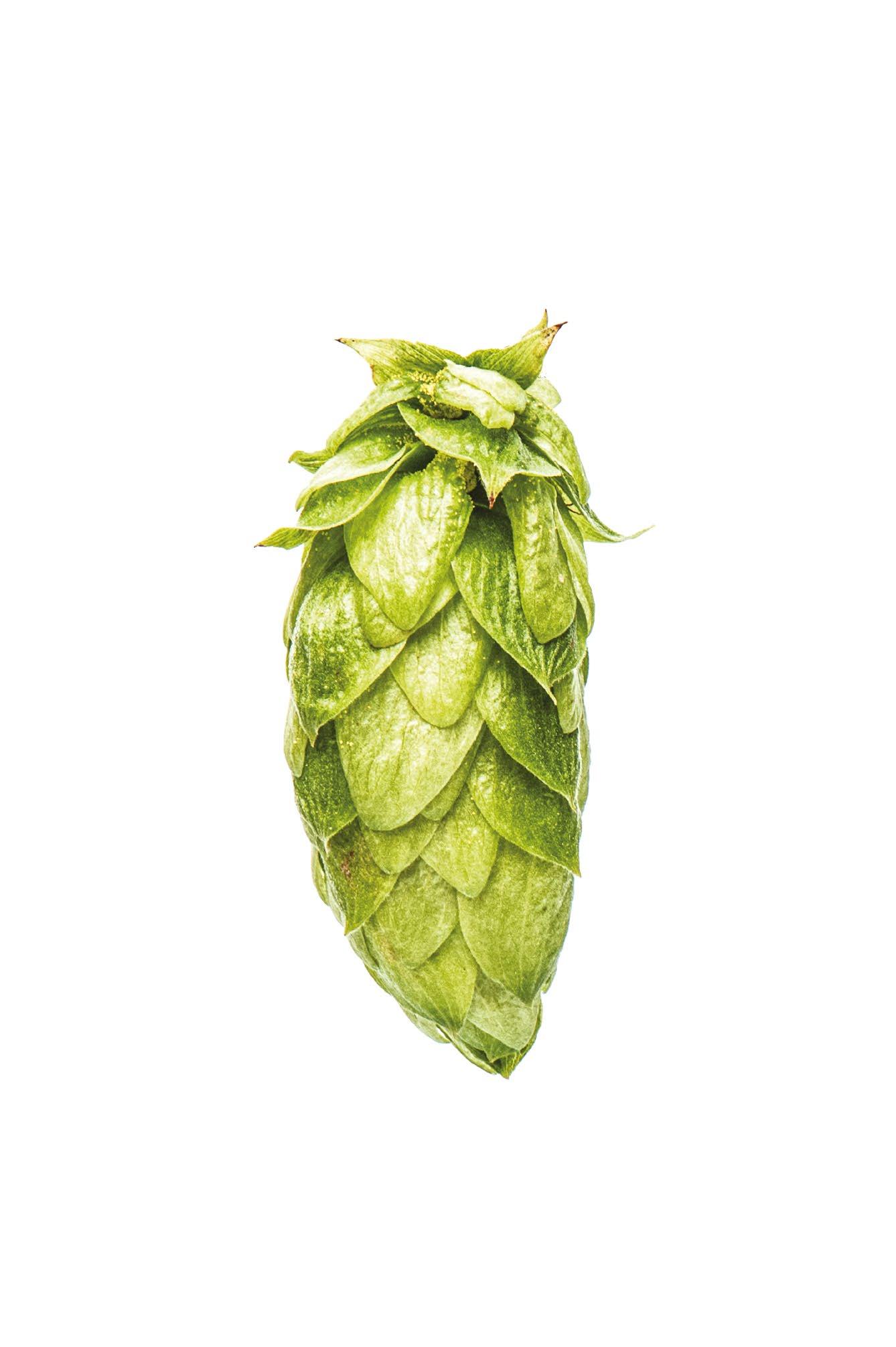
A LOVE OF INGREDIENTS AND FLAVOUR EXPLORATION LED JORDAN MOWER TO OPEN A NANO BREWERY BACK IN 2014. AND NEARLY 10 YEARS ON UNBARRED BREWERY OF BRIGHTON, WITH ITS TEAM OF 16, LIVES FOR ONE THING - THAT’S TO INSPIRE DISCOVERY THROUGH BOUNDLESS CREATIVITY.

Where were you on Christmas Eve in 2013? Possibly spending time with friends and family, or perhaps getting things ready ahead of a big day spent with loved ones. It’s highly unlikely, however, that you were hanging out at the reservoir in Balsdean, a deserted hamlet in a remote
downland valley near Brighton in East Sussex. Instead that was a job for Jordan Mower and his colleagues…
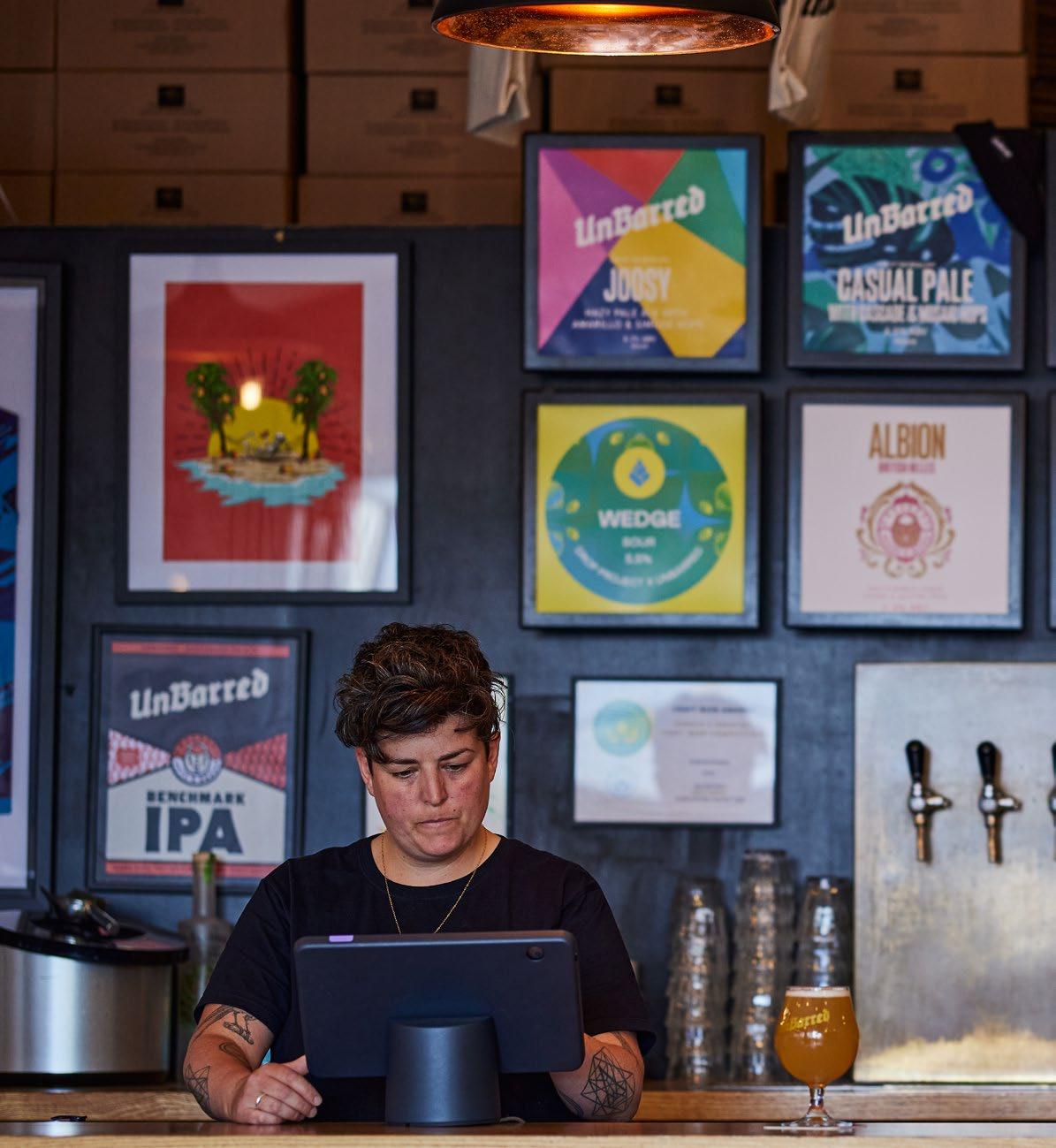
The Balsdean reservoir is a Victorian-era lake that collects rain water from the surrounding chalky hills. However when a storm hits, it can increase the turbidity of the water so as a result, the water mains need to be run with the water then dumped as it’s undrinkable.
Fresh water is then collected and filtered as the pumps that form part of the reservoir simply won’t run if it’s too hazy. This very reservoir feeds all of Brighton and also some of Hove. So it fell to Mower and his then colleagues to run 12-hour shifts to fix the problem. Otherwise? There was a strong chance that many of the great and the good of East Sussex would have not had running
water on that special day. You could argue Mower and his team were the saviours of Christmas past...
“I remember I had a bag of fresh biltong from my local South African butcher in my car that night. That probably kept us going,” he recalls.
“It’s funny looking back on it. You don’t get any awards for that sort of stuff, and you end up completely shattered on
Christmas Day. But 10 years on, here I am still working with water. It’s just more enjoyable now!”
It’s more enjoyable for fans of great beer, too. A stone’s throw from Brighton station, UnBarred has become a leading name in the world of excellent beer.
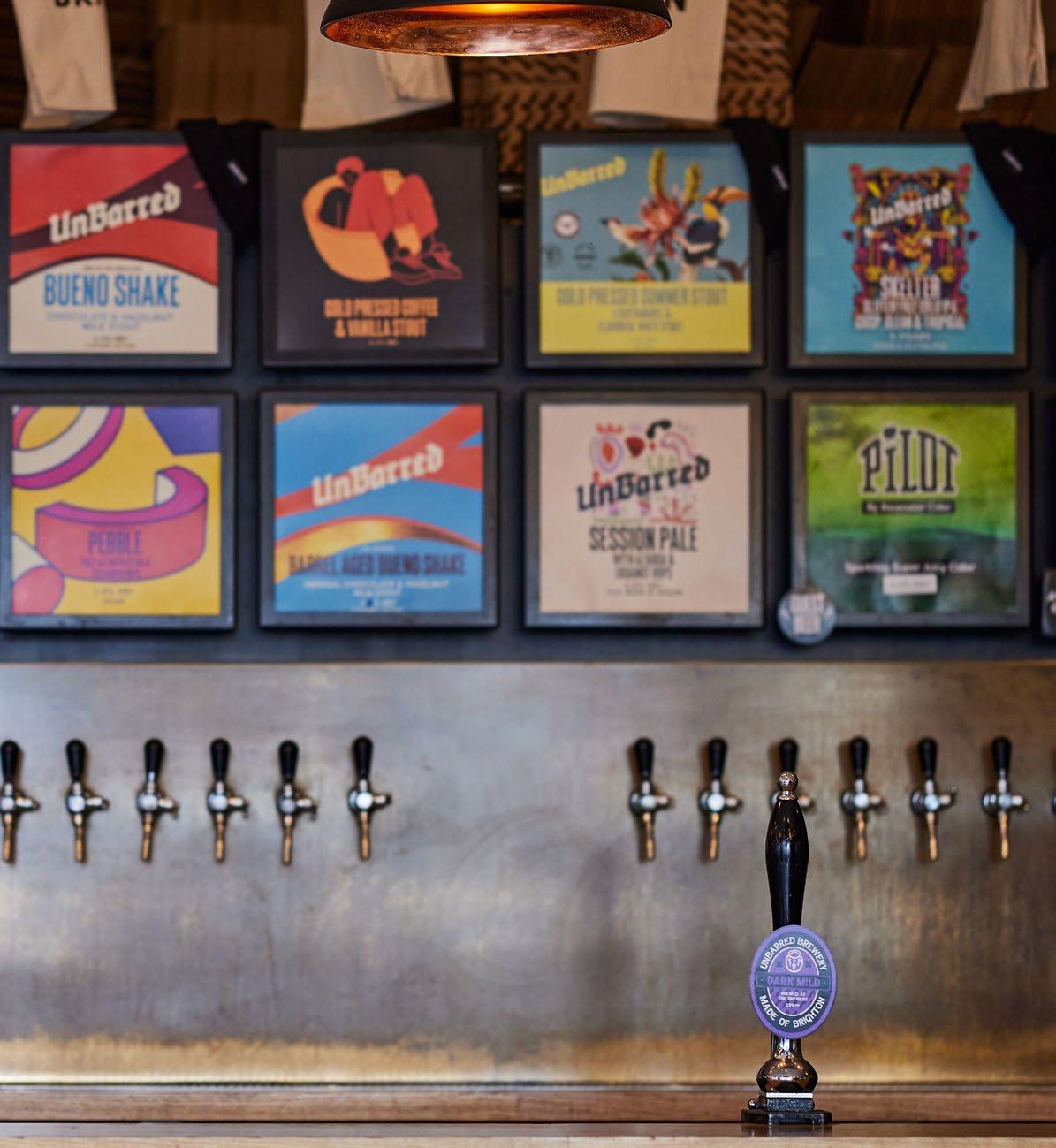
Not just in the South East but further afield, too. Just ask the swathe of American tourists that make a beeline
for the brewery’s taproom while visiting the UK. “We seem to have a big following over there,” laughs Mower. Which is strange because we don’t sell any of our beer in the US!”
UnBarred was established in 2014 from the shed of founder and head brewer Jordan Mower. Born of a passion to brew uncompromising and exciting beer, their
original flagship IPA won the Bev Robbins Award for the Best Sussex Beer in its first year of production. Meaning UnBarred would sit along revered peers Burning Sky and Dark Star as recipients of that sought-after accolade. They would soon outgrow the shed and moved onto gypsy brewing, enabling them to grow production and hone their craft, working together with other fabulous breweries.
And since establishing their taproom and brewery in Elder Place, Brighton in August 2019, they have gone on to grow their production and embrace the Brighton community that they call home. Producing no fewer than 46 beers in 2022 alone, Mower and the team’s raison d’etre is to “ignite curiosity and inspire discovery through boundless creativity”. And the name of the business is a guiding message that has led the brewery since it’s very first days as a business.
“We are trying to break the barriers of what is a beer is. It’s unbarred, it’s unleashed and then on the flip side,
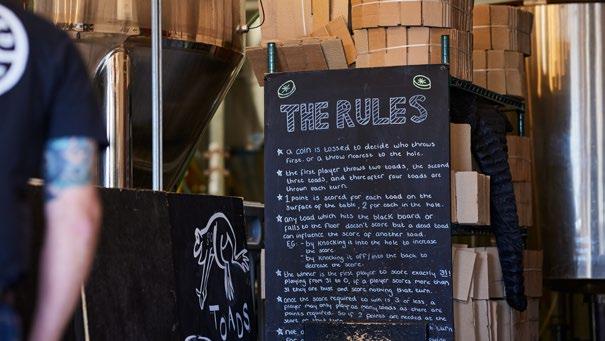
as a follower of what we do you are not barred. You are welcome and encouraged to join on us on this creative journey,” he enthuses.
While many would-be brewers had those early epiphanies visiting a certain brewery or trying a special beer, Mower’s journey into the world of brewing started from his love of cooking and flavour exploration.

Growing up, if he did well at school, his mum would treat him with a visit to Dig In The Ribs. It was an American-style
restaurant, now sadly defunct, located on Preston Street in Brighton.
Visits there, and spending time with both parents sat around the kitchen chatting about food lit a fire in him. And as he grew older, Mower would enjoy going out to Brighton’s wealth of great bars and pubs. He’d enjoy the beers but he also relish welcoming friends back to cook them a meal. “I suppose I had a passion for produce, of all kinds!” he explains.
That love of cooking and creativity would soon lead Mower to the new-andexciting beers that were landing on UK shores. Legendary beer spot Trafalgar Wines, which shut in 2019, would expose him to beers like Sierra Nevada Pale Ale and various releases from Dogfish Head of Milton, Delaware.
“I had picked up a pretty advanced homebrew kit and was brewing all-grain from day one. But it was these beers from the US that showed me that beer didn’t need to be malt-forward and “beer” flavoured. Instead I was tasting all of
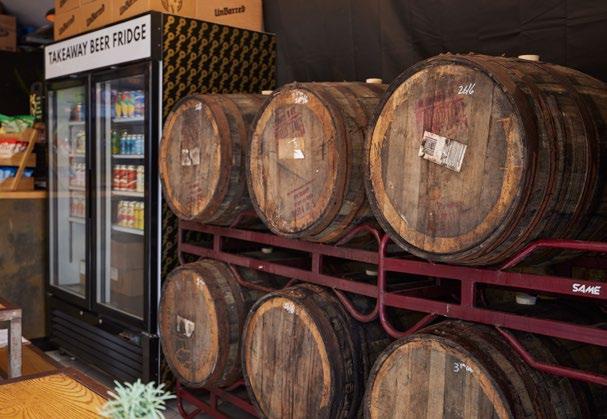
I had a fresh bag of Biltong that kept us going,” Jordan Mower
these stunning fruit flavours. The fact these came from the hops was magical and a huge inspiration to me,” he says. “And that was it. I could not stop thinking about it. “I would be dreaming about ideas then waking up in the middle of the night writing notes on how I could turn a concept into a beer. I found myself needing to understand the science of the process. It was absolute, extreme, ultra focus.”
In 2014, Mower would register his 100L kit as Hove’s first ever nano brewery. It was then he found that the most expensive way to try and save money drinking beer was to make it yourself.
“It never works out that way because you’re always buying the next piece of equipment and everyone expects free samples from you!” he laughs. Working with his good friend Tom Lacey, they would create the logo and identity of the brewery - UnBarred.
“I was literally going through the thesaurus looking for ideas but once we settled, there was no going back,” he recalls.
The following year, Mower created a beer called Benchmark to enter in the CAMRA Sussex Beer Festival, the same beer that would secure him the legendary Bev Robbins Shield. Circa 5%, the West Coaststyle beer featured Amarillo and Simcoe in the hop bill.
“I suppose you could argue it was more of an IPA because at the time they were were more dark copper in colour while Pale Ales were light and straw. Now there seems to be less of a defined difference in the two,” he says.”
The festival success of that beer led Mower, and his fellow brewer Gary to work on the recipe. A beer that they would refine and evolve to Joosy - the flagship beer of UnBarred to this day. While the modern iteration is soft and pillowy, elements of that early cask beer from 2015 live on today.

In the years that followed Mower would join King Beer in Horsham, an outfit that would go on to become Two Tribes upon its relocation to London.
He enrolled in an IBD course and eventually moved onto Missing Link Brewery in East Grinstead where he
would commission their brewhouse - a UK first from Ss Brewtech - and also help brew beers on behalf of a range of local breweries as well as Golden Goose lager for Goose Island.
All of this while continuing to brew and sell his own UnBarred beers. As his family grew, so did the size of the family car/ delivery vehicle.
“At this point, I was designing the beers, contract brewing them, selling them and delivering them. I knew I needed to create my own destiny. And that involved finding somewhere of my own,” he recalls. And that journey would lead him to Elder Place.
Through a mutual friend he was introduced to Rupert Davidson and Davinder Sahota, the founders of Fatta a Mano, a Neapolitan pizza business with sites in Sussex and London. In asking for advice on raising funds, they proposed he joined forces with the duo.
“They were directors of Holler Brewery. That venture didn’t really work out but they also had this fantastic premises in the centre of Brighton, which could
become the new home of UnBarred. The chance to work with two people that have a wealth of experience in hospitality was a no-brainer. I’m fortunate that we are part of the same team,” he explains. And come August 2019 they would fling open the doors to the brewery’s new home, starting out with a 2,000L brew house with six fermenters, the taproom had 15 taps and also two cask lines. Things have grown much since then, but having that taproom focal point remains as key as it did since day one.
“That has always been a big part of the dream for me. I couldn’t have pictured just having a production facility in a field because I want that connection to people. I’ve always had a connection to people so I didn’t want to lose that,” he smiles.
“When I was growing up cooking for my friends, they all told me I’d become a chef. But I said the problem with that is how difficult it is to engage with what’s going on around you. I live off the feedback, be that positive or otherwise.”
With close to 50 beers produced last year, that creative drive has shown so sign of slowing down in 2023 - nor can you expect it to.
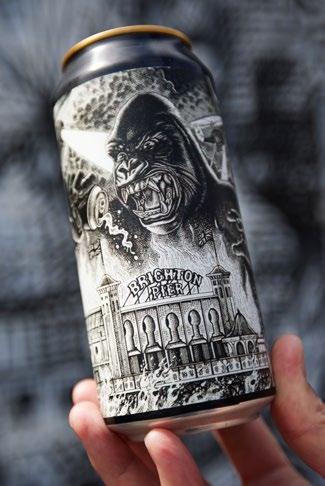
Current releases include Cherry Garsour, an Amundsen collaboration, which is a 6.2% sour featuring a sophisticated blend of decadent dark chocolate, sweet vanilla and fudge all layered onto a bed of 800KG of fresh tart cherries giving it this mesmerizing deep ruby red colour.
Cold Press Summer Stout was crafted in collaboration with Back Yard Coffee Roasters, Terre De Sienne, and Gold Coffee Mountain Growers, achieving a huge depth of flavour with sustainability in mind, while Catching Waves is dripping in Citra, Galaxy & Mosaic hops, a 6% hazy IPA packed full of sticky mangoes, tropical citrus fruits and accompanied by a gentle bitterness. Then there’s the small matter of Old Fashioned. Their take on the classic bourbon cocktail with selected barrels from their barrel ageing program.
Barrel-Aged Old Fashioned is a deep, dark and roasted stout that has spent eight months in Rye Buffalo Trace
Bourbon Barrels. They hand-peeled Seville oranges charred the zest and steeped in bourbon with Muscovado sugar and Angostura bitters, blending incremental amounts back into the beer to find the sweet spot. The result is a rich and indulgent 12% stout with sweet & spicy notes of citrus orange, vanilla & sticky caramel.
These beers complement a number of regular, mainstay beers. And for Mower, having something new, interesting and exciting on offer is non-negotiable.
“I have ADHD so I’ve found in my older years that my brain moves extremely fast at all times. It’s like I’ve constantly got this second brain that’s looking out for ideas, even if I’m doing something simple like holding a cereal packet,” he says.
“I’ve already got more ideas than we have space for in next year’s production schedule so it’s going to be a case of looking for more capacity elsewhere as we simply don’t have any more room to grow here.”
But while Mower lives for that level of creativity, he also understands the dayto-day role of his brewery.
“We need to constantly be reminded that we are a production line that makes beer to be sold. And the way we sell that beer might not always be straightforward. So when a contract comes up that means you can fill your tanks for the next six months but you’re selling for 20% less than you would normally do, that’s a decision to be made. You have to ask yourself if this decision is the right one for you in the long-run?
“However, regardless of where you sell your beer, never compromise. You must dump the beer if it’s not up to your standards. If you send out a product that you’re not happy with, I promise you you’ll lose money in the long run. Yes, you’ll make that quick buck and you’ll get the cash in for it. But when people start talking and sharing their views on social media, it’s not worth it. I’ve done it once and promised myself we would never do it again.”
And while Mower started UnBarred and remains head brewer, he is passionate about the brewery operating as one
entity - as one team. “We talk about a lot about ‘Team UnBarred’. We share in each other’s successes and also help each other when we make mistakes and need lifting up,” he says. “Having that culture where we are all committed to each other is so important to us.”
In addition to Jordan, the team comprises Brett in marketing, social media and design, Gemma as sales manager, Anna as operations manager, Matt as sales and marketing ambassador with Felipe the taproom manager and Cameron assistant taproom manger alongside taproom colleagues Susana, Ruby and Hamish. On the brew team there is lead brewer Gary, brewer Russ, technical brewer Brendan, brewery assistant Ben with Dan and Louis on the transport team.
Mower concludes: Growing six times from the day we moved to this brewery hasn’t always been easy. But we do what we do with love and integrity.
“And you can always have faith that here at UnBarred we’ll stick to our guns. And that means doing what I said earlier, aiming to ignite curiosity and inspire discovery through boundless creativity.”
We are a UK family run supplier of hygienic fittings to the craft brewing, distilling & cider making industries.


Wide range of fittings
Custom fabrications

No minimum order
Competitive prices
Fast delivery
01666 861 221 NCHFittings.co.uk

sales@NCHFittings.co.uk

Yeast nutrients minimise the risk of problematic fermentations by providing the essential nutrition yeast need to stay in peak condition.
But what if the yeast nutrient also enhances the aroma profile of your beer?
FERMOPLUS Fragrance & FERMOPLUS Fruity from AEB Brewing do just that.
Perfect for boosting the aroma profile of hop forward ales, hoppy lagers, and low and non alcohol beers.


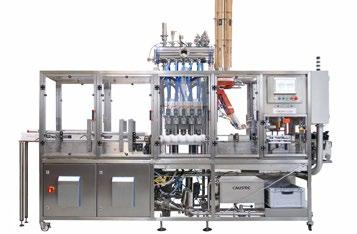
Built to endure. Engineered to adapt.
We are the leading UK manufacturers of micro canning lines. At Micro Can we pride ourselves on our ability to supply a full turnkey package; the canning line plus all ancillary equipment and this is what sets us apart from any of the competition. Our range of canning equipment is capable of producing from 720 up to 4000 cans per hour, all backed up with UK service and 24/7 online support.

Our services include:
•
• Filtration
• Pasteurisation
• Carbonation
•
• Testing
Some liquids we fill:
• Beer
•
• Tomato juice
• Water
• Wine
• Soft drinks
So water’s pretty important. Sadly though, as with all of our precious natural resources, our demand will soon outweigh the supply.
The Committee on Climate Change (CCC) predicts that the demand for water in England will exceed supply by between 1.1 and 3.1 billion litres a day by the 2050s.

Whilst the 2050’s might be too far away to concern you, recently, I was on a site visit to the outstanding Hepworth Brewery and their chairman Andy Hepworth informed me of the Water Neutrality policy in West Sussex, which prohibits any new business from opening that would increase water consumption in the county.
This is because there is not enough water supply to facilitate this. Quite terrifying if you consider what the future could hold for the UK’s heavy water consumers. And let’s face it, craft breweries can use a lot of water to produce beer.
Currently (August 2023), our UK craft beer industry standard in the UK and Europe is 7.7hl of water per hl of packaged beer. Whilst the word ‘standard’ is used, there is a large variance from brewery to brewery. The standard deviation of
the results is 3.9hl of water per hl of packaged beer, this means the data is actually very spread out, on average a brewery is 50% higher or lower than the industry standard.
Commonly, brewers assume those with the greater output have the lower water/beer ratio as they have access to technologies to reduce their water usage that smaller producers don’t. But this isn’t fully true, they may have access to better technologies but that has not proven to reduce water consumption as the 3 industries best Water/Beer Ratios have 3 of the 4 lowest packaged volumes per year*.*of 50 data sets submitted to Brew Resourceful
How do the smaller producers use the least amount of water to make their beer? Mainly because in breweries water usage is largely behavioural and process driven, which is significantly easier to motivate and control when there are fewer people and fewer processes to control. There could also be an element of cost management, I have seen small breweries work exceptionally hard at cost management when production volumes are lower. They often understand the ‘True Cost of Water’.
WATER AND BEER GO HAND-IN-HAND. BUT TOO MANY OF US ARE USING TOO MUCH OF IT, WHILE NOT FULLY UNDERSTANDING ITS TRUE COST. HERE CHRIS LEWINGTON, FOUNDER OF BREW RESOURCEFUL, EXPLAINS HOW WE CAN CHANGE THAT.
It’s easy to look at water as: Cost of water = quantity used * price per unit of water. And as the cost of water is around 15-20p per hl this looks to be slightly irrelevant in the wider business financial picture. But you must pay for that water to be processed (pumped, heated/cooled, labour) and disposed of (wastewater treatment plant and then to your municipal sewage).
I worked recently with Northern Monk on reducing their water usage and they have allowed me to publish their results, this was their ‘True Cost of Water’. So we can see below we have gone from an original unit cost of 16.7p to 55p a whopping 229% increase.
But where does all my water go? Here is a chart with data from the Brewers Association that gives a general idea of where total water in a brewery goes, assuming the majority of packaging and keg cleaning takes place on-site.

From this we are hopefully aware of the importance of not wasting water, where our water is generally used and the true cost of water.
It’s time to explore how breweries are achieving industry low water usage numbers. Here are 6 of the most common ways breweries are reducing their water consumption.
Leak detection is quick, easy and requires minimal cost to fix and maintain. Breweries have regularly saved 20% of their water usage by fixing all the leaks in
the breweries.
Pressurised hose leaks require an immediate fix as they contribute large volumes of water wastage. It’s rare to see a brewery leave a pressurised leak unfixed so let’s look at the far more common drip style leaks.
How often have you heard “It’s just a drip” when discussing a leak.
A challenge for you: Put down this magazine, place a jug under the leak for 1 minute, and look at the volume (or weigh it) that has leaked.
Times it by 525600 (minutes in a year). That’s how much water you just saved from that ‘barely dripping tap/joint/valve’. And remember to use the ‘True Cost of Water’ value when quantifying your savings.
Don’t be fooled by the insignificant look of a drip/leak, wastage numbers start to look very scary when you times them by 525600.
CIP procedures affect your brewhouse, cellar and packaging water usage. So there could be ~40% of total water usage up for healthy savings.
For Northern Monk (who have allowed me to publish their data) this was 55% of their water usage.
First step is to take a high-level view of your CIP process and ensure you are not cleaning for the sake of cleaning. The fear of microbiological issues is rightfully strong, but fear should not distract from proven cleaning science.
The majority of water in your CIP routine is used in your rinsing steps and your sanitisation step. The list looks like this:
u Pre-Caustic Rinse Water
u Post Caustic Rinse Water
u Post Acid Rinse Water
u Sanitisation
Unfortunately, the detail of CIP optimisation is not possible to cram into a 1500-word count limit, but I do have an hour-long episode on my podcast ‘The Modern Brewer’ on CIP optimisation with myself and Belinda Jennings of Kersia. Using the techniques we discuss in the podcast Brew Resourceful managed to save Northern Monk 10% of their total water usage, which was 69,140hl a year of water saved with a ‘True Water Cost’
saving of £37,993 a year.
If you have a bottle or can filler then you will most likely have a water rinser for the empty cans/bottles. If you have seen one in action it’s hardly surprising that this seemingly endless stream of water is taking up a significant proportion of your brewery’s total water usage. Reusing the empty container rinse water to rinse the filled container is essential. This surplus water can also be used in bottling lines to fill the vacuum pump chamber and/or stored for vessel rinsing water.
But in a perfect world, investing in ionised air rinsing is the key to stopping most of the water wastage in packaging. They fire compressed air through electrically-charged nozzles to create static, which dislodges any objects or dust in the container. They are accepted by all accreditation bodies. As with everything in brewing, they are expensive but offer a great return on investment, remember when you calculate the ROI use the ‘True Cost of Water’ as discussed above.
How many of us have high-pressure high-flow water hoses for floor cleaning? Let’s face it, they are super convenient. You can spray vast amounts of floor space, push large objects to the drain (naughty) and wash hard-to-reach places all without having to move more than 2 steps. However, as with all convenience, there is a cost somewhere and, in this case, it’s your water consumption. Those high-pressure, high-flow water hoses spray between 18-30l of water a minute. This may sound insignificant to you but this cleaning water can amount to 3% of your total water usage.
First change to make is behavioural, ‘sweep before spray’ is a simple yet effective floor cleaning policy. It has reduced breweries’ floor cleaning water by 50%. Secondly, you can introduce low-flow nozzles onto your hoses whilst this will largely be unpopular at first but will comfortably take another 25% of floor cleaning water usage away.
So with two simple changes you can reduce your usage by 75%.

There is also the added benefit of showing your teams that you as a group are committed to reducing you water usage, it’s motivating to work in an environmentally friendly way. Using these techniques we will reduce floor cleaning water usage at Northern Monk by 2,587hl a year.

How do you improve what you don’t know? How do you know if you have improved at all? Well, you need to measure. Luckily in brewing measuring water is super easy.
Every business has a mains water meter, this should be your primary source of water usage data, try not to rely on bills especially if they’re estimated. Put a reminder in your calendar and take readings monthly, easy.

I often hear from breweries that they are concerned about assigning the whole consumption to the brewery itself when you have a taproom, office or other

entity coming off the same meter as this number isn’t representative. Whilst technically true, your taproom and office are small consumers in comparison to production. Your brewery will be well over 85% of your total business water usage and the office and taproom are consistent entities. Even in higher demand seasons, the water usage will be marginal in comparison to the increase in production.
Yet, if you are like me and you find inaccuracy demotivating then there are loads of ways to incorporate a taproom or office to fine-tune that accuracy. You have to estimate your office and taprooms usage and take that into account. It’s quite tedious.
Luckily, I have made a free tool for brewers to use on my website www. brewresourceful.com where you can input your data and find your accurate brewery water consumption. Once you have your number, how does that compare to other breweries? Well here’s another shameless plug, I have another free tool on my website where
you can benchmark your brewery’s water consumption against the industry standard and breweries of a similar size. It will allow you to identify if water consumption is an issue in your brewery. Map your water, Install water meters Mapping your brewery’s water usage points and evaluating their quantities isn’t really the reason any of us got into brewing.
But they are a great tool for you to learn the entire waterways of your brewery. From there you get a full picture of water pathways and the high usage points. Then you can install flow meters at the strategic points (Brewhouse, CIP set & Packaging) and get the in-depth analysis you need to make quick and lasting changes.
Once installed they are low maintenance and can be checked once a day/week/ month and you can track your changes. Use those learnings to share with your team, fellow brewers and future breweries.
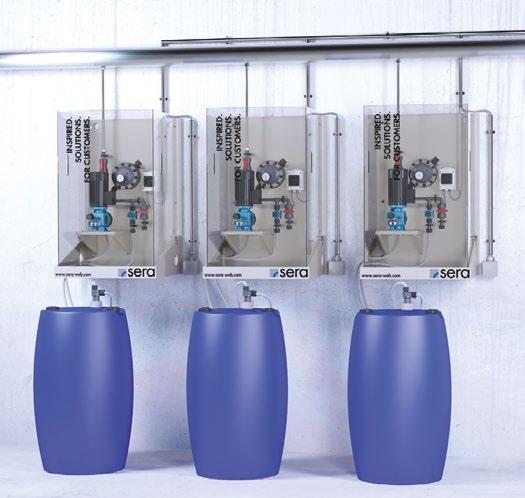

Cans are growing fast in popularity in the vibrant yet ever-changing craft brewers industry, being seen as a resilient and reliable choice for many brands.
A challenge faced by many brewers, however, is the fact that can suppliers are mostly large companies with their business models tuned to the mainstream brewing industry, seeing minimum order quantities for predecorated cans as high as 250,000 cans or more.
This is not an option for many craft brewers who normally brew much smaller batches – and many new ones continuously.
The most common way around this obstacle is for the brewers to invest in a labelling facility for their canning line and then buy undecorated cans.
It cannot be denied that the beverage and packaging industries have been long overdue an overhaul. that independent drinks companies shouldn’t have to compromise on design and creativity to deliver their product in a cost and environmentally effective way.
That’s why our brand NOMOQ (no minimum order quantity) was born – to allow drinks brands of all sizes to deliver unique, eye-catching aluminium can designs – no matter their size.
Aluminium cans are emerging as a resilient and favourable choice for packaging beverages more and more every day.
With their cost-effective, lightweight, durable, and sustainable nature, they’re an eco-friendly option that aligns well with the values of consumers and manufacturers alike.
As concerns for sustainability grow louder, independent drinks companies
are turning to aluminium cans to not only deliver product, but to enhance brand image and do their part in environmental conservation.
Aluminium cans’ lightweight design requires less energy for transportation, drastically reducing greenhouse gas emissions during distribution compared to heavier alternatives – such as PET bottles. But most of all, the infinitely recyclable nature of aluminium ensures that the material can be 100% recycled, and consumes up to 95% less energy than producing it from raw materials, making it a smart, accessible and affordable way for brands to reduce their carbon emissions and combat climate change.
Furthermore, aluminium cans offer superior protection against light and air, preserving the flavour and quality of the beverages they hold.
However, when looking to make the switch to 100% aluminium, many midsized craft beverage manufacturers are faced with minimum order quantities they cannot meet.
Alternatives such as peelable plastic sleeves or labels are environmentally damaging and expensive.
But the benefits of no-minimum-order personalised can printing extends beyond flexibility. It significantly reduces the financial risk for smaller players, as they need only order the quantity they require, mitigating the burden of surplus stock.
Plus – unique designs make cans stand out, establishing brand image and promising to be eye-catching on the shelf.
Brewers deserve flexibility in their order quantities, but also a quality of printing
that sets new standards for the industry. For example, thanks to state-of-the-art high-tech inkjet technology, our cans are printed seamlessly over the entire surface with an unlimited number of colours.
This contrasts with today’s flexographic printing technology, which allows a maximum of six colours. In addition, we print the entire surface of the cans in matte, glossy or a mixture of both. Spot varnish can be used to highlight individual design elements, giving the cans a particularly valuable feel.
In this way, we are enabling the beverage industry to be more colourful and creative with their cans. Packaging and branding help craft beverage manufacturers build a brand identity, attracting new customers and retaining loyal ones.
While today’s printing technology struggles with long lead times (and costs) for plate creation, our printed cans are delivered to the market in record time.
This speed brings new marketing opportunities, whether for printing cans for events, festivals, or sponsorships, or for very short-term “live marketing stunts’’. For example, sample cans with customers’ artwork are currently available at no cost from a user-friendly online platform with our team available to help with anything needed along the way. Once the artwork has been approved and payment received, customers receive their printed cans in up to four weeks.
Brulo is an example of a UK brewer and alcohol-free brand embracing aluminium cans. Brulo’s 330ml D&I aluminium cans were decorated with a matt and spot varnish combi-textured finish in a variety of striking colours and designs. Before, Brulo was using plastic sleeves, however, they were concerned about the effect of single-use plastic cans on the environment. The brand was on the hunt for a more sustainable option.
James Brown, co-founder of UK-based BRULO beer, said: “Our beer is for the
modern world and therefore it needed a cutting-edge high-quality can. Design plays a key role in the experience of craft beer and that’s no different for us just because our beers are non-alcoholic. We were blown away by NOMOQ’s quality and creativity which aligned with our brand values.
They helped us spread the word, put more cans in hands and have gone above and beyond to deliver cans when we needed them. We can’t wait to see our relationship grow as our range develops.”
With high-quality print, sparkling creativity, and logistic flexibility I strongly believe NOMOQ is a true breath of fresh air for the beverage world, and we’re excited to open our doors in the UK and serve existing and new customers this autumn.

The advent of micro-scale canning has revolutionised the craft beer sector; Prior to the introduction of the technology in North America, canning had been the sole preserve of enormous, macro scale producers.
Canning lines in these facilities package in an hour what many small producers might do in a year;
In addition, they were fed by can manufacturing plants set up to service one or two big ticket customers with billions of cans per annum.
Low customisation, massive scale – the antithesis of craft; The supply chain just was not set up for small-to-medium sized brewers.
By c. 2010, access to smaller, relatively simple-to-operate canning equipment unlocked a world of possibilities for the craft brewer – access to new export markets through lower transport costs, ability to efficiently coldstore and the end of lightstruck beer.
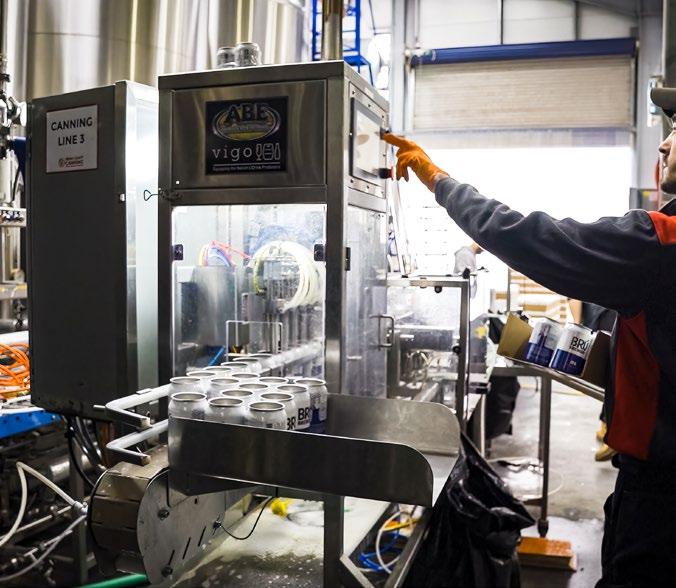
The foundations laid by the early pioneers of smaller scale canning, both manufacturers of equipment and their early adopters, has resulted in a seachange in terms of how we produce, package, and consume beer.
Canning is not for everyone – some wonderful breweries have famously sidestepped the format for their own, respected, reasons – it has become a fundamental cornerstone of the sector that would be foolish to ignore as part of any brewery’s distribution strategy.
Packaging is often the ‘forgotten hero’ of the craft beverage space – get it right and nobody notices – consumers get exactly what they want in a package that looks exactly as it should.
Get it wrong, and things get messy –oxidised beer, scuffed/chipped artwork, over carbonation - leading ultimately to exploding cans at higher storage temperatures. “Getting it wrong” can be existentially damaging – imagine getting the call at 10pm to be told that your big export order is being recalled, and you are the one footing the bill to get it off your customer’s site: A true story from the early days of small scale canning where the brewer made some unfortunate decisions on equipment and processes that ultimately cost many multiples of the initial capital outlay.
With over seven years of experience running a mobile canning operation across Europe & the US, we often get asked- what does “getting it right” mean,
and what does it take to avoid “getting it wrong”?
These are the questions we ask ourselves everyday – the answer is always evolving as technology and indeed our own knowledge base grows. We run 20+ lines across our network – at any one time we could be packaging in Ireland, the UK, Netherlands, Norway, or New Jersey – needless to say, getting the process right is what keeps the phone from ringing at 10pm!
So, what does it take? Let’s start with the core equipment available. There are dozens of canning line manufacturers producing lines in the 1000-5000 Cans Per Hour (CPM) range.
Manufacturers in US, Canada, UK and many EU countries have popped up in the past 5 years.
We have our preferred suppliers but
really, there is no right or wrong answer here among the household names; It comes down to what you need – do your volumes justify the capital expenditure/ Repairs / Interest and Depreciation, will you have local support, is the equipment expandable / flexible enough to allow you to grow without becoming a bottleneck.
These are questions and answers unique to your operation that should be carefully considered.
Once core equipment has been decided upon – the next step is ancillaries: QC/ QA kit, conveyance and can handling equipment.
The cost of a good quality DO meter should be considered part of the core investment – undertaking a canning run without this is the beer packaging equivalent to driving a bus with your eyes closed.

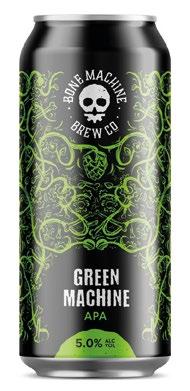
All the well-known canning line manufacturers are capable of achieving extremely low DO pickup – actually doing so is up to the operator, the condition of
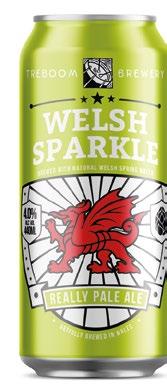
their product, and rigorous process that involves monitoring and recording of data on an ongoing basis.
Whether in-house or mobile, your packaging line operator should be able to demonstrate this data in real time – giving you peace of mind that the product stands the best chance of remaining fresh for the duration of its nominal shelf-life.
Lab work is another element that should not be overlooked just because the beer has made it to the BBT. Packaging lines, gaskets and carb stones are notorious hiding places for beer spoilers – regular testing (plating & PCR) for wild yeasts such as Diastaticus / STA-1 goes a long way to preventing the dreaded ‘exploding can’.
A good mobile canning provider will be able to provide a screening programme for this – there are also plenty of options out there in terms of lab partners who can assist.
The above are what we would consider ‘key considerations’ – yet they count for
very little in the absence of a competent, confident, and well-motivated team. The packaging line operator should not be considered a ‘side gig’, or an ‘hours filler’ in brewery operations – these people are the final point of contact with your product before it goes out to retail –the final hand in terms of getting it right, or wrong, is down to them.
Our mobile canning technicians tie this all together – equipment, process, and a relentless commitment to product quality.
If you are considering getting into canning for the first time, upgrading kit, or looking for packaging advice, we would highly recommend having a chat with your local mobile canning operator. A good mobile operator will work with you through the business lifecycle –supporting you long after volumes have justified taking packaging operations in house with can supply & decoration, machinery rental, QA, and technical support. Good luck on your canning journey!




Sketches of Spain. Or should that be ‘Esbossos d’Espanya’ en Catala? Anyway, it’s hard not to love the city of Barcelona. All that Gaudi for a start – La Pedrera, Casa Batlló, Casa Vicens and the breathtaking craftmanship of the Sagrada Familia. And it goes on, with other unique modernist buildings by Cadafalch and Montaner, among others.
For quieter moments the verdant parks of Güell, Ciutadella and Laberint d’Horta offer respite from the teeming crowds of tourists.
Relaxing but never dull, the beaches around Barceloneta also give ample opportunities for a gentle paseo, as long as you keep out of the way of skaters, scooters and bikers.
Then there are the differing personalities of the diverse neighbourhoods – the winding lanes of Barri Góthic, broad majestic avenues of Eixample, pintxos and cool in Poble Sec, arty and trendy El Raval.
Then there’s Gràcia. A warren of narrow streets, numerous plazas swarming with children, crafts of all description, a focus on sustainability, politically-led demonstrations and presentations, human towers (castellers), hip and trendy… it has everything.
Separated from the city until 1897, Gràcia has retained its identity and diversity and wears its Catalan heart on its sleeve. It sometimes feels like a completely different place to the rest of Barcelona and we fell in love with the region on a visit many years ago.
We decided to make a base here for the month of May in a lovely casita a couple of steps from Plaça del Diamant. So much to see and do our aim was to live like a local and really get under the skin of the city.
To find our favourite local bar, where the best churros are made, new innovative tapas offerings and broaden our appreciation of vermút. Perfect.
But while we were at it I took the opportunity to explore the burgeoning craft beer scene there. Here’s what I found.
You have to go back 30 years to trace the beginnings of the craft beer scene in Spain. This is when Liverpudlian Steve Huxley founded the Barcelona Brewing Company in Grácia.
Known as the father of craft beer in Spain, Steve also founded his beer academy at Cervecería Jazz in Poble Sec.
Unfortunately, Steve passed away in 2015 and in honour of his pioneering work the Steve Huxley Award has been given to the most pioneering and inspiring individual in the world of Spanish craft beer at the annual Barcelona Beer Festival.
Many cool and crafty bars opened at the same time and some are still pouring great beer, but the current scene really got established during the last decade. I’ve grouped the bars and taprooms into neighbourhoods where there is a concentration of sites and added in some outliers separately.
Wedged in between Montjuïc and Sant Antoni Poble Sec earned its ‘dry town’ name thanks to not having a water fountain installed until the 19th century. It is bounded by Avenguda del Paral-lel which used to house many theatres, music halls and more ‘unsavoury’ establishments which have now faded into an almost century-long obscurity. Nowadays the area is host to a multicultural population which is reflected in its bars and restaurants.
The pedestrian Carrer del Blai contains the greatest number of pintxos bars in the city and is worth a bit of bar-hopping. Nearby Cerveseria Jazz was founded in 1992 by Alex Camacho. He was a founder of the Humulus Lupulus association, which explored home brewing, appreciated beer from other countries and wanted to create a craft beer culture within Catalunya. Here Alex will serve you perfectly poured pints from Catalunya and around the world.
Across the street is Brew Pub le Sec founded by Anna Cufi and Bernat Diego in 2015. In what looks like the world’s smallest brewery, with the production kit perched on a small mezzanine above the bar, they pour some of the best craft beer in the city along with a number of guest beers. They regularly host events but the annual birthday party on 1st May is the one not to be missed.
All the beers that I tried were excellent – Pale Ale, Fruit Sour and Stout (Manic Stout Preachers – I love this!).
If you head up past the pintxos bars of Carrer de Blai you will be going in the direction of Abirradero.
Founded in 2015 in the 100-year-old iconic Abrevadero restaurant by Lluis Sanchez and Daniel Fermun, Abirradero houses a taproom and restaurant with outside seating.
Next door is the brewery where they also help train budding craft brewers in their Instituto de la Cervesa Artesana. There are many rooms large enough for private celebrations and regular beer festivals and wine tastings. I had a really good Helles and an IPA but the standout was their Saison produced for a local hotel.
A skip across Avenguda del Paral-lel is Barna Brew, founded in 2017 by Alex Lazarowicz and Dimi Tsaousis, who first met in London and later in Brussels when they decided to start a brewery in Barcelona.
The taproom is very bohemian cool with freshly cooked snacks and sandwiches and also hosts many events. We held some beer tastings together, including one for Barcelona Tursime which is something that they hope to continue doing in the future.
The beers produced are Belgian-style with a touch of Catalan – orange blossom honey, Sichuan pepper and bay leaf give the recipes an interesting twist.
I really enjoyed their Blonde dry-hopped with orange peel, Witbier using bay leaves instead of coriander seeds and Moreneta Bruna with toasted malt, cinnamon and curaçao.
Five minutes away is Lambicus, opened by Henk Cortier in 2013. Henk hails from Belgium and decided to open his bar and nearby bottle shop in 2013 when he was struggling to find beers that he liked. As the name suggests, the beer card is predominantly Belgian and it’s an excellent list that would be the envy of
many a Belgian beer cafe.
Draft lambic is always on tap and I enjoyed some beauties from Hanssens and Oud Beersel. I have to admit to being very tempted by the exclusives from Antidoot and Drie Fonteinen.
Nearby you can enjoy wonderful craft beers at La Més Petita, a lovely and friendly tiny bar that has been operating since 1996.

Some of the beers here are hard to find in the city and they also stock their own range from Ratpenat Cervesers.
You pass through Sant Antoni to get to Eixample so it’s an opportunity to visit the amazing indoor market at the end of Ronda de Sant Antoni.
The barrio has transformed itself and is now a lively and progressive district that has attracted many younger families to enjoy its spacious pedestrianised streets, and students that attend the nearby Universitat.
It’s also home to Fàbrica Moritz, which has produced Barcelona’s original beer since 1865 and one that is christened in Catalan. The brewery has undergone a major refurbishment and is recommended for dinner, a couple
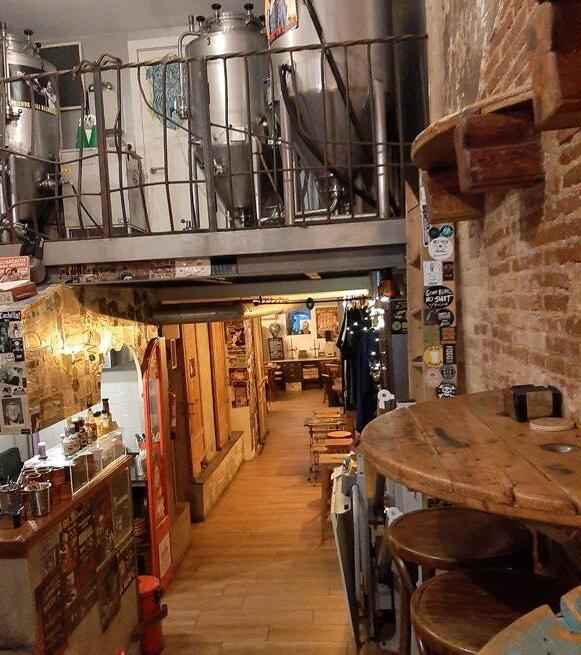
In Sant Antoni, expect Expect a range of draft taps, craft beer from all over the world and a cool vibe
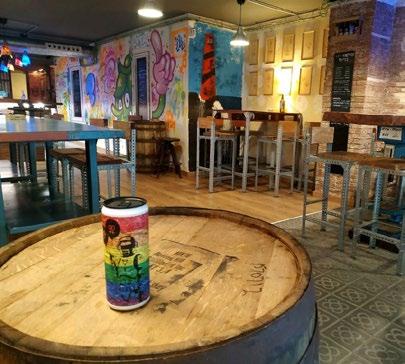


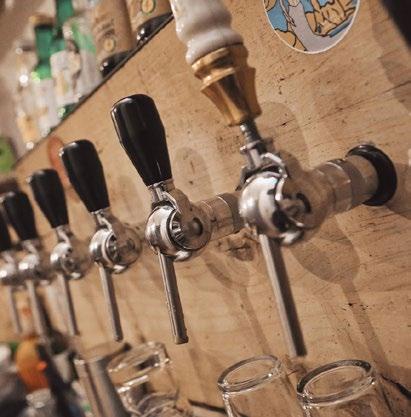
of beers or a brewery tour. Nearby is a fantastic taproom, Maresme, owned by the brewery of the same name that began brewing their excellent beer in 2017 in Montgat, a few kilometres up the coast.
This is a very upscale place with a full range of beers on tap and in can. Expect great food and top-quality events and dance nights. Unfortunately, the beergarden on the beach in Badalona is now closed.
I was very impressed with their Germanstyle beers and the Pils, Helles, Marzen and Bock were all top class. If you’re still thirsty I’d recommend a visit to Bar La Principal or Bodega Berlanga which are both nearby. And if you’re looking for beers to take home drop by Okasional Beer just around the corner from Maresme.
The ambitious late-nineteenth century decision to open up the city by raising the walls gave birth to the city’s Modernisme, Catalonia’s answer to Art Nouveau. With Plaça Catalunya as the gateway, the city embarked upon construction of an enormous grid of avenues based on Ildefons Cerdà’s design using a network of straight lines, parallels, diagonals and meridians. The district is split in two by Carrer de Balmes, a former railway and this divides ‘The Extension’ into Dreta (right) and Esquerra (left).
Continuing north from Maresme you cross Gran Via (home of the Universitat) and enter the most densely concentrated area of today’s craft beer scene. Rosses i Torrades is a craft beer shop now owned by Cervesa Espiga.
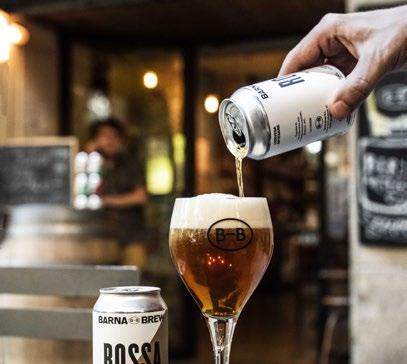
Expect a range of draft taps, craft beer from all over the world and a cool vibe with David spinning some vinyl on the decks. He even takes requests. Nearby is Conesa Beer, which was started by Montse and Joan Manuel Conesa in 2019. Designed to enable guests with reduced mobility to visit they also released a beer called Am Able to
raise funds for continued research into autism and intellectual disability. They offer a great range of tapas and croques and broadcast local football matches too.
Deservedly, BierCaB is probably the most popular craft beer bar in Spain. In 2017, Manolo Baltasar of Cafe Frieberg fame and Sven Bosch of Drunk Monk in Mataro opened the doors of this iconic bar. Specialising in perfectly poured draft craft beer the world over this is the place to head to if you just have an hour to spend in the city. Tapas, burgers and larger plates are available but you won’t go hungry as the neighbourhood is full of great eateries (try La Flauta).
Around the corner you have the original taproom and brewery of Garage Beer Co. This is where they opened their brewpub in 2015 before moving brewing operations to their new site in Sant Andreu.
Another brewery founded by folks from outside of Spain, James Welsh (UK) and
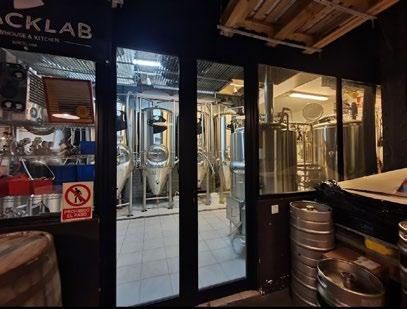
Alberto Zamborlin (Italy) were guided (as many others were) by Steve Huxley to the Eixample area where they converted a local paper shop into their brewpub. You can taste their excellent pale ales and IPAs alongside the complex wild ales that bolster their taplist.
A few blocks northwards you will hit Black Lab’s taproom where you can enjoy fresh beers from their Barceloneta brewpub (to learn more we feature their brewpub in the Outliers section). Walk up towards Avenguda Diagonal and you will come across Humble Beer, a really cosy craft beer bar showcasing Spanish craft alongside world classics. And finally, before heading to Plaça Catalunya and the metro there is Ruta 6, a microbrewery that started pouring in 2019. Fairly new to the scene they are pushing out a range of pales and IPAs alongside stouts, pilsners and sours.
Dreta is the more fashionable district of the two with the most distinguished Modernista architecture, the main museums and shopping avenues. La Textil, founded by globetrotter and master brewer Brian Blazek in 2021, is a brewery, restaurant and music venue. The food is unbelievable and innovative and uses local and seasonal produce. Pouring out of the 18 taps is the wide range of La Textil craft beers, supplemented by a high-end cocktail menu. They produce their own gin
and soft drinks onsite and the brewery capacity is 1,200hl. Highly recommended.
South of La Textil, craft beer bar Ale & Hop has been pouring refreshing craft beer out of its 12 taps since 2011. Not far from Parc de la Ciutadella and owned by Alberto from Cyclic (see outliers below), it’s perched alongside a quiet square and is another cool place to hang out and try some local beers or to attend one of their many beer-related events.
With a range of snacks, tapas and pintxos this is a great place to refresh after a couple of hours exploring.
Heading up towards Gràcia, La Cervesa Artesana is one of the originals and has been serving thirsty beer enthusiasts beers from their microbrewery alongside well chosen guest beers since 1996. This is the former site of Steve Huxley’s former brewery so its a very historic spot. Great beer snacks and an eclectic programme of live music make this a great spot to while away a couple of hours.
Another bar that serves up a large range of Spanish and international craft beer is CocoVail Beer Hall. Essentially a sports bar, this is the place to hang out to catch a game and eat from their US-inspired menu. Just short of the boundary with Gràcia,
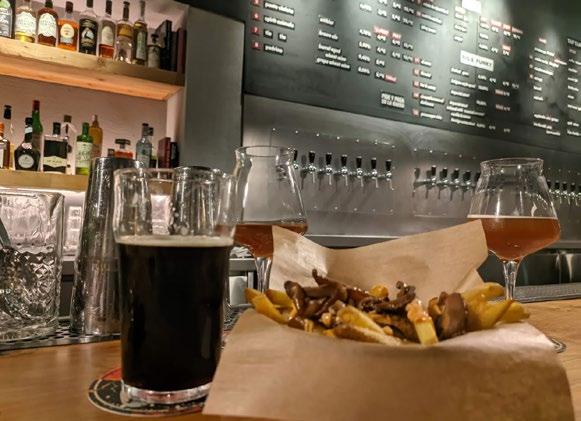
The Growler has a familiar beer-geek vibe, pouring pints and take-away growlers. They also have some tables outside if you don’t mind the noise from
the traffic.
If you’re looking for some food with your beer try Hop Town near Monumental where you can enjoy empanadas and pizza with your craft brews.
Finally, an exciting new project has opened recently: WU:M offers an innovative fusion of Japanese and Mediterranean vegetarian food that features beers from Animus among those of their friends (see ‘Outliers’ for Animus).
East of Poble Sec, El Raval (outside the walls) has had an unfortunate reputation in the past for seedy lowlife and while it has altered its monochrome grimy face for the better over the years (check out the post-Olympic Rambla del Raval), it still retains a steely hard edge.
Opened in 2015 by Mads Rademacher and Ivan Raho, Ølgod (beer god) began life dedicating itself to beer from Scandinavia.
Since opening their on-site microbrewery you can now enjoy tasty and ultra-fresh craft coming direct from the tank to their range of 20 taps.

Great food and a dedication to quality music has made this a must-do destination for beer lovers. A short walk away is Garage X Warwike where you can fill yourself up on Peruvian street food and wash it down with Garage beer from the 18 taps on the bar.
Hop across La Rambla and you enter the realm of shadowy medieval alleys, grand churches and ancient ruins in the political and religious heart of the Old City (Barri Gothic). I could write a piece on its own about this fascinating barrio whose
lurking and brooding narrative springs to life late in the afternoon.
You can quench your thirst on the 17 taps at Kælderkold (cold basement), which is also owned by Mads from Olgod. Most of the beers poured at this dive bar are from the sister site’s brewery but they also showcase a strong line in guest beers. Halfway between the Picasso Museum and Parc de la Ciutadella is Diec18, whose kitchen is supported by an impressive range of craft beers and natural wines.
While it doesn’t have any commercial breweries, Gràcia does hold claim to the best neighbourhood bar in the city. La Rovira is host to 18 constantly rotating taps, numerous bottles and cans, excellent tapas and grilled sandwiches (named after the surrounding streets), a killer playlist and a team that is well drilled, professional, knowledgable and offers a great welcome.
They always looked forward to greeting our little Jack Russell Penny Lane with a treat, bowl of water or simply hugs and kisses.
Noe Guarner established her bar in 2015 and quickly built a strong reputation for an outstanding range of expertly curated beers.
This is a bar where everyone knows your name and should you venture in on your own it won’t take long before you are
discussing the topics of the day with your new best friend.
There are La Rovira collab beers on the list, plus the ever-impressive wild ales from Cerveza Salvaje.
It is well placed on the corner of Plaça Rovira i Trias and is named after the architect Antoni who would have been the local choice to design the city’s nineteenth city expansion.
You can sit down with his statue on his bench and enjoy a beer while indulging in a spot of people watching.
In the south of the district is Bar La Beata, pouring 8 taps of fresh local Catalan beer, their own commissions and regularly producers from the Basque region. Small and cosy, it’s always easy to make friends here. Brew Home isn’t a bar but a destination where you can enjoy some ‘beerstorming’ pairings with Dani Ruiz or learn about brewing at one of the many workshops held there.
While you are at it you can top up your stash with his wild beers from Cerveza Salvaje. Probably the best beer shop in the city is on Plaza del Sol. Sol de Gràcia stocks an unbelievable range of beers featuring a huge Spanish offering plus a large selection of beer from the UK, Ireland, Belgium, Germany and the rest of the world.
Some of the beers I was able to buy at the shop were hard to find in their country of origin. A new kid on the block is Beer&Cocktails, complete with a beer engine.
Finally, close to La Sagrada Familia is
Espiga’s other craft beer shop, which features the full range of beers from Arnau Rovira’s brewery. They also have four of their beers on tap and host regular events.

Part of the Sant Marti district, Poble Nou morphed from a farming and fishing community into a centre for heavy industry up unto the 1960s when many of the factories folded or moved away. Relics of its industrial past are in evidence everywhere and former sites have been re-purposed into schools, civic centres, workshops and open spaces. The artistic community has been part of a drive to make this a cool and hip area to live and work in and that has encouraged the growth of craft beer in the neighbourhood.
Garage (who else?) has a site just a short hop from Playa del Bogatell. Specialising in pizza to complement their range of beers the site has a good sized terrace out front. Head east to Cerveceria Ogham from Argentina who have taken over the former site of Freddo Fox. Nearby Hoppiness is pouring local brews and beyond from 14 taps. Nice and relaxed with alt sounds on the playlist, Hoppiness is praised for its grills and burgers. They have another outlet in Sants near Plaça Espanya.
One of the city’s finest beer bars is located in Poble Nou. La Cervecita is summed up by their strapline ‘nuestra de cada dia’ or ‘our beer of every day’.
Angie Gesteira and Joaquim Sainz have created a friendly space that is truly

the essence of beer with a dozen taps, three beer engines and over 300 bottles. Highly recommended.
Taking advantage of derelict industrial sites Almogàvar – Beer Democracy took over a 2,000sqm warehouse in 2015 after six years of cuckoo brewing. Founded by Victor Cerdan in La Verneda i la Pau and consolidated when master brewer Francesco Stella joined from Italy they have really made their mark and you can easily find the beers on market shelves in the city.
The site is big enough to allow for expansion and importantly to hold many events, as their relationship with the local community is very important. El Clot boasts the craft beer workshop Birra 08. Since 2010 the team has been brewing beer, hosting tasting events and offering brewing workshops
About a 15-minute walk from Almogàvar is Cyclic Beer Farm, which was established by brothers Alberto and Joshua Coromina in 2016. Inspired by Belgian saison, Cyclic specialise in mixed fermentation and have developed their own yeasts and bacteria cultures which they sometimes supplement in their beers with fruits, vegetables, herbs and flowers – some of which are grown on their own family farm and some coming from local ecological farmers. They also produce traditional wine and have used the macerated grapes in their
mixed ferm beers. Nearby is an excellent venue for lunch with local craft beers, La Floristeria de Masadas on Plaça de Masadas.
And if you head towards Congrés metro station later you can sample some of the excellent beers at Cerveceria 2D2Dspuma with its 9 taps and over 600 bottles and cans.
Walking towards Platja San Sebastian from Barceloneta metro station you will pass the enormous Museu d’Història de Catalunya or the Waterside Catalan history museum.
As you walk around it you will spot an outside seating area where customers are tucking into craft beers and Asian/US inspired bar snacks. Black Lab Brewhouse and Kitchen was founded in 2014 and this is the location of their brewery. We’ve always had excellent and friendly service from the team and this is a much-needed stop on a sunny day before heading to the beach. East of Gràcia and the Parc Güell Animus Brewing Company was born out of lockdown in 2020. Founded by Peter with the support of his girlfriend Constanza, Animus has quickly grown a huge following and became one of the highest-rated Spanish craft breweries on Untappd.
The philosophy at Animus is as a collective – grow their network of beer friends globally, make collaborations, host events and celebrate beer at their taproom and restaurant WU:M (see above, Dreta).
Formerly the industrial town Santa Maria de Sants, this neighbourhood officially became part of Barcelona in 1897 and stretches east from Eixample. Giant textile factories were established here and their wealth were in part responsible for some of the Modernista projects such as Can Batlló and the Parc d’Espanya Industrial. It is home to the Plaça Espanya and the main railway station Barcelona Sants.
And just north of the N340 is the brew pub Homo Sibaris. Formerly of La Cerveteca and Humulus Lupulus, Guillem Laporta opened his bar where he and his friends brew their own beer. The terrace on Plaça d’Osca is the

perfect place to sample their brews or enjoy a guest or two.
West of Sants L’Hospitalet de Llobregat is the main centre for Flamenco, with its large Analusian population – many streets are signposted in Spanish not Catalan. The neighbourhood is proud of its identity, with LH stickers everywhere and even street signs guiding you in the direction of Barcelona (a few blocks away).
Here we find Tibidabo Brewing, one of the largest microbreweries in Spain. The brewery has sufficient production space to take on contract brews and I easily found their beers available in most supermarkets throughout Gràcia. The taproom is spacious and lively with a window into the brewhouse. We also had time to host some tasting events and tours and just squeezed into the Barcelona Beer Festival the day before leaving.
A month is a long time to spend in any city yet I still get moments of FOMO: what else is there to see and discover, which neighbourhoods still need visiting? Perhaps next time we’ll hit the road and explore the regions around the city. The pull from the city can feel like a riptide at times. It wants to reel you back in to show itself off like a child with new toys at Christmas. To welcome you and allow you to peel away more of its layers. I feel it will soon be time to go back – but until then, Salut!
On my journeys I have amassed a huge amount of knowledge of the country’s bars and breweries, and built up a network of contacts with the key people involved in Belgian’s vibrant beer scene. A resident of London for over 35 years I have developed an in depth knowledge of the capital’s most iconic pubs and bars.
More recently I have spent the past 10 years exploring the most innovative and exciting craft breweries in the city. In a previous life, I was a member of the Quality team at Fuller’s, London’s oldest brewery. I look forward to sharing my knowledge, enthusiasm and experience with you.
Real time Gravity monitoring for brewers
Non-contactmeasurement







Read Gravity from your smartphone
LeaveinplaceforCleaninplace
Works with brewing under pressure
Wireless,install in minutes
Remote Temp monitoring and control


Set Temperature from your phone





Programfuturesetpoints

Set SMS alarms

Automatic charting of data
Savetimeandincrease productivity


No more spoilt brews from chiller failures

info@dotmatix.net
We’re launching our popular, high quality beer yeast in 100 g pouches (so packs, under inert atmosphere), bridging the gap between our 11.5 g sachets (so packs under inert atmosphere) and 500 g bricks (hard packs, under vacuum). So now, whatever your brewer’s profile, you get extra convenience and flexibility.





100 g


For details and to purchase, visit fermentis.com or get our app







According to Mintel, the usage of low-and noalcohol (NOLO) alternatives to standard alcoholic drinks has continued to grow, with 27% of drinkers saying such variants of beer, cider, wine or RTD spirits are now part of their choice of beverages. This is a clear signal that NOLO alternatives are now nudging into the mainstream.
While the popularity of low and no alcohol beer is on the rise, with most big brands now offering a low or no alcohol alternative as a natural part of their core range, and craft brewers making their mark too, it is likely to remain fairly niche, with innovations in flavour being a key area for potential future growth.
Natural flavours can play a huge role in the no/low alcohol beer category, as a cost-effective way of enhancing flavour or adding a new flavour dimension to a product.
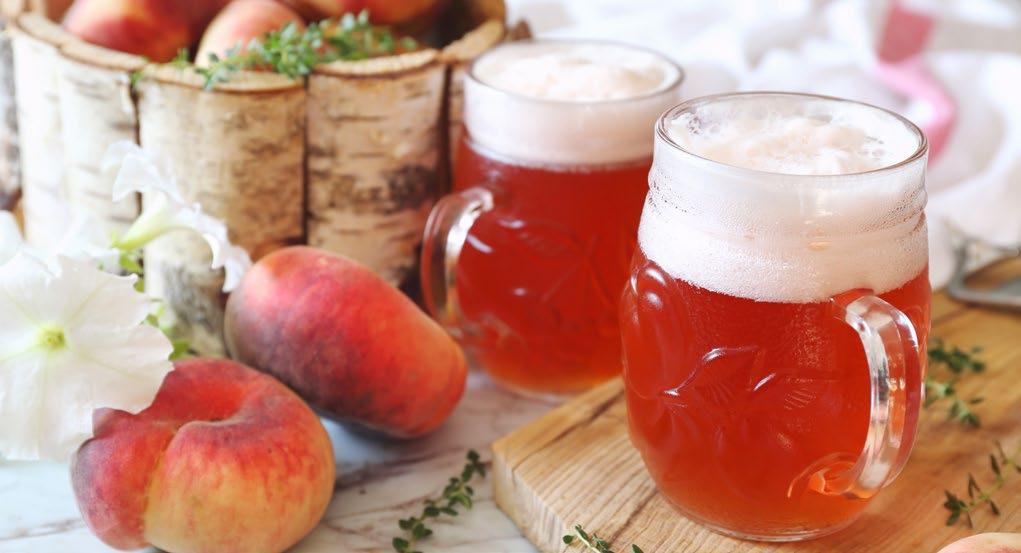
Natural flavours offer great flexibility as they can be added in at the end of the brewing process enabling brewers can make several different lines of beer by using the same base and then changing the flavour.
This allows brewers to add in seasonal or limited-edition flavoured beers to their ranges without additional cost or increased production time.
Natural flavours bring the depth and body back to the drink. We develop special flavours that can bridge the gap and make up for the loss of alcohol content - much of which is also concerned with mouthfeel. We also have a range of hop flavours that replicate popular hop profiles like Citra, Mosaic and Cascade.
These flavours help with both aroma and taste. We often find that hops are used to get different flavour notes, so sometimes it’s easier to pick the fruit that brewers try to find a hop to replicate. So, for example if a brewer is using Citra to give them citrus notes - we can also just use citrusprofiled flavours.
One of the biggest areas for growth is with lower alcohol beers, around the 2.5% mark. This type of product is a good ‘halfway house’ for those consumers who wish to really cut back on alcohol without cutting out completely, and appeal to a generation of drinkers with FOMO (fear of missing out).
It’s this ‘best of both worlds’ mindset that
MIKE BAGSHAW, FOUNDER OF FLAVOUR HOUSE I.T.S LOOKS AT THE MARKET FOR LOW AND NO ALCOHOL BEER AND THE ROLE THAT FLAVOUR CAN TAKE IN ENHANCING FINISHED PRODUCTS.
has helped fuel the popularity of Radlers for example and many brewers both large and small are looking at flavoured low alcoholic beverages as a perfect summertime refreshment. Lagers and pale ales at around 2.5% cut with citrus flavours such as lemon, grapefruit or pomelo are growing in popularity and widening the market for beer, especially among younger drinkers. Flavours can also bring those intense flavour notes to standard non-alcoholic beer that often disappear when the alcohol is taken out. In a recent review of low and no alcohol beers for the Telegraph, Simon Lewis talks about the ‘sour tang’, ‘fruity aromas’ ‘mango, ‘caramel and even gingerbread flavour notes across a range of low and nonalcoholic beers and it’s these flavours added to the dealcoholized product that give the indivduial brand their distinctive characteristics.
Some of the most interesting flavours coming through in low and no alcohol beer now sit under the tasty category of tropical.
This doesn’t just mean standard fruit punch, or pineapple – we’re talking the tropical flavours and flavour combinations that really stand out from the crowd. There’s a move away from intensely sweet flavours in low alcohol beer too as consumers expect the similar kind of complex flavouring from low alcohol products as from their alcoholic
equivalents. As well as innovative tropical flavours, it is also about what you can do with tropical flavours to help them stand out and give them that extra premium and indulgent twist such as Passionfruit & Thyme for example.
The beauty of adding flavour to low alcohol beers is that, technically it is relatively straightforward. Flavours are added post-fermentation to make sure there is no impact on the base beer flavour. This means that the base beer is brewed to a brand’s standard, dealcoholised and the flavour is added. It is important to carefully figure out the dosage rates and fine tuning the strength required of a certain flavour in the finished beer.


The challenge is staying ahead of trends in the market when it comes to flavours, being brave with flavours to make your low alcohol beer stand out in a fastgrowing market.

ALEX REDPATH IS A BRILLIANT BREWER AT A BRILLIANT BREWERY. HE ALSO HAS AN EXCELLENT WAY WITH WORDS. HERE HE TELLS US ABOUT HIS JOURNEY AND THE EVENTS THAT LED TO ONE OF HIS FIRST BEERS - RYE MEMBER ME.
I’ve always loved craft beer and the brewing process. Every trip away always included a brewery tour, so when the opportunity came up to experiment with home brew kits, I went all in.
Starting with four home brew kits; after the first kit, I was hooked.
Very soon having two on the go at the same time; it developed into an all-grain system consisting of an insulated coolbox mash tun and a big stainless pot for HLT/Kettle. I would brew twice a week and was desperate to learn, I gave away most of what I made just to empty an FV and brew something else.
I soon filled a spare room at my Dad’s house with FV’s, fermentation fridges, bottle/keg storage and everything else I could get my hands on.
It worked well, he got unlimited free beer and I had space to dedicate time to my new passion.
At the time, I was working with my Dad in a business we had set up together, whilst not something I was massively passionate about, it gave me the flexibility to brew for competitions and listen to podcast after podcast to learn as much as possible.
I had also dreamed of taking a course at Brewlab, a brewery training provider in Sunderland; I had picked out a course and thought about saving up over five years, and wondered where that could take me.
I loved homebrew competitions and entered as many as possible locally; I thought my beer was clean, consistent and
good quality.
I wanted instant feedback, positives, negatives and any comments I could use to improve my process, recipes and packaging.
I was fortunate to get 1st and 3rd in my first competition at the Newcastle BrewDog Homebrew Club and won several more competitions to have my beers brewed at local brew pubs. It’s one of these recipes that I’ve detailed overleaf, a Rye IPA.
Two days after I brewed the Rye IPA, I had what I can only describe as the worst day of my life. I walked into my Dad’s house to find he had passed away overnight.
I still remember every step, action and phone call that day, and it will never leave me.
The next couple of days were a bit of a blur, but I remembered that I still had a beer fermenting in his spare room, and I decided to dry hop, package and enter it as I’d always planned to; he would have hated beer going to waste! He had written in the past that if anything ever happened, to use Steve Earle - Remember Me, as his remembrance song; this seemed a very fitting inspiration for the name: Rye Member Me. After all the chaos and emotion of those few weeks, I got an email to say the beer had won and asking if I would come down to the brewpub to brew it.
These events made me realise how short life can be, so I signed up for the Diploma at Brewlab the next day. The rest is history!
I introduced myself to Ben Cleary at Brewlab whilst he was there getting some consultancy on opening a brewery and things went from there.
Before I knew it, I was employed as a development brewer, working side by side with Ben to develop the brand, business plan, location and a range of core beers.
I brewed on a 100L brew magic kit, producing 2 kegs per batch, which we sold through Ben’s bottle shop, The Pip Stop. This allowed us to get instant feedback from very picky customers, which helped tweak and develop final versions of the recipes that became Repeater, Hoop and our multi awardwinning IPA, Looper.
In 2019 we got the keys for a unit in Newcastle, and later that year, our SSV four vessel 30HL brewhouse turned up ready to
be commissioned.
Although it felt like a huge step up from 100L to 3000L, we developed great beer from day one. It still feels like utter chaos at times, I often suffer from imposter syndrome and worry somebody may realise that I don’t know what I’m doing. If you surround yourself with the right people everything will work out. We have managed to get through pandemics, Brexit, cost of living crises, wars and whatever else may happen to us, I look back at my home brewing processes and

Brewing Network - All shows
Master Brewers Podcast
James Morton - How to brew
Scott Janish - The New IPA
John Palmer - How to Brew
Greg Hughes - Home Brew Beer
feel that I still hold the same principles today. I would always keep my recipes simple and let the ingredients speak for themselves, rather than try and dial in every possible variable, keeping them consistent going forward.
Pitching rate, temperature, sanitisation, DO reduction, fermentation profile, DH rates, DH contact times and process, find what works for your beer and your kit, there’s always room to improve and innovate. If things go wrong, try to go back to your basics and make sure you get back to a beer you love before you experiment again.
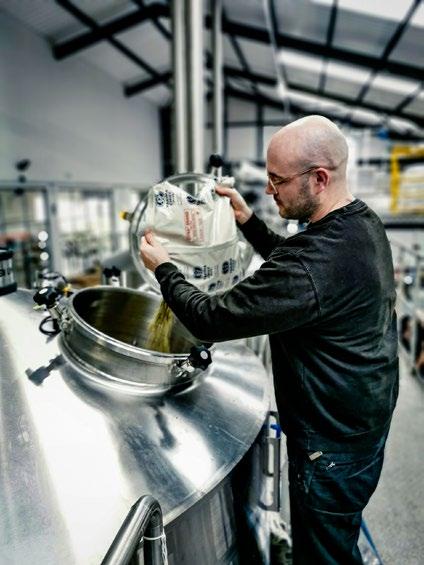
Most importantly, brew the beer you want to brew, if it’s a new style to you, find what you like from that style, what commercial beers you like or dislike in that category and what makes those beers unique.
On a final note, in 2021 we were lucky enough to win a tender in Sweden for a Rye IPA, which turned out to be a rebrew of Rye Member Me. It’s a moment that will always remind me that bad things do happen but it’s how you deal with them and move forward that makes you who you are.
It’s a moment that will always remind me that bad things do happen but it’s how you deal with them and move forward that makes you who you are.Alex Redpath, Full Circle Brew Co
AS ALEX EXPLAINS OVERLEAF, RYE MEMBER ME IS AN IMPORTANT BEER TO HIM FOR REASONS MUCH MORE THAN THE QUALITY OF THE LIQUID. HERE, HE SHARES HIS RECIPE AND PROCESS SO YOU CAN MAKE IT TOO.
6.4% ABV
SG 1.064
FG 1.012
If amounts are specified, it’s based on a 25L batch size
Malt Bill
72% Extra Pale (Crisp)
15% Rye Malt (Crisp)
5% Crystal Rye (Fawcetts)
5% Dark Munich (Crisp)
3% Chit Malt (Crisp)
Mash - 65c - 60min
Boil - 60 Min
Boil Hops
60min - Pahto (any bittering hop will do) - 25 ibu
Whirlpool - 85c - 20-30min
40g Mosaic
40g Simcoe
40g Chinook
Yeast
US05/WLP001
Dry Hop - 3 days then chill
150g Mosaic
150g Simcoe
Fermentation
Start at 18c, let it free rise to 20c, then after a few days raise to 23. Dry hop warm, then crash cool for a week if you can.
Water
For this beer, I went with a more west coast water profile, higher on the sulphate than chloride, to give the beer a crisper bitterness; a ratio of 2:1 should be ideal.
Equipment
You can make spectacular beer in a plastic bucket, you are better off investing in a homemade fermentation fridge and a small co2 set up for reduced oxygen pick up to package into a keg, but this beer will also suit bottle conditioning.
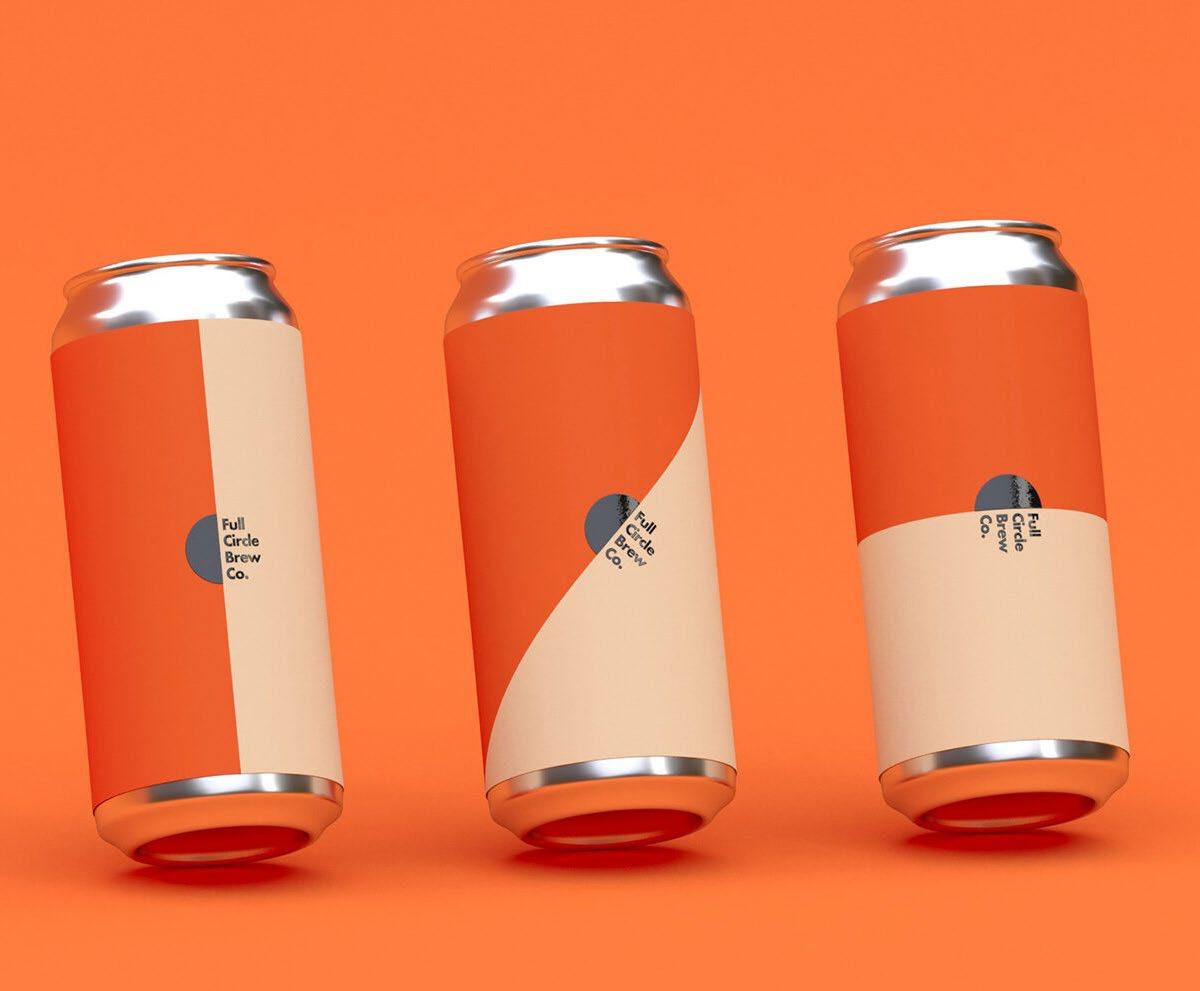
I’d suggest adding finings to this beer to help show off the beautiful colour of the Rye.





Left Handed Giant recently installed a 36 kilowatt solar PV system that is generating electricity for them at just 3p per kWh.



That compares with the 15p to 18p that most businesses their size are paying for power from the grid.
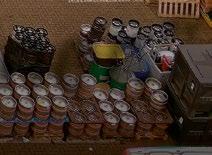
It’s not surprising that LHG’s Finance Director was so enthusiastic about it.

CleanEarth have done solar installations for half a dozen breweries in the past year or so. Between them they will see savings of more than £1.2 million over the next 25 years. They’ll also prevent nearly 1,500 tonnes of CO2 from entering the atmosphere.










Callum’s right. From both the environmental and the financial perspective it’s a complete no-brainer.
Free site survey and energy audit







Call Ed Lennon on 01208 895576
cleanearthenergy.com



 Callum Bickers, Left Handed Giant
Goodh Brewing Co Ludlow Brewing Co Moor Beer Verdant Brewing Co Wiper & True
Callum Bickers, Left Handed Giant
Goodh Brewing Co Ludlow Brewing Co Moor Beer Verdant Brewing Co Wiper & True
FINING BEER IS BOTH A SCIENCE AND AN ART, REQUIRING CAREFUL CONSIDERATION OF INGREDIENTS, TECHNIQUES, AND PERSONAL PREFERENCES, EXPLAINS ROBERT NEALE OF THE MALT MILLER
Beer has been enjoyed by people around the world for centuries, and its appeal lies not only in its taste but also its appearance. One key element that contributes to the visual allure of beer is its clarity.
Achieving clarity in beer involves a process known as fining, which helps remove unwanted particles and haze, resulting in a beautiful, crystal-clear brew. Here, we will explore the art of fining beer, discussing the importance of clarity, various fining agents, and the techniques employed to enhance both the appearance and flavour of your homebrew. Understanding the importance of clarity : Clarity in beer is more than just an aesthetic preference. It is a sign of quality and attention to detail. A visually clear beer allows the drinker to fully appreciate its colour, carbonation, and lacing. Furthermore, clarity can influence perception of flavour, as a hazy beer may give the impression of being unfinished or unfiltered. Thus, achieving clarity is essential for both commercial breweries and homebrewers aiming to produce exceptional beers.
The role of fining agents : Fining agents are substances used to help clarify beer by removing unwanted particles suspended in the liquid. They work by either binding to the particles or causing them to settle, making it easier to remove them. Common fining agents include Irish moss, gelatin, isinglass, and silica gel. Each agent has its own unique properties, and the choice of fining agent depends
on factors such as beer style, personal preference, and dietary restrictions. Techniques for fining beer: The process of fining beer can vary depending on the desired clarity and the type of fining agent being used. Here are some common techniques employed by brewers: Cold crashing: This method involves rapidly cooling the beer after fermentation, causing the particles to settle at the bottom of the fermenter. Cold crashing is often used in combination with other fining techniques.
Fining agents: Once the beer has been cooled, fining agents can be added to the fermenter. Each fining agent has its own instructions regarding dosage and timing, so it’s crucial to follow the manufacturer’s recommendations.
Racking: After fining agents have been added, the beer is gently transferred from the fermenter to a secondary vessel, leaving behind the settled particles. Care must be taken not to disturb the sediment during this process.
Aging: Allowing the beer to age for a period after fining can further enhance clarity and flavour. During this time, any remaining particles will continue to settle, resulting in a cleaner final product.
Achieving clarity in beer can sometimes be challenging, and a few factors may affect the outcome. Factors such as high protein content, excessive dry hopping, or certain yeast strains can make it difficult to achieve the desired clarity. If clarity issues persist, alternative fining agents or techniques can be explored, or a combination of multiple agents can be used to address specific problems. It’s important to note that while fining agents are effective in clarifying beer, they may not be suitable for all beer styles or personal preferences. Some beer enthusiasts appreciate the haze in certain styles, such as New England IPAs or Hefeweizens, as it can contribute to the overall flavour profile. In these cases, omitting or reducing fining agents might be appropriate. In conclusion, fining beer is a science and an art, requiring careful consideration of ingredients, techniques, and personal preferences.
By understanding the importance of clarity, selecting appropriate fining agents, and employing the right techniques, brewers can display their beer in exactly the way intended.




www.enterprisetondelli.co.uk info@enterprisetondelli.co.uk

Realtime fermentation gravity and temperature monitoring with graphing, optional remote temperature control and our new CO2 purge device.
www.dotmatix.net
020 3475 1420

Gravity Systems was formed to meet the growing demand in the craft beer market for a single source for all brewhouse, fermentation, services generation and distribution. www.gravity-systems.co.uk

+44 (0)1733 834264 enquiries@gravity-systems.co.uk
www.bestmalz.com

PakTech designs and manufactures 100% recycled, recyclable and reusable packaging handles. PakTech is the smart and sustainable packaging solution.
www.paktech-opi.com
handlesales@paktech-opi.com
Phone: +1.541.461.5000
www.carlingpartnership.com

+44 (0)1483 893 100
YEAST
Est 1809
www.fawcett-maltsters.co.uk
+44 (0)1977 552490 sales@fawcett-maltsters.co.uk
www.lallemandbrewing.com

+44 (0)7930 451687
Since 1774, Rankin continues to supply reliable closures that help seal, protect and add value to your brands.
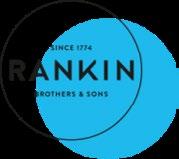
www.rankincork.co.uk
sales@rankincork.co.uk
+ 44 (0)1844 203100
www.simpsonsmalt.co.uk

+44 (0)1289 330033
www.galxc.co.uk

+44 (0)23 8086 7168
We supply the finest quality kegs & casks in the world, manufactured to the highest industry specifications. We provide 50 litre kegs, 30 litre kegs, 4.5 gallon Pins & 9 gallon Casks.
www.keglogistics.com/united-kingdom

+44 (0)7734 035562 SHorrox@keglogistics.com
Fermentis is an expert in the art of fermentation. Our active dry yeasts and yeast derivatives cover almost all professional requirements: from safeguarding production to expressing sensory characteristics.
Discover our products on www.fermentis.com
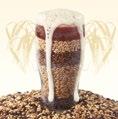
Contact us at fermentis@lesaffre.com


